The best time to go to Norway in 2024
Mar 18, 2024 • 5 min read

The best time to visit Norway will depend on what you want to do when you get there © Everste / Getty Images
Norway is known for its spectacular landscapes and, as one of the most beautiful countries on the planet, there's no such thing as a bad time to visit.
However, certain seasons will impact the many big attractions and experiences on offer – prioritizing what you want to do and understanding these seasonal differences will be key to planning your trip.
Summer is the most popular time to visit: it has the best weather, long hours of daylight, prices are generally cheaper and everything’s open. Winter is a magical and popular time to visit if you’re on a quest to see the northern lights. And for those looking to follow their own path along quiet roads to find a Norway stripped of all tourist hype, spring and autumn may be for you.
Here's everything you need to know about picking the best time to visit for your trip to Norway .
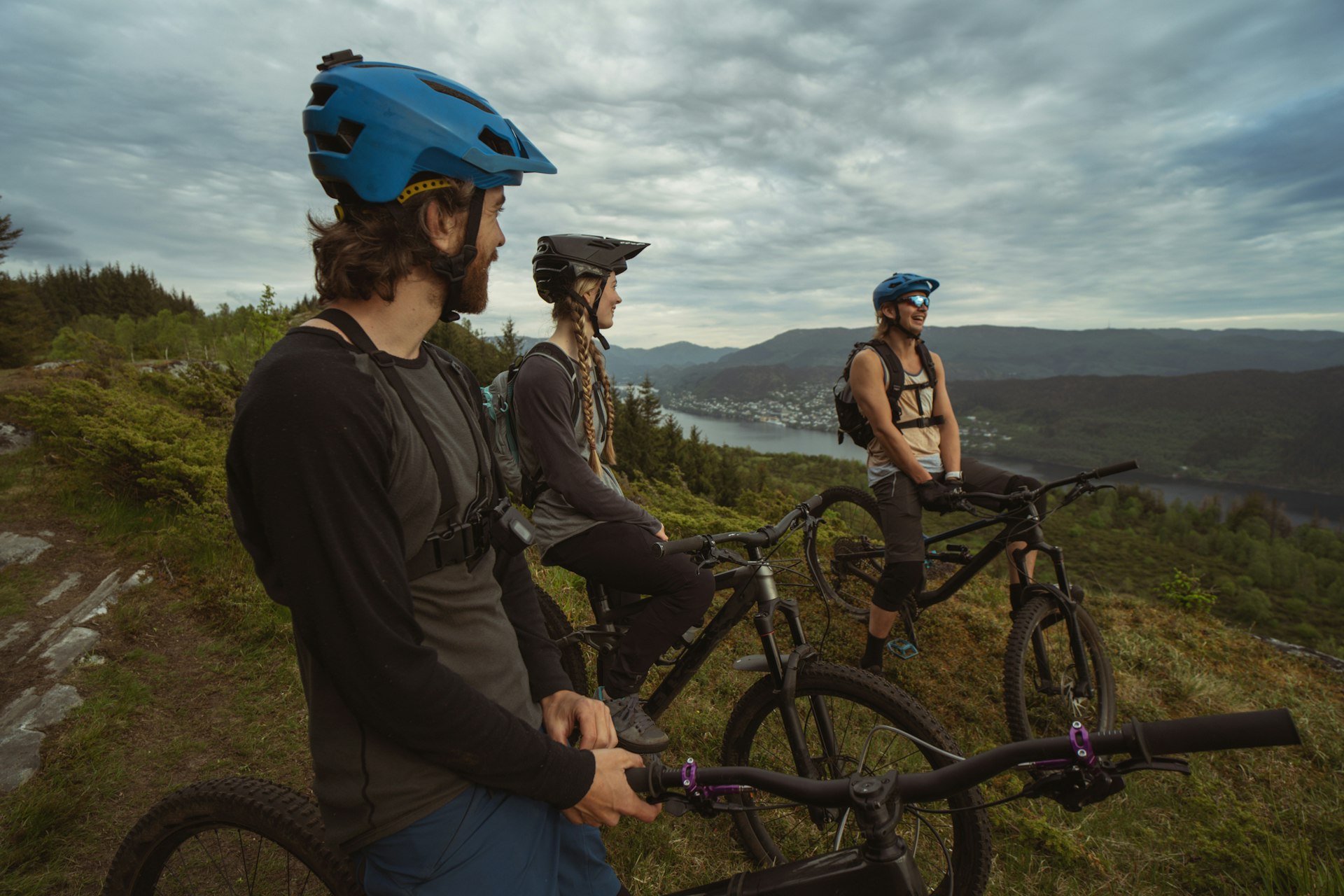

June to August is the best time for good weather and cheaper prices
There is no better time to visit Norway than in summer. Let’s start with the weather. This being a Scandinavian country with much of its territory within the Arctic Circle, we can’t guarantee sunshine every single day, but from June to August, clear, mild days with a piercing blue sky are the norm. This is the best time to see the fjords, the Lofoten Islands or Svalbard at their most pristine and glorious.
Summer days here seem to last forever: north of the Arctic Circle, there is at least one day every year when the sun never sets. The further north you go, the more of these days you get. Even in Norway’s south, there’s no such thing as complete darkness throughout summer as the sun’s light from just below the horizon bathes the night hours in a sepulchral glow.
Summer is, of course, high season in Norway. This can mean that everything – from all roads and campgrounds to tourist attractions like boat cruises on the fjords – gets busy. This is also when most of the festivals happen, and when the majority of locals take to the roads. But traveling at this time comes with an unexpected bonus: unlike high seasons just about everywhere else, high season in Norway means cheaper accommodation prices. While this may sound counterintuitive, the reason is simple: Norway is one of the most expensive countries on earth, and the only people traveling at other times are business travelers on expense accounts. In other words, prices drop so that tourists can afford to travel.
There is one further advantage to traveling in Norway in the summer. For much of the year, Norway’s wild landscapes are susceptible to the kind of unpredictable weather you just don’t want to get caught up in. With that in mind, the hiking season only runs for the three summer months every year. It’s also the best (and, in some cases, the only) time for cycling, white-water rafting and whale-watching off the coast of Vesterålen .
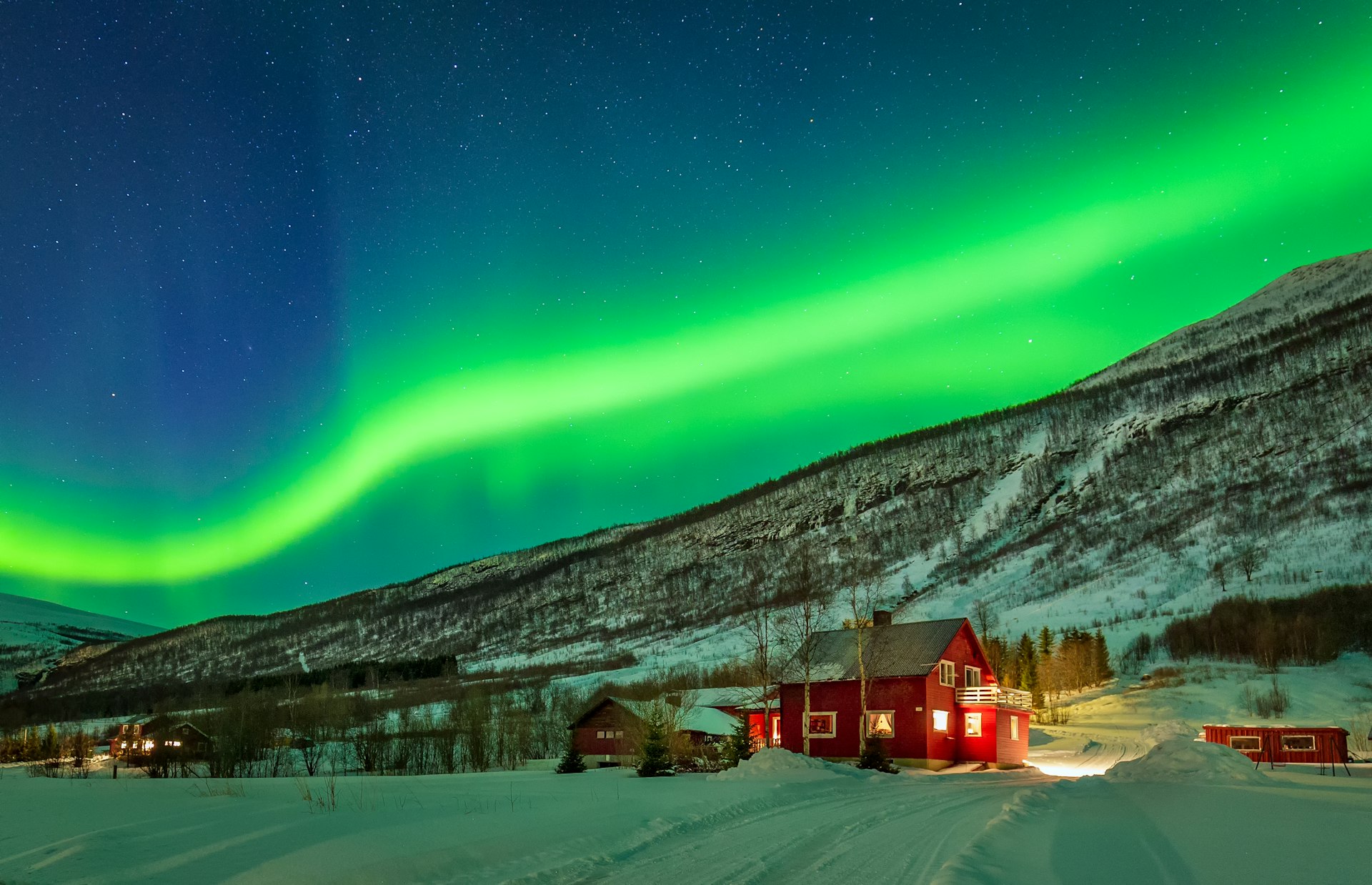
December to February is the best time for the northern lights
Summer may open up a whole world of possibilities but the Norwegian winter has a special (and increasingly popular) call all its own. This is the time of year when the northern lights dance across the sky in great curtains and cascades of shape-shifting colored light. Truly one of the natural world’s greatest spectacles, the aurora borealis happens year-round, but Norway’s long winter nights provide the perfect conditions in which to see them.
Yes, you need clear skies, which is never something that can be guaranteed in the depths of a Norwegian winter. And you never quite know when or where they’re going to appear. But when they do, it’s the kind of experience that lingers in your memory with all of the magic of a fairy tale coming to life.
Winter is also when the polar night descends upon the country, casting it into darkness for months at a time; the sun doesn’t even appear above the horizon from late October to mid-February in Svalbard’s Longyearbyen . But seeing the country at this perspective-altering time can be almost as memorable as seeing the northern lights. If you’re lucky, you’ll experience both.
When the sun is shining in winter, as it does surprisingly often wherever daylight occurs, the snows that cover much of the country transform Norway into a land of singular and spectacular beauty. Even in the iciest conditions, most of Norway’s roads remain open throughout winter, and elsewhere Norwegians take to the paths – whether to the local shops or out into the wilderness – on cross-country skis. If you’re not inclined to join them, there’s always dog-sledding, ice hotels and snowmobiling for those looking to immerse themselves in Norway’s frozen winter world.

March to May and September to November are the best times for quiet roads
With so much going on in summer and winter, Norway falls relatively quiet during the spring and fall months. And therein lies the appeal of visiting at this time. Beyond city limits, Norway’s roads are quieter by a near-exponential magnitude. It’s also easier to come by your favorite hotel booking, while weekend accommodation prices can be the same as those seen otherwise only in summer.
If you time your visit right and visit in late spring (May, for example) or early autumn (September), you might also enjoy some of the benefits of summer – cheaper hotels, hiking trails still open – but without the crowds to share them with.
And yet, perhaps the greatest benefit of traveling at this time is something less tangible. In many ways, this is an ideal time to observe Norway, to look through a window into the world of local life as it goes quietly about its business. It can be a far (and deeply satisfying) cry from the world of busy tourist attractions and carefree summer months.
This article was first published Apr 7, 2021 and updated Mar 18, 2024.
Explore related stories
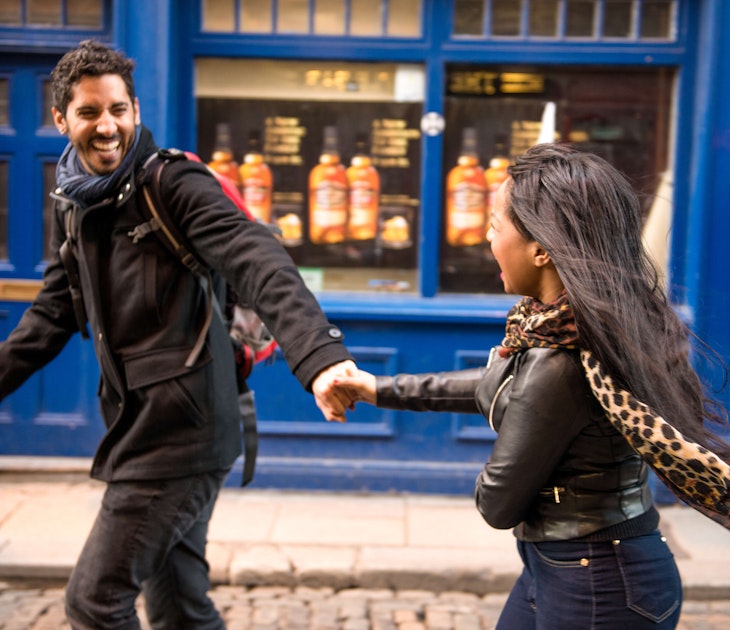
Destination Practicalities
Mar 30, 2024 • 4 min read
Who wouldn't jump at the chance to visit the Emerald Isle? Here’s how to check if you need a visa before setting off on your Irish adventure.
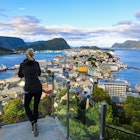
Mar 20, 2024 • 8 min read
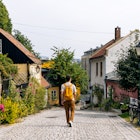
Mar 18, 2024 • 6 min read
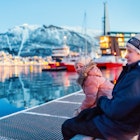
Mar 14, 2024 • 8 min read

Jan 19, 2024 • 11 min read

Dec 27, 2023 • 8 min read

Dec 1, 2023 • 6 min read
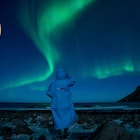
Oct 27, 2023 • 5 min read
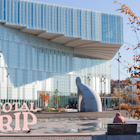
Oct 24, 2023 • 9 min read

Aug 3, 2023 • 7 min read

The Best Time to Visit Norway Explained (Pros and Cons of Each Season)
The climate in Norway changes a lot between each season, and a visit in the middle of summer will be a very different experience compared to a visit during the winter. So when exactly is the best time to visit Norway?
The best time to visit Norway depends on what you want to do. If you want to experience the hiking trails, natural wonders, tourist attractions and warm weather, summer or early autumn is best. If you instead want to experience the amazing skiing opportunities, the northern lights or the cold snow, winter is the best time.
Some people also prefer the shoulder season in spring or autumn due to cheaper prices on accommodations and less crowds at the tourist attractions.
So before you plan when to visit Norway, you should ask yourself what exactly you want to experience when you are visiting. Let’s take a closer look at what each season in Norway is like to make your choice a bit more well-informed.

Spring in Norway: Sunny, but chilly days with snow in the mountains
We regard March, April and May as the official spring months in Norway , and this is actually a very nice time to visit.
Some of the benefits of visiting during the spring is that you will be able to experience all the good thing about the winter by going up to the mountains, while the lowlands will be more temperate, and you can safely be outside without freezing too much.
The weather in spring can be very changing , from sunny and 15 C one day to close to freezing degrees and lots of rain the next. The early spring can also have some snowfall, but this will usually lead to lots of melted snow, and not a real layer of snow that covers the ground.
The farther north you are, the more like winter the spring will feel like. Places like Tromsø or Lofoten is still very wintery in March and April, and will have plenty of snow cover.
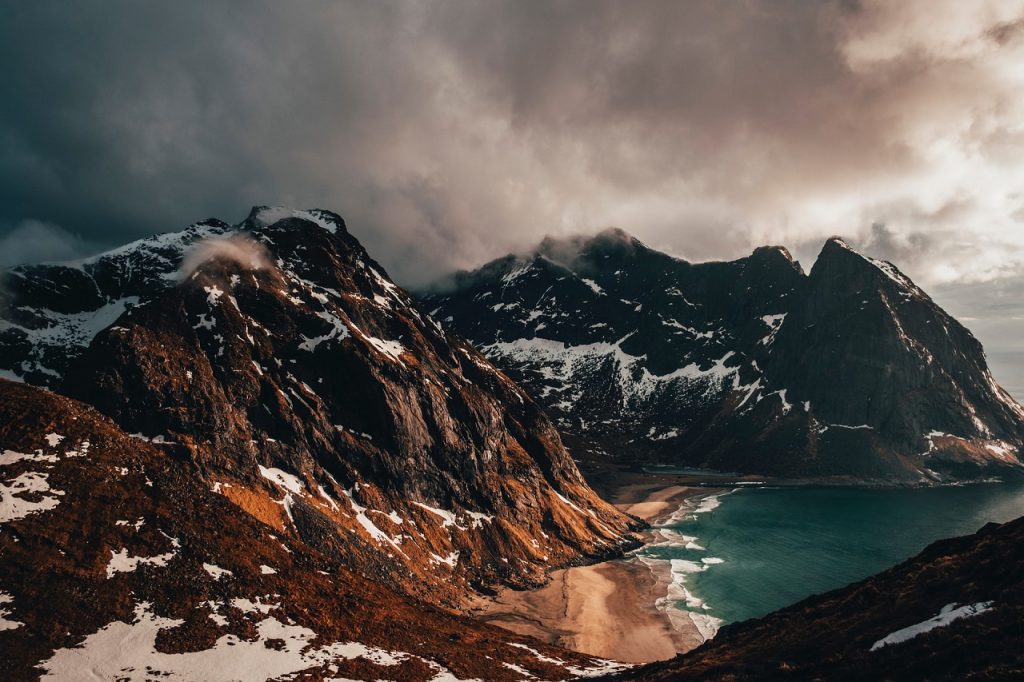
If you want to go skiing or take a hike in the snow, go to the mountains to designated skiing villages like Geilo or Valdres. There are plenty of places with snow during early spring, and there are many different skiing villages where you can go skiing until pretty much the start of summer.
You will need to bring warm clothing if you visit Norway during the spring , but if you’re lucky you might not need to use your jacket at the middle of the day. Be aware that it tends to rain a lot during spring, so always bring waterproof shoes and a waterproof jacket with you.
The end of spring will also include May 17th, the national day in Norway . This is a very cool and unique experience where you get to see a completely unique part of Norwegian culture. This 1-day event is a huge celebration that you are guaranteed to remember for the rest of your life !
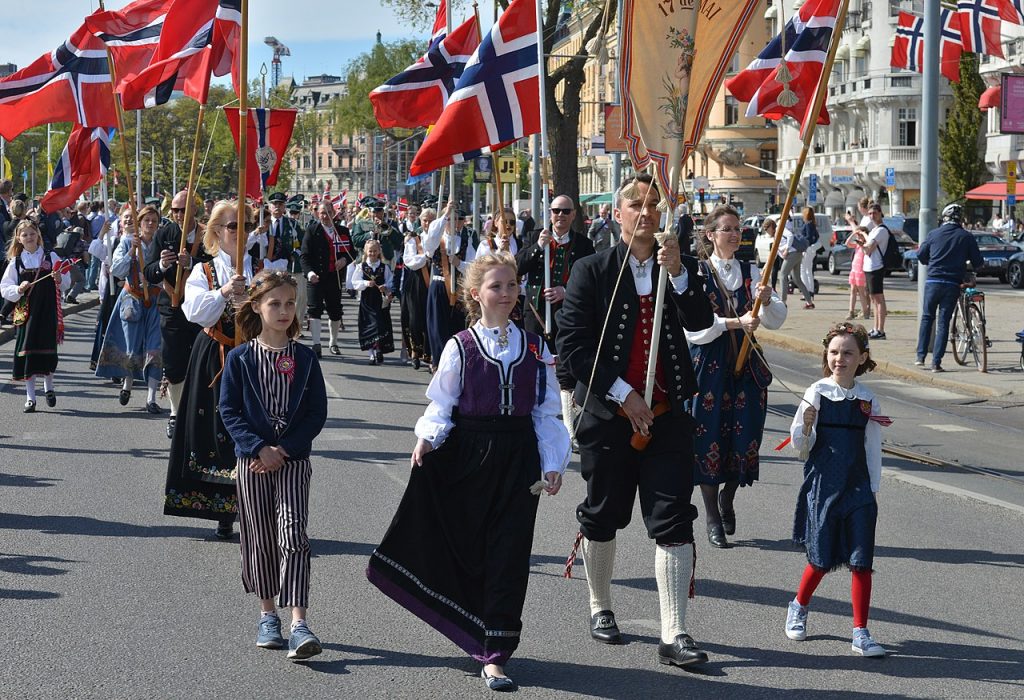
Some of the downsides to visiting Norway during the spring is that there is still a lot of snow in the mountains, and most hikes are pretty wet to say the least. You might not be able to use all the hiking trials just yet, but many of them will be ready, especially later in the spring.
You will generally not be able to complete hikes like Pulpit Rock, Trolltunga or Kjeragbolten without special hiking equipment in the early spring, since there will be many areas with partial snow or ice cover.
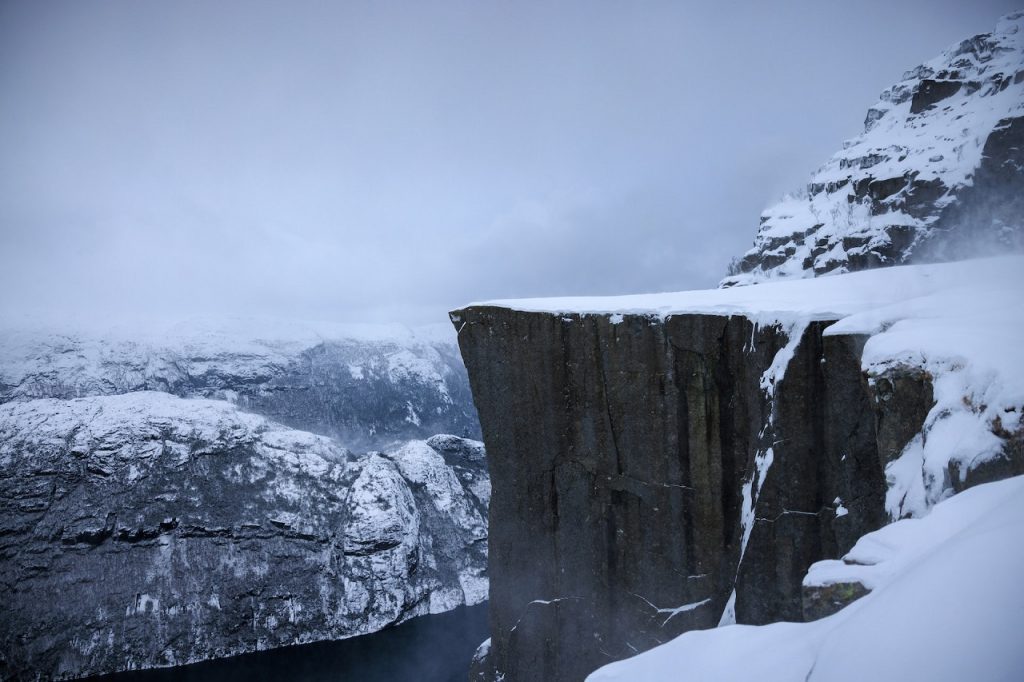
Summer in Norway: Norway’s High Season
I love the Norwegian summer, and I would advise everyone to come to Norway during the summer. The temperature is usually pretty warm in the early 20s (70 F), so it’s not too warm, but also not too cold.
The summer in Norway allows you to do most of the common tourist stuff, and it is the most popular season for both Norwegian and foreign tourists . All the hiking trials are open, and many things like museums and zoos are only open during the summer. This allows you to do most of the things Norway has to offer.
It is also possible to swim at the beaches during summer , and the water can reach pretty nice temperatures. There are many good beaches in Norway, and it’s definitely not too cold for a day at the beach when the sun is out.

The summer allows for camping in the wilderness, long days with a sun that never sets, swimming in the fjords, or going on hikes to natural wonders.
All the incredible Norwegian waterfalls like Vøringsfossen or Kjosfossen are at their best behavior with the most water flowing, so they are all worth stopping by.

If you want to experience the snow, skiing or things like that, then the summer is obviously not your best choice. There might be a few areas with snow if you go hiking up high in the mountains, but most of Norway is completely free of snow during the summer.

Autumn i Norway: A bit chilly, but absolutely beautiful
The autumn start at the beginning of September, and this marks a pretty big change in the Norwegian weather. The warm summer evenings will quickly be changed into cold gusts of wind that makes the air very refreshing and nice .
You will have to bring a jacket with you for most of the autumn, but there are occasionally hot days as well where you can enjoy the autumn sun. If you don’t mind the chilly air, a visit to Norway in the autumn can make for some incredible experiences!

I would say that early autumn is a good time to visit Norway . Most Norwegians are back at work, school has started for the children, but the weather is still pretty nice, and you can still experience most of what Norway has to offer, but with many fewer tourists, so it won’t feel as crowded.
Some of the downsides to visiting at autumn is that there is a lot of rain , and you might get very unlucky and get 4 -5 days in a row with heavy rainfall.
Norwegians typically know how to dress for these autumn days, so take a look at what they wear, and try to copy it. You will want to always bring some extra clothes , because the weather can get from nice and sunny to cold and rainy very fast!
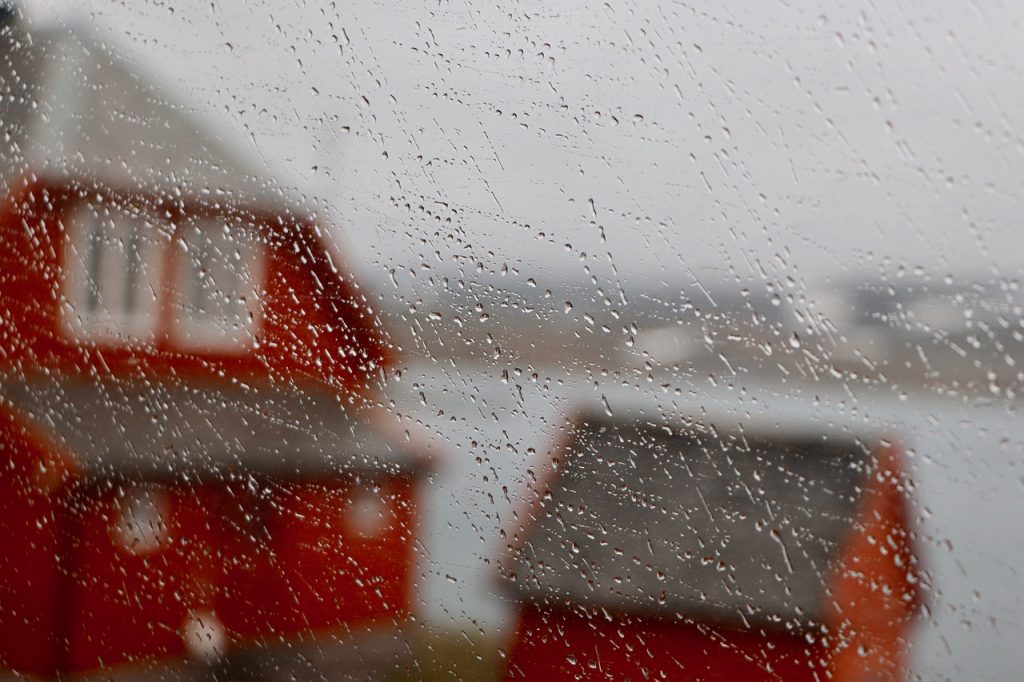
It is usually not very snowy in most parts of Norway during the autumn, and there might not be much real snowfall until late November . Last year’s snow has long since melted, and it’s bare in most of the country. So autumn is terrible choice if you want to go skiing.

Winter in Norway: The Incredible Winter Wonderland
The winter in Norway is unique, and a very different experience for people that are used to living further south . Many people think of Norway as a frozen wasteland, and this might be somewhat true during the winter, especially in northern Norway.
If you visit Norway between December and February, expect a lot of snow, cold weather and icy roads . The days will be very short, and there are only a few hours of daylight at the middle of winter.
It’s generally pretty difficult to drive in the winter with the icy roads, so make sure to bring your winter tires , and be prepared for convoy driving and even closed roads.
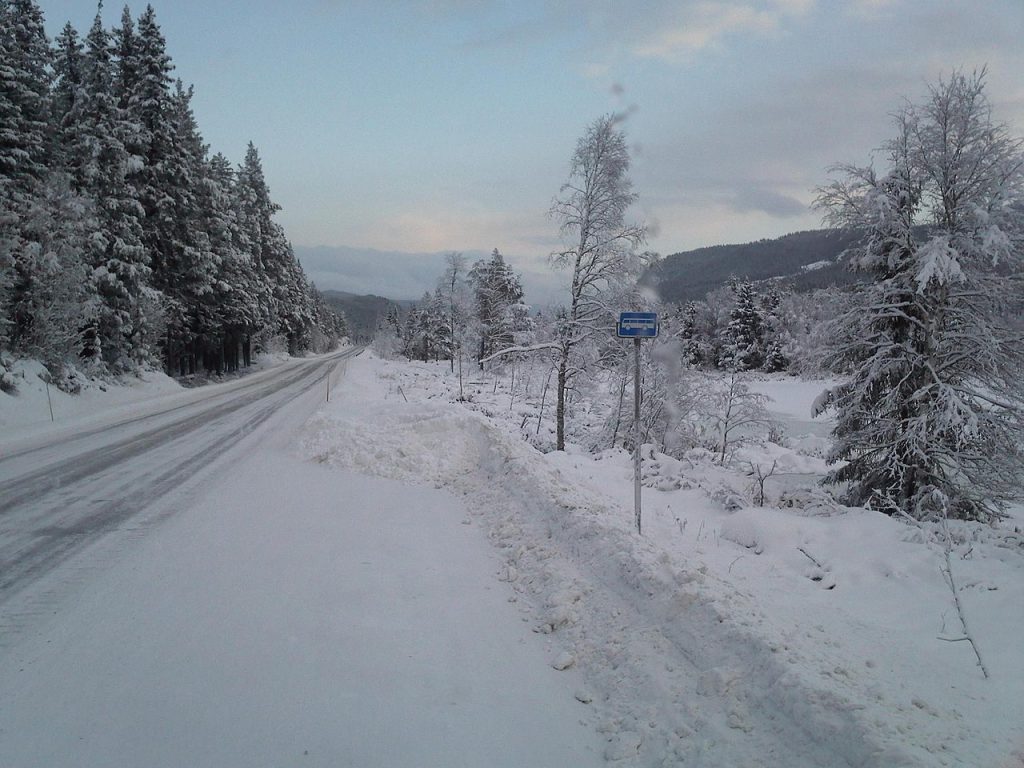
In the far north, there it no sun at all during the winter months. This phenomenon is known as polar nights , and the middle of the days are still covered by darkness. It’s not exactly pitch black in the middle of the day, but it’s more akin to dark twilight.

Visiting Norway during the winter can be a great experience, but tourists tend to bring less clothes than they need. You will need to wear wool under your clothes on cold days if you want to spend time outside .
The temperature can vary very much. Some days the temperatue might linger around 0 degrees, but certain days might be super cold even in places like Oslo . Be prepared for temperatures as low as -20, even though they are pretty rare in the lowlands in the southern part of Norway.

Towns in the mountains, such as skiing villages, will usually see many days with -15 to -25 degrees, so make sure to bring enough clothes if you are going to visit these places during winter.
If you enjoy skiing, then the winter is obviously a good time. Most parts of Norway will be covered in snow during the winter , but there might be certain times when a hot weather streak melts the ice.
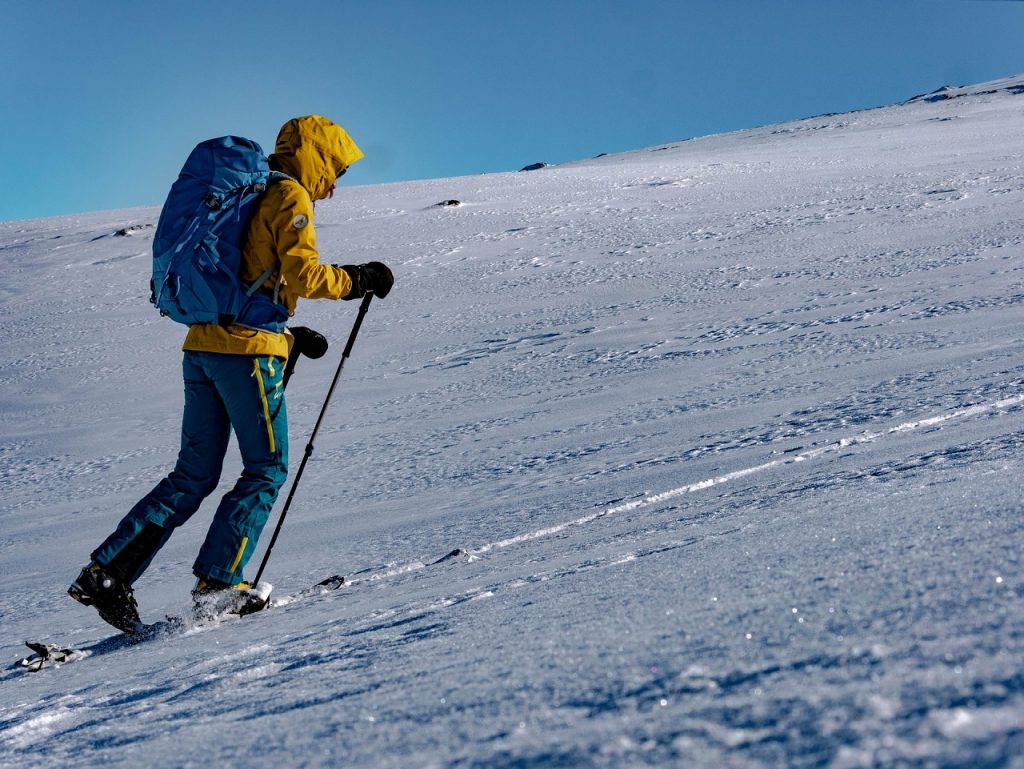
January is generally the best month to visit if you want to experience a lot of snow. And the further north you go, the colder and more snowier does the winter get.
The downside to visiting during the winter is that the lack of sun can make it a bit boring, since you only have a few hours to actually see stuff . This makes it difficult to see some of the natural wonders of Norway, and it can feel pretty boring to travel from place to place since it will usually be dark outside.

Norwegian people also tend to be a little less open to tourists during the winter . People often spend most of their time inside, and don’t really care to stop for a chat outside when it’s cold. So you might feel that people are less open than they are otherwise.
Winter events in Norway
The Christmas Celebration is a big thing in Norway, and takes up pretty much all of December . The first 3 weeks are often super busy for Norwegians, and you will see huge crowds of people shopping, so all the city centers and shopping malls are bustling with life.
There will be lots of Christmas events in all of December, which can be a unique experience that is worth checking out. Christmas decorations will fill up most public places.
The actual celebration begins around December 21 – 23, with the main celebration being on Christmas Eve on December 24.
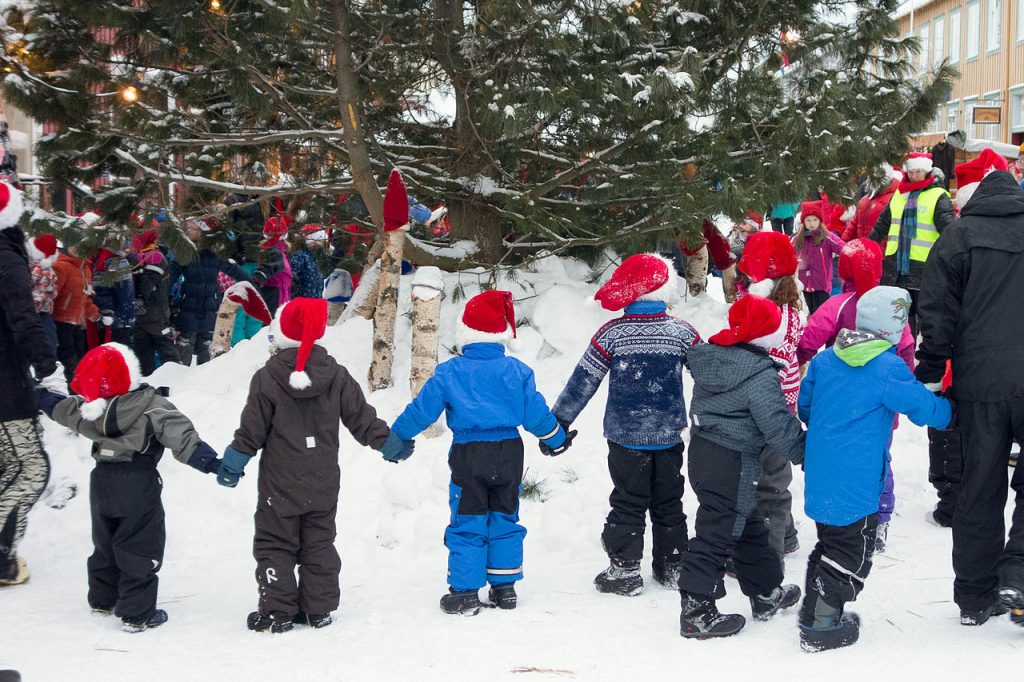
Not only will the Christmas Celebration affect your daily activities as a tourist, but you should also be aware that most shops are closed during the public holidays during Christmas . The same goes for museums and many tourist attractions, so the last two weeks in December will severely impact your visit.
At the same time, it’s something magical about visiting Norway during Christmas , so it’s both a pro and a con.
So when’s the best time to visit Norway?
It is worth keeping in mind that this is only a general summary of each season, and there will obviously be big variations from place to place and from year to year .
I would argue that there is no «best season» for visiting Norway , and each season has both pros and cons. Choose whichever suits you the best, depending on how well you are at dealing with the weather.
Frequently asked questions about the best time to visit Norway
When is the best time to visit norway.
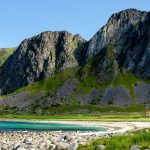
When the best time to visit Norway is truly depends on what you want to do. That said, most tourists visit during the summer. This is when all tourist attractions are open, the weather is at its best, and places like Lofoten, the big cities, the fjord regions and the hikes are most beautiful and accessible.
When is the best time to visit Norway for seeing the northern lights?

The best time to see the northern lights in Norway is during the winter. Anytime from late October to early April has a chance of having the aurora borealis, but the main northern lights season is in December to February .
You will want to travel pretty far north to a city like Bodø, Alta, Tromsø or the North Cape to have a decent chance of seeing the aurora, even though it’s possible to catch the northern lights in Oslo a few times each winter .
When is the best time to visit Norway for snow?
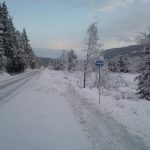
The best time to visit Norway to be guaranteed snow is December to March for northern Norway or in mountain regions , or January to February for anywhere in the lowlands south of Trondheim .
There will usually be snow outside of these time periods as well, but it’s not guaranteed since the days in March can have really warm weather that melts the snow (temporarily) in southern Norway.
When is the best time to visit Norway for seeing the fjords?

If you’re coming to Norway to see the incredible fjords on the western coast, then you want to visit in summer . This is when the fjords are at their best, and there are no less chance of roads being closed due to weather. Many hotels, campsites and attractions near the fjords are only open during the summer season.
The spring and autumn season are also pretty amazing, but they have a high chance of raining. And when it rains it pours in western Norway, so bring waterproof clothing and your umbrella if you’re visiting the fjords in spring or autumn.
When is the best time to visit Norway for a road trip?

The best time to visit Norway for a road trip is probably in the late spring, summer or early autumn. This is when the roads are best to drive, and you can freely drive in the country without having to fear roads that are closed due to storms, winter closed roads, convoy driving or icy roads.
Many roads, including famous tourist roads like Trollstigen, are not open at all during winter or early spring before the snow melts .
When are most tourists visiting Norway?

Norway’s main tourist season is in the middle of summer in June and July . This is true for both international tourists as well as Norwegian tourists. August is fairly popular as well, but not as popular as June or July is.
When is it cheapest to visit Norway?
The cheapest time to visit Norway is generally in the shoulder seasons in early spring or late autumn .
Leave a Comment Cancel reply
Save my name, email, and website in this browser for the next time I comment.
The Best Time of the Year to Visit Norway
When to go to Norway is a common question among first-time Norway travelers. The best time to go to Norway suitable for most travelers is early summer, especially the months of June and July. The weather is pleasant and the days are long however it is also peak season. The other seasons offer plenty to do, though it can be cold and days are very short.
Compared to some of its Northern neighbors, Norway's weather is quite mild. That's because of the Gulf Stream which gives it a temperate climate, however temperatures can vary wildly depending on where in Norway you are. More northern areas can have temperatures reaching into the 80s Fahrenheit (27 degrees C) during the summer and some of the snowiest winters. Generally speaking, Norway experiences four seasons with cold winters and mild summers. For more detailed informations, read our guide to the weather and climate to Norway .
Tourist Attraction Availability in Winter
Many major outdoor attractions, including some mountain hiking paths, are closed in the winter. The large amounts of snow coupled with cold conditions make it dangerous for people to visit. If there are trails or outdoor sights you especially want to see, look up the closure schedule before booking your flight. Whatever you do, do not ignore closures and posted warnings. They're there for your safety.
Peak Season in Norway
The summer is Norway's peak season. The weather is nice and the longs months of darkness are broken with almost constant daylight. Because of that expect lines at popular attractions to be longer. Accomodation and flights will also likely cost more. To get the best of both worlds, plan your trip for late Spring or early fall. May and September are wonderful alternatives for when to go to Norway and get lower rates, and the weather in Norway will still be mild enough for outdoor activities and sightseeing.
Even though it's spring the weather will still feel like winter. Don't expect temperatures much higher than 40 degrees F (4 degrees C) though days are starting to get longer. Ski season also stretches well into spring with resorts open as late as April. In May it's warm enough to enjoy the outdoors and summer tourists haven't started arriving yet.
Events to check out:
- The biggest literary festival in the Nordic region happens every May in Lillehammer. Celebrating its 25th year in 2020 the festival has readings, concerts, exhibitions, and more.
That's the time of the Midnight Sun , so you'll get very long days in southern Norway or even sunshine around the clock in northern Norway. And with the warm weather, there are many things to do and places to go in Norway. You can hike the mountains, explore the fjords, or get to know the country's cities. The months of June and July are also the time for Norway's highest tourism levels, so while all sights and attractions will be open, you will see some tourist crowds.
- See short films from Norwegian and international filmmakers at the Grimstad Norwegian Short Film Festival in June.
- Adventurous travelers flock to Voss in late June for a week of extreme sports at Ekstrem Sport Veko .
Fall is the ideal time to visit for travelers looking to save money. The weather is starting to cool off but hasn't reached the winter lows yet. Fall is also a shoulder season as summer is over, but the ski season hasn't started yet. As such lodging and flights are cheaper in fall than in other seasons however popular outdoor attractions have begun to close. If you're traveling to Norway to see some natural beauty, time your visit for September when the weather is still mild enough for sightseeing. Northern lights season begins in October.
- Jazz lovers should head to Lillehammer for the DølaJazz Festival in October for performances from local and foreign musicians.
Days are very short in the winter, lasting only 5 or 6 hours. However the upside to the short days are the ample opportunities to see the Northern Lights. Winter can also be bitterly cold. Much of the country will be covered in snow so if you don't like the cold stuff, visit during a different time. Avid skiers and snowboarders can start hitting the slopes as early as November. Besides hunting for the Northern Lights, expect to spend time doing indoor activities like exploring a museum or two or catching a live show.
- The Tromsø International Film Festival is the country's largest and it takes place each January. In 2019 more than 60,000 films were submitted. Also because of the short days, films can be screen outdoors.
- Stay in Tromsø to enjoy music of all genres, stage performances, lecutures, exhibitions and more at the Northern Lights Festival from the end of January to February.
- Bundle up and head to the Ice Music Festival in Finse on Feb. 7 and 8. Celebrating 20 years in 2020 this festival features music played entirely on instruments made from ice.
The Best Time to Visit Spain
Weather in Iceland: Climate, Seasons, and Average Monthly Temperature
The Best Time to Visit Cape Town
The Best Time to Visit Boston
The Best Time to Visit Marseille
Weather in Norway: Climate, Seasons, and Average Monthly Temperature
The Best Time to Visit France
The Best Time to Visit Morocco
The Best Time to Cruise Alaska
The Best Time to Visit Johannesburg
The Best Time to Visit the French Riviera
The Best Time to Visit Sweden
The Best Time to Visit Macao
The Best Time to Visit Iceland
Scandinavia and the Nordic Region: Planning Your Trip
The Best Time to Visit Finland
Thanks for visiting nordicvisitor.com! For the very best browsing experience on our website, we urge you to upgrade to the most recent version of your browser . Some of our site features may not function properly on older versions.
- Travel Update
- Search Suggested Results View All Results
- EUR (€)
- GBP (£)
- Self-Drive i
- Privately Guided i
- Guided Small Groups i
- Northern Lights i
- Honeymoon & Romance i
- Ice & Snow Hotels i
- Multi-Country Tours i
- All Travel Styles
- Show all tours
- Best Sellers
- Special Offers
- Scandinavia
- Switzerland
- United Kingdom
- Book With Confidence i
- Why book with us i
- Booking Terms i
- Sustainability Policy i
- Manage Booking
- Privacy policy
Iceland Bíldshöfði 20 110 Reykjavík +354 578 20 80 View Map
Sweden Scotland View Details
When is the Best Time to Go and Visit Norway?
When planning a Scandinavian getaway you might find it important to know when is the best time to visit Norway. The truth is that this beautiful Nordic nation is a worthy travel destination year-round, so it’s hard to go wrong!
Having said that, each season has its own unique benefits. The summer is perfect for fjord cruises and road trips. The winter is the ideal time to spot the northern lights and take part in snow-based activities.
To learn more about the best time to go to Norway, read this guide to the 4 seasons followed by our travel experts’ answers to frequently asked questions.
You’ll know what to expect at each time of year, what activities are best as well as when and where to go in Norway for your ideal trip.
- Explore these summer tours of Norway to find the itinerary that’s perfect for you
- Or browse winter trips for an adventurous Nordic getaway
- Visit Norway in summer
- Visit Norway in autumn
- Visit Norway in winter
- Visit Norway in spring
- Going on an adventure to Svalbard
- Travelling along the Norwegian fjords
- Taking advantage of the best weather
- Visiting the capital Oslo
- Journeying north to Tromsø
- Discovering Ålesund
- Combining Norway with Sweden and Denmark
- Admiring the northern lights
- Visiting both Norway and Iceland
- Wandering around Bergen
- Touring onboard a cruise
- Hiking in the beautiful landscape
- Enjoying the midnight sun
- Going whale watching
- What to pack for your trip to Norway
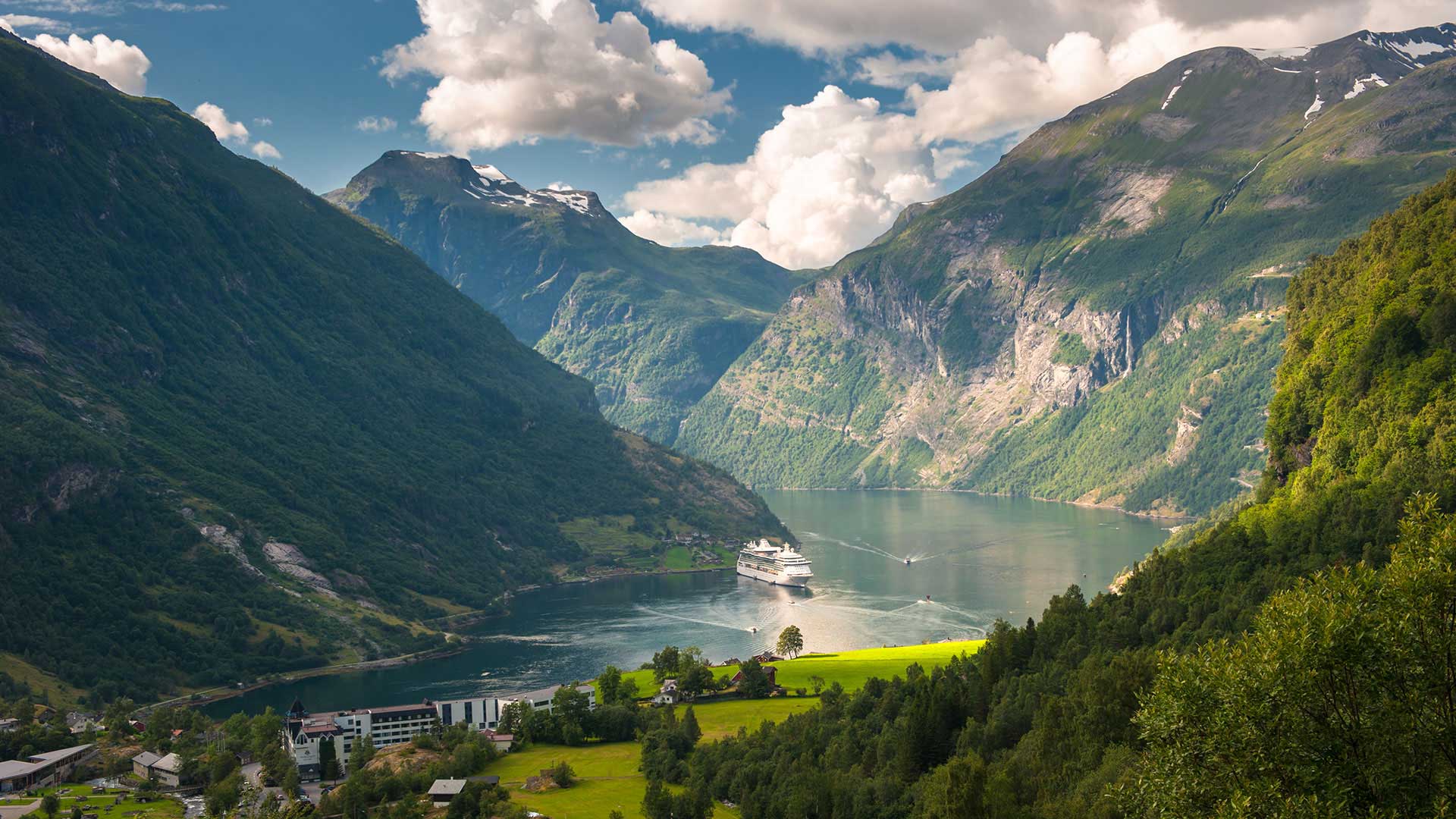
Norway in summer
Best for enjoying the midnight sun & warm waters
June to August is a fantastic time to visit Norway if you want to take advantage of the country’s legendary midnight sun. At this time of year, the days are long and pleasant, and greenery stretches as far as the eye can see.
How’s the weather?
While temperatures in the north (for example in Tromsø) stay low at around 11°C (52°F), temperatures in the south climb into the 20s°C (68°F +). Perfect summer temperatures to enjoy sightseeing.
Best places to visit
The warm weather, endless daylight hours, and good road conditions mean it’s a perfect time for taking on a road trip ! You could leave from the capital, Oslo, and head toward the western fjords region.
Make sure to stop by the famous and UNESCO World Heritage-listed Geirangerfjord .
If you’re keen to venture into the real north of Norway, summer is a good time to go if you want to avoid the coldest, snowiest weather.
We especially recommend touring the Lofoten islands , just north of the Arctic Circle. This charming archipelago is an idyllic place to enjoy nature, hike, kayak, cycle, boat and fish to your heart’s content. Just drink in the astonishing scenery under the midnight sun.
- Look up summer self-drive tours of Norway
- Or take up the epic Norway in a Nutshell ® train and cruise itinerary
Fun activities to do
The warmer weather of the summer means the lakes warm up nicely, making them ideal for wild swimming. Even if you don’t take to the water yourself, you can still make the most of the weather. How abouta boating or kayaking trip?
If you’re in Bergen, you could try the Mt Ulriken zipline. This would allow you to experience the city from a different perspective.
And if you’re a lover of birds, it’s a great time to come to Norway for birdwatching. There are interesting safaris available at this time of year. We can suggest the one in Honningsvåg, in the north of Norway.
Mark your calendar for these fun summer events:
- Riddu Riđđu, an international indigenous festival hosted in July each year. It takes place in Kåfjord, 2 hours outside Tromsø in Northern Norway.
- The Norwegian International Film Festival happens every August in Haugesund, 2 hours outside Stavanger.
- Midnight Sun Marathon is held in Tromsø each June.
- Norwegian Wood, one of Oslo’s best music festivals, also happens to be scheduled for June.
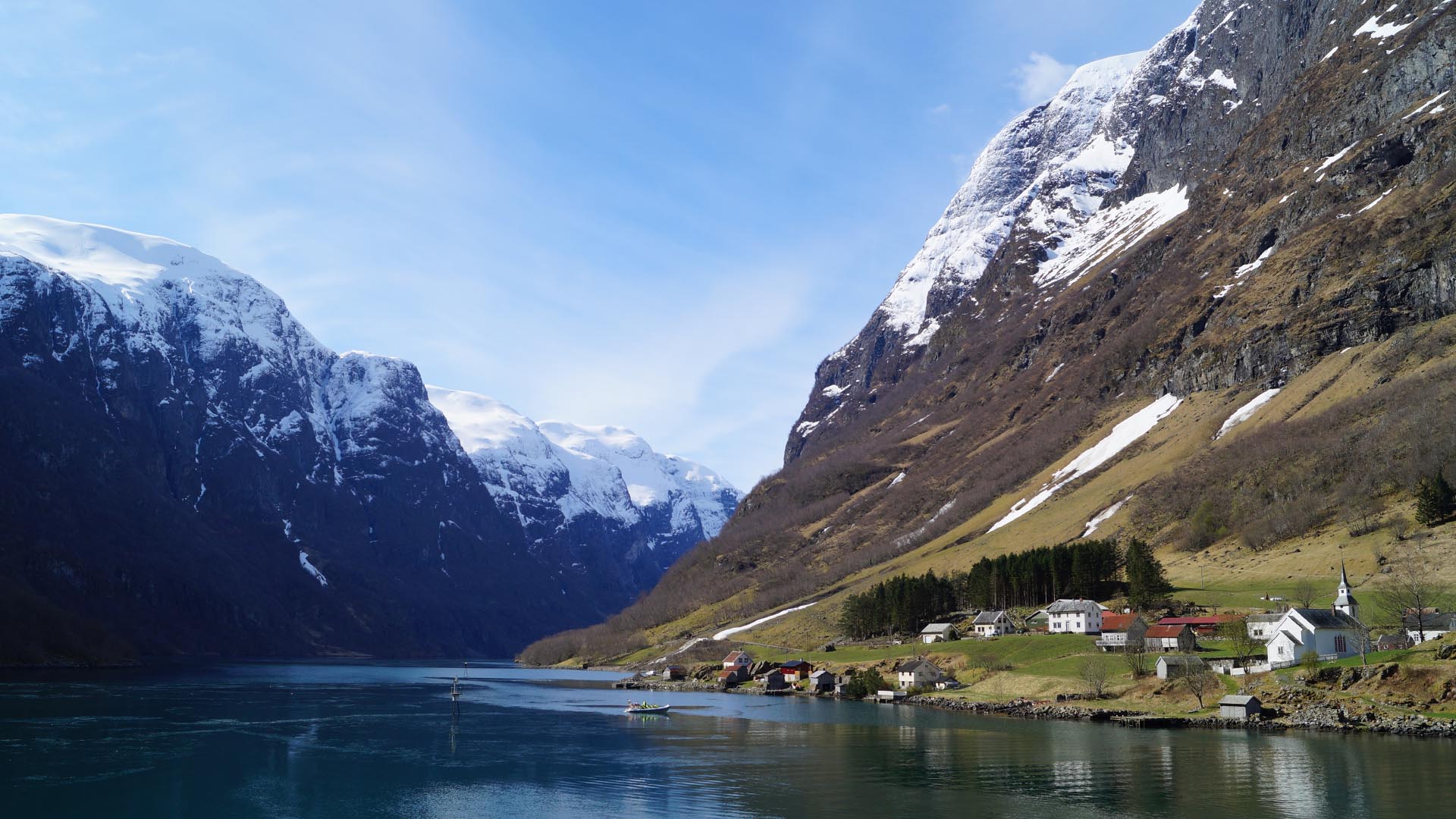
Norway in autumn
Best for enjoying crisp nights & scenic hikes
Between September and November , Norway is transformed. The lush greens of the summer have been replaced with the fiery autumnal shades of yellow, orange and red. At this time of the year, the landscape is on the cusp between colourful foliage and the frost of first snow.
This is the perfect time of year if you enjoy hiking, and especially if you are seeking a quieter ambience. October and November in particular see a drop in visiting travellers, meaning you’ll have more of the sights to yourself.
This is the time of year when the weather in Norway starts to change as the winter approaches. In Oslo, average temperatures come down to around 6°C (48°F) in October, while in the north they are only around 2°C (35°F).
The cities are must-sees during this season as you have plenty of places to visit, such as museums and attractions. You could make your way between Oslo and Bergen, taking on the iconic Norway in a Nutshell® journey.
Going through the country toward the west coast is an ideal way to spot all the gorgeous landscapes, marked by the colours of autumn.
If you’re looking for a fantastic wildlife experience, make sure to head north, maybe on a Havila or Hurtigruten cruise all the way to Kirkenes . This is a good time of year to spot sea life, such as humpbacks and orcas, in the chilly northern waters.
The crisp weather of autumn means it is a great time if you love hiking and are always seeking an interesting viewpoint.
In September and October, you could take on famous hikes to Pulpit Rock , or even Trolltunga. That said, we recommend following local safety advice and weather warnings when out hiking.
You can’t think of the Norwegian autumn without of the aurora borealis. This time of year is the start of the season for going on northern lights tours in Norway .
Mark your calendar for these autumnal events:
- Bergen International Film Festival held at the end of September.
- Dark Season Blues, a music festival held in Longyearbyen in Svalbard each October.
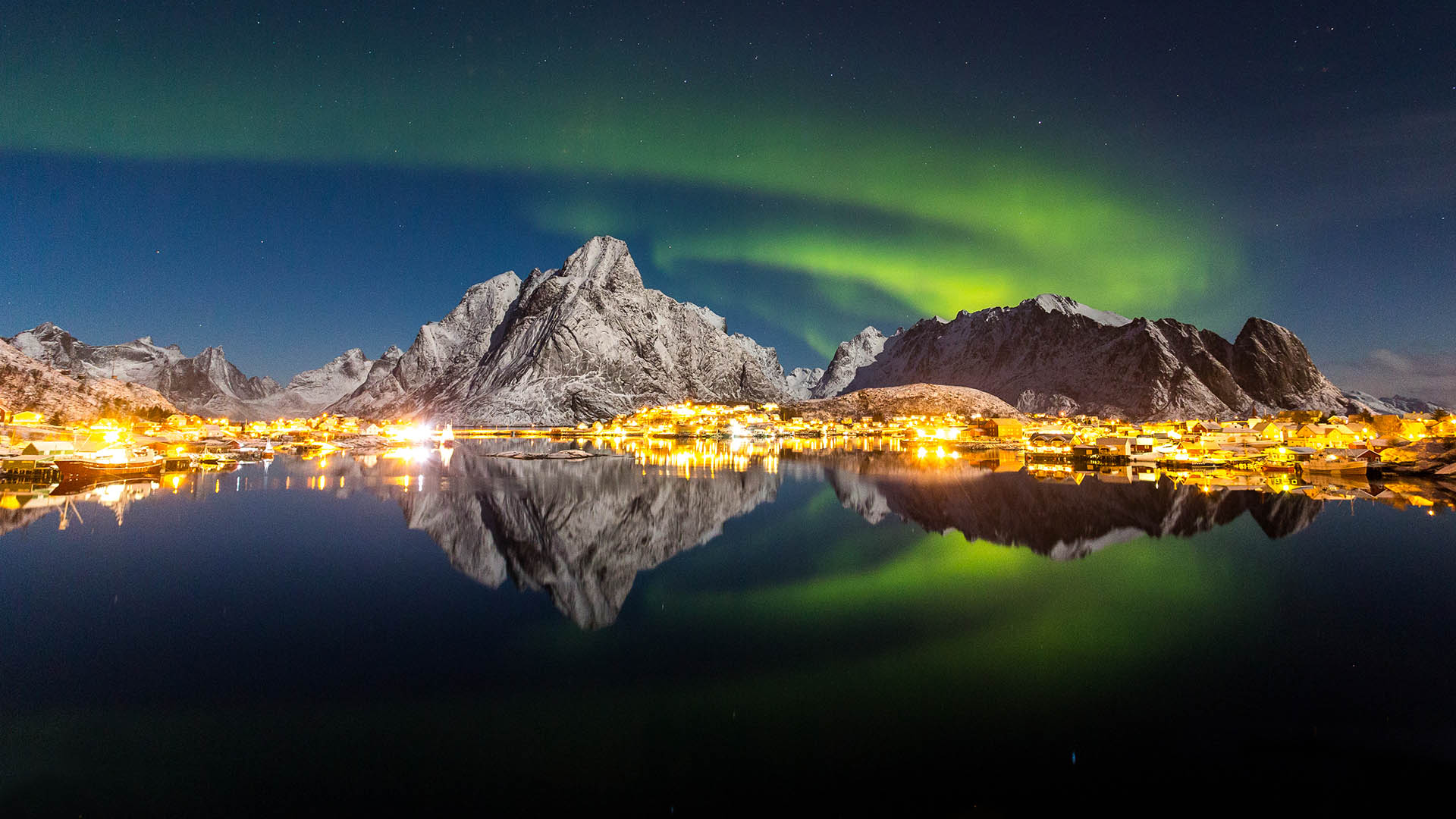
Norway in winter
Best for enjoying the northern lights & winter sports
Norway’s winter is magical! While these months may be cold and dark, the beauty of the landscapes more than makes up for it. The country is draped in thick snow, and the fjords are transformed into mystical ice realms.
If you’re looking for the best time to travel to Norway to witness a snowy wonderland, this is it.
Some roads are closed over the winter months, but you can enjoy cruises and train journeys all year long.
It’s a great time of year to travel through the snow-capped mountains and keep an eye on the dark skies. You may be lucky enough to spot some colourful dancing lights in the sky as well!
Temperatures fall to an average of -3 or -4°C (25°F) in both the capital and the north. By the coast, however, which enjoys a more temperature climate, it stays around 2°C (35°F).
Make sure to head north! Within the Arctic Circle, you’ll be able to enjoy the true meaning of winter.
One of the key draws of a winter trip to Norway is of course the northern lights. And the best location to have a chance to spot them is in Northern Norway.
In fact, there is a zone called the “Northern Lights Belt”, situated from 65 to 72 degrees north. It’s known for having the highestt auroral frequency and intensity. The closer you are to it, the better your odds are!
Both the city of Tromsø and the Lofoten islands fall directly within this area, so we highly recommend these destinations. You could also take on an Arcticcruise to the North Cape and Kirkenes. In fact, these are some of the best cruise journeys in Norway .
- Book a tour to Norway to spot the northern lights with these winter itineraries
- Related: 10 things to do when you visit Norway in winter
Winter may be the ‘off-season’ in some places, but in Norway you’ll find plenty to do! And we don’t mean just looking out the train window at the gorgeous mountains above, or searching for the northern lights.
In the winter months, you’ll be able to enjoy a host of unique activities, including reindeer- and dog-sledding. You could learn more about Sami culture, stay at the SnowHotel , or even chase the northern lights by snowmobile.
Stay the night inside a snow hotel with these ice hotel packages to Northern Norway
Near Oslo, you could visit the Holmenkollen Ski Museum and Tower . The museum is the oldest of its kind in the world and showcases more than 4,000 years of skiing history. Head up to the observation deck at the top of the jump tower for views of Oslo.
Another great place to experience the true north is in Svalbard – a Norwegian archipelago located closer to the North Pole. It is one of the world’s northernmost inhabited areas and is famous for its number of polar bears.
Mark your calendar for these winter events:
- Ice Music Festival, a glacial event happening every February in the alpine resort town of Geilo .
- Northern Lights Festival, a 10-day music festival held in Tromsø every January.
- Rørosmartnan held in February and considered the largest winter festival in the country.
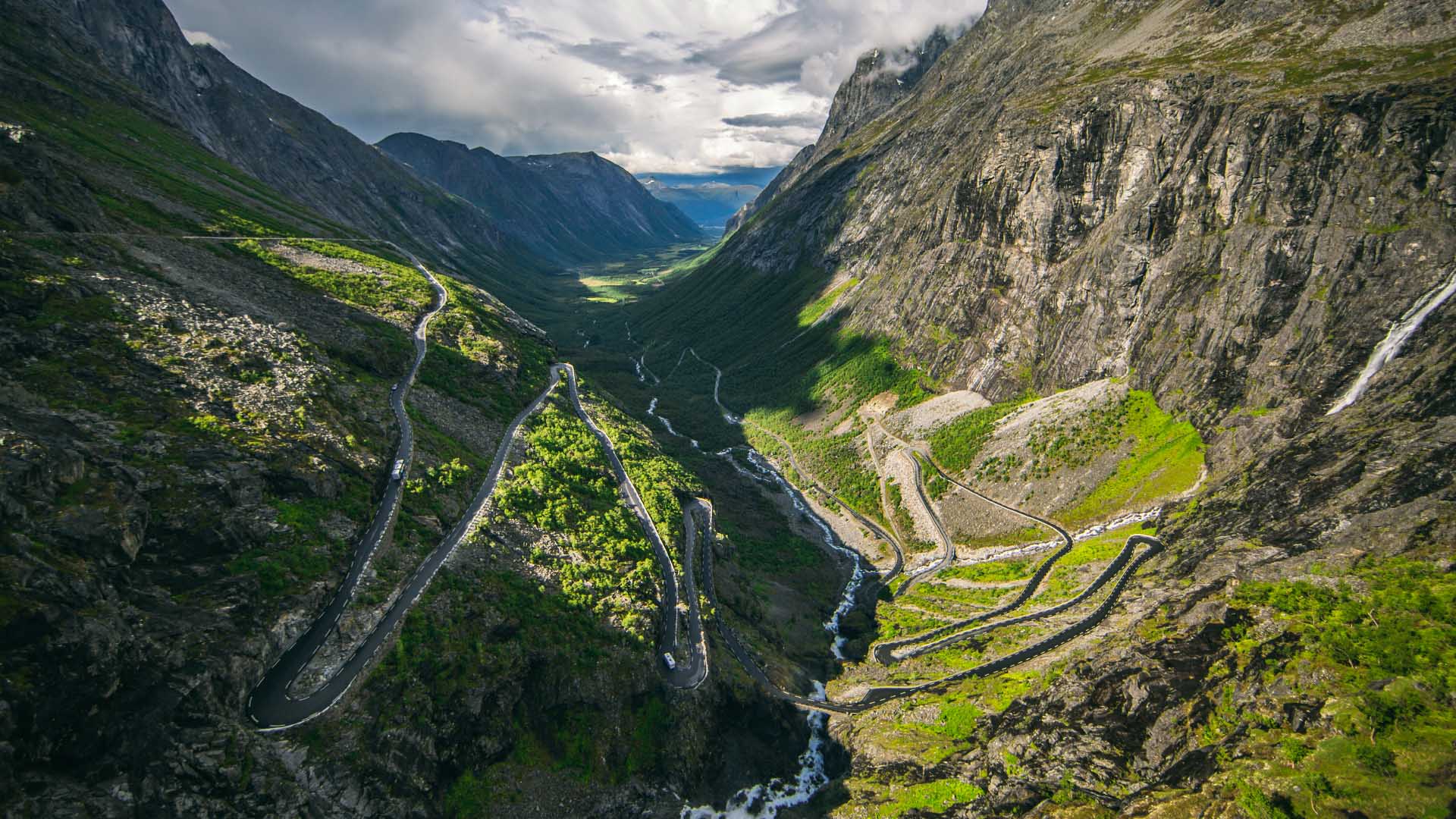
Norway in spring
Best for enjoying flora and bird watching
March , April and May are also beautiful months to visit Norway. As the winter snows melt, the rivers, lakes and waterfalls swell with fresh water and life. Snow-draped landscapes fade away and are replaced with swathes of lush green.
From April to May the weather rises between 0 and 11°C (32-52°F) in Oslo , and up to, on average, 4°C (39°F). As this is a changeable season, you never know as it may inch a bit higher or lower.
You’ll definitely enjoy the fjords in the spring! The western fjords are gorgeous all year long, but in the spring, the landscape transforms from wintry to luxuriant.
We recommend taking a coastal cruise from Trondheim down to Bergen, admiring the coast along the way. At this time of year, many summery activities reopen their doors so you can take advantage of these before the summer boom.
Boosted by the meltwaters, the waterfalls of Norway are at their most formidable during spring. You could go on a kayak or rib boat tour at Geirangerfjord to get close to the stunning Seven Sisters and Bridal Veil waterfalls.
One of Norway’s biggest attractions at this time of year is also the spring blossom. By May, the flowers are in full bloom across the country and, on a sunny day, the scenery can be out of this world.
In May, when the nicer weather has usually settled in, some roads reopen. One you won’t want to miss is the Trollstigen road near Ålesund. You could make sure to drive it on a road trip, or to book an optional excursion to go experience it.
Mark your calendar for these spring events:
- Stavanger Vinfest, a food and wine festival held in April.
- Constitution Day on 17 May, celebrated all over the country.
- Bergen International Festival beginning in late May.
Best time to visit for…
If you’re wondering when the best time of year to visit Norway is for a specific activity or to visit a certain location, read below. Nordic Visitor’s travel experts share their insider tips to help you plan your ideal trip.
Best time to visit Svalbard, Norway
A great place to experience the true north is in Svalbard – a Norwegian archipelago located halfway to the North Pole. It is famous for having more polar bears than human inhabitants.
If you’re keen to fly north, we recommend going between February and September. That is because of the number of daylight hours available during those months.
In the depth of winter, the region experiences a polar night and therefore the sun doesn’t rise at all. From February, you get a better balance of darkness, to spot the northern lights, and daylight, to go on excursions.
You’ll want to be able to admire the glittering icebergs, frozen tundra and maybe even spot the elusive white bear.
- Check out these fun tours of Svalbard
- Related: Read a first-hand account of a special visit to Svalbard
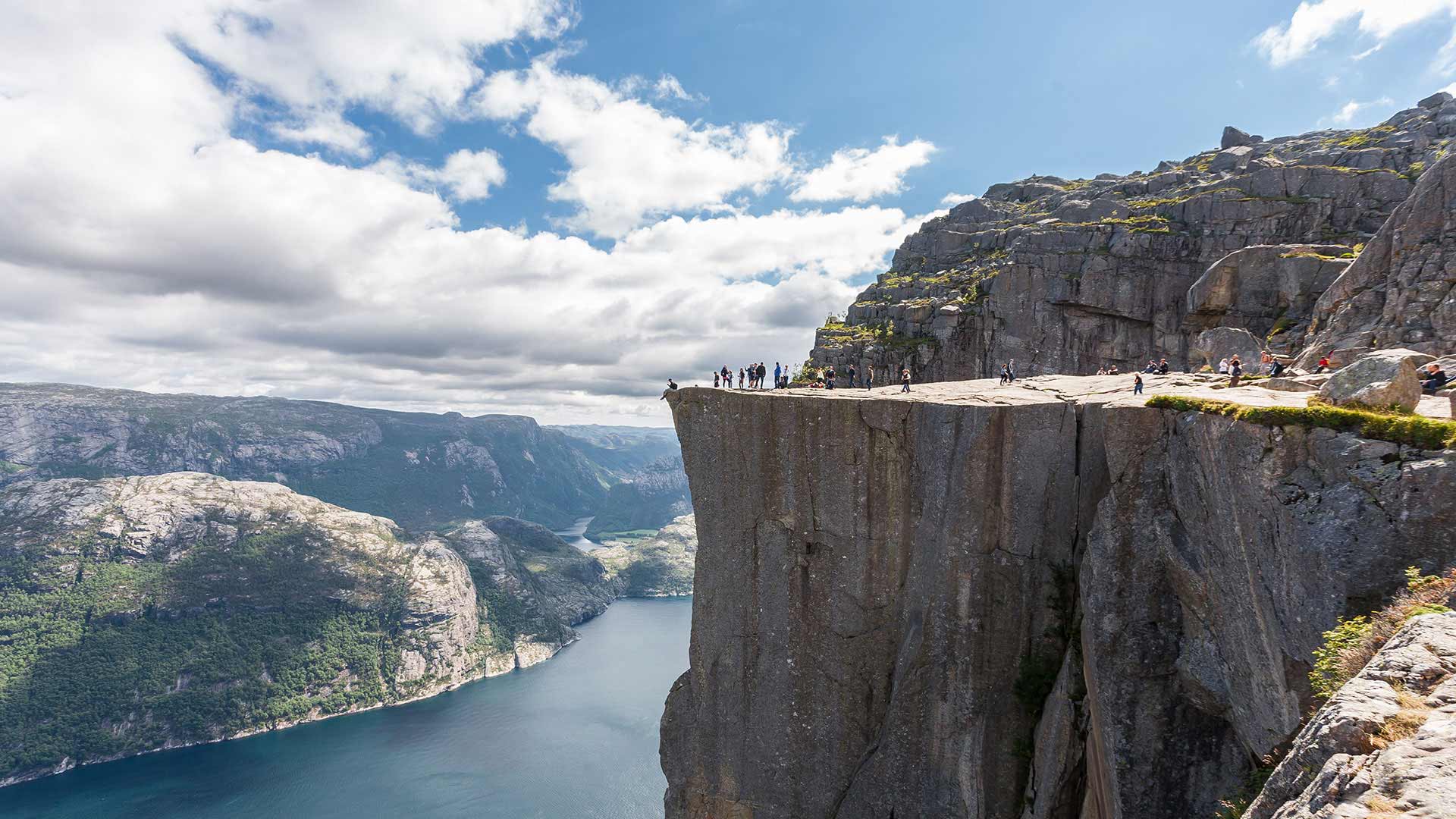
Best time to travel to the Norway fjords
The Norwegian fjords are amongst the most beautiful in the world. It is no wonder that the West Norwegian Fjords, Geirangerfjord and Nærøyfjord , are listed as one of Norway’s UNESCO World Heritage Sites . Picture tranquil waters, thundering waterfalls, and sheer mountain faces.
To see the fjords in all their glory, the summer is a great period for a visit. At this time, you could go kayaking along a fjord to take it all in from a different perspective. You could even try dipping your toes in or going wild swimming.
But there are benefits to the other seasons too. Come in spring to see the waterfalls running with even more power thanks to the snow and ice melting. In winter, you may get a view of snow-capped mountains and frosted waterfalls as you sail through the Norway fjords.
- Discover the majestic western fjords with one of these Norway tours
- Related: The best fjords in Norway
Best time to visit Norway for the weather
First, what is the best weather for you?
As mentioned previously, the warmest weather of the year is definitely during the summer. At this time, you’ll enjoy sunny days in the south, either for a city break in Oslo or to take on a fun excursion to the fjords.
But maybe you prefer colder days with crisp air and plenty of snow to enjoy fun activities. Then come in winter.
If you like mild weather, you’ll probably prefer the shoulder seasons. In April, May and September, you’ll enjoy weather that is perfect for hiking or exploring, with plenty of daylight to do so!
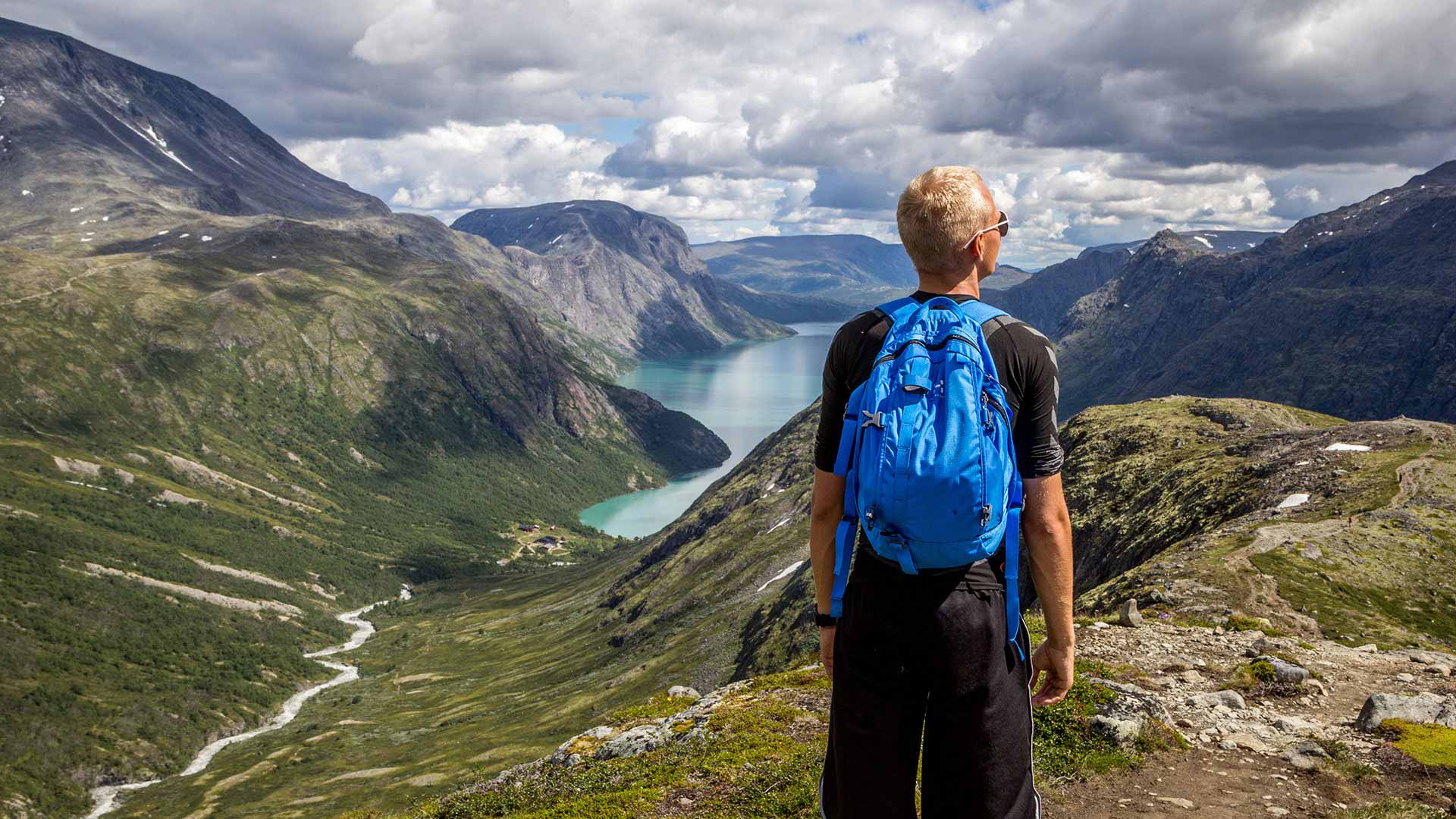
When is the best time to visit Oslo, Norway
Oslo, the formidable capital of Norway, is the ideal Nordic destination for a city break. It’s also a great gateway to discovering more of the country.
To see Oslo at your own pace we recommend visiting in the months just before or after the summer. This way you’ll enjoy all the top attractions with, hopefully, fewer crowds. This time of year is the best of both worlds.
Spend your days visiting the top landmarks, such as Akershus Fortress and the Royal Palace , which may have more availability at that time of year. Later, walk along Aker Brygge , the old waterfront, and enjoy al fresco dining in the bright and cool evening.
Visit Oslo in early winter for another fantastic experience. At this time, you could enjoy the charming Christmas markets and go sightseeing under fairy lights. A trip to Norway’s capital city is a great way to get into the festive spirit.
- Explore Oslo on a city break to Norway
Best time to visit Tromsø, Norway
Tromsø is a great year-round destination if you’re looking for stunning scenery and don’t mind a cooler day out.
Visit Tromsø between October and April to enjoy a winter wonderland and experience a polar night. This phenomenon, where the sun doesn’t rise at all, happens from late November until mid-January.
Another bonus of visiting in winter is the city’s location, straight into the “Northern Lights Belt”. This means you may be able to admire the lights from the city itself.
From Tromsø you could also journey across the northern coast of Norway, to the North Cape and all the way to Kirkenes. This is an amazing winter journey along the Arctic Circle.
In summer, visit Tromsø and the nearby Lofoten islands, to experience the polar opposite (pun intended!). From mid-May until late July, the sun doesn’t set at all. This is called the midnight sun. You could go hiking and enjoy the natural landscape at midnight if you wish.
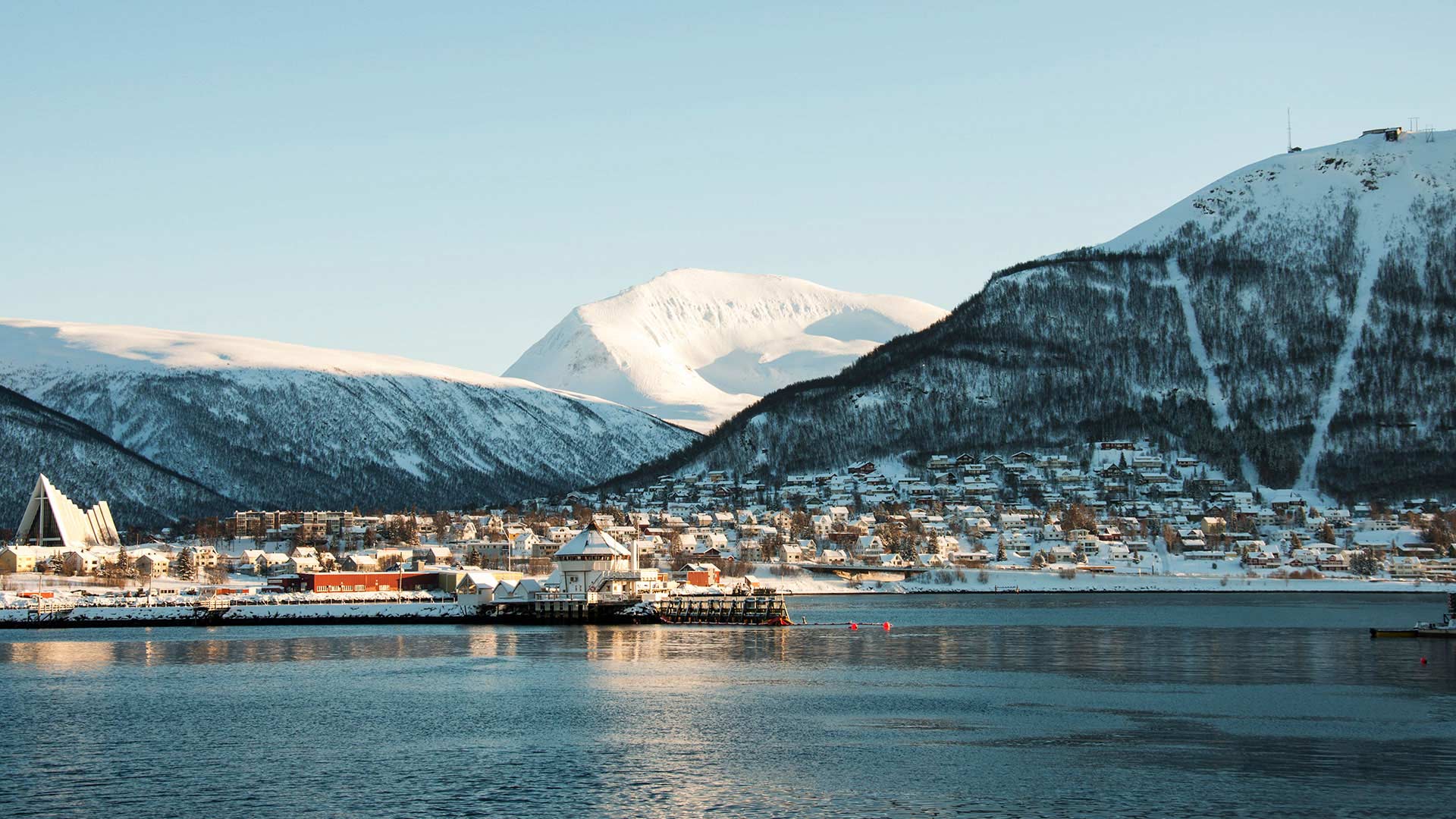
Best time to visit Ålesund, Norway
The charming port town of Ålesund is one of Norway’s most visited cities. This is in part thanks to its beautiful setting along a cluster of islands in the western fjords.
It has also become a popular stop as part of the Norwegian Coastal Voyage. If you’re cruising your way up or down the country, you could add a stopover in Ålesund. And it is definitely worth the visit!
We recommend travelling here in summer to experience it at its best and to enjoy all the activities available. These include angling, sailing, hiking, and kayaking, among others.
From Ålesund, you can cruiseto the nearby Geirangerfjord. You could also spend your days hiking to local viewpoints. Summer is the ideal time to walk up Mount Aksla and enjoy the panoramic views of the archipelago and the peaks of the Sunnmøre Alps.
- Take a look at these Norwegian culture trips
Best time to visit Norway, Sweden and Denmark
Are you looking for a grand tour of Scandinavia? This Northern European region, composed of Sweden and Denmark as well as Norway, is a fantastic destination come winter or summer.
The capital cities, Oslo, Stockholm and Copenhagen, are well connected. That means it’s easy to travel between each of them on one single trip.
In summer, you could drive or take a train and then a cruise to see what makes each city so special. In winter, you’ll be able to sightsee the highlights of all 3 countries with their mild weather and charming winter lights.
Travel just before or after the summer, to enjoy nice weather and plenty of daylight. At popular locations, such as the capitals, Norwegian fjords and top hiking spots, you’ll enjoy having more time and space to yourself.
- Combine a trip to Norway with Sweden and Denmark with these Scandinavian tours
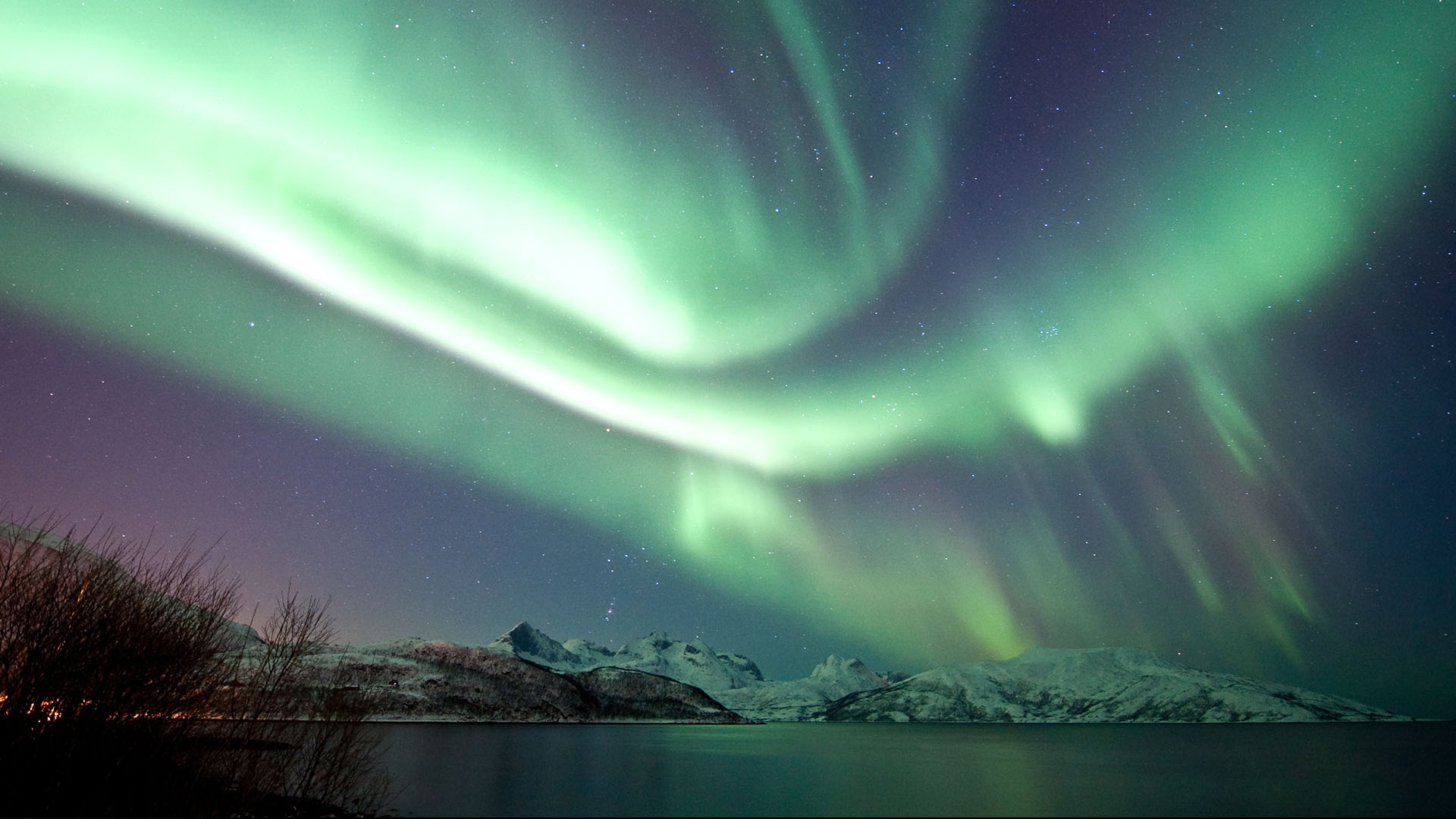
Best time to visit Norway for the northern lights
The northern lights, or aurora borealis, are at their best during the winter season. This means you should visit Norway between October and March.
From late September, the days become shorter making it easier to witness the auroras in the night sky. Indeed, you need darkness, good solar activity, and low light pollution to be able to admire them.
You’ll also want to journey into Northern Norway, all the way into the Arctic Circle, to spot the northern lights. The few prime locations for northern lights spotting in Norway are:
- Tromsø
- North Cape (Nordkapp)
- Book one of these aurora tours to see Norway under a sky lit with northern lights
- Related: Best places and times to see the northern lights in Norway
Best time to visit Norway and Iceland
To combine both these stunning countries into one epic Nordic trip, we recommend visiting in summer.
At this time of year you will benefit from longer days to make the most of your exploration. Take in the highlights of southern Norway like Oslo and the Norwegian fjords before flying to Iceland where you could tour the whole island.
You could even discover more of Scandinavia if you so wish and have the time for a longer trip. Start your tour in Stockholm, passing by Copenhagen before taking on Norway and Iceland.
Sights can be popular at the height of summer, so you could try planning your tour for early or late summer if you want a quieter holiday.
And if you would rather visit during the winter, fear not, it is also possible! In fact, this season has some bonus points of its own too. You’ll be able to admire the glittering frost over amazing Norwegian and Icelandic waterfalls .
This is also the time of year to travel to the Nordics if you want to catch sight of the northern lights. As the darkness sets in, from late September, it becomes easier to see them dancing in the night sky.
- Go on a combined tour of Norway and Iceland
- Or look up Iceland tours to explore the Land of Fire and Ice
Best time of year to visit Bergen, Norway
Bergen is another Norwegian city that can be visited all year long. As it is one of the rainiest cities in Europe, you’ll probably want to travel here in summer for the best weather.
In case of bad weather, fear not, there is plenty to do indoors. You could visit the 900-year-old Bergen Cathedral and one of Norway’s oldest fortresses, Bergenhus Fortress. There are also many museums like the Bryggens Museum, the KODE Art Museum , and the Hanseatic Museum.
But really Bergen is known as the gateway to the fjords and is an excellent outdoor destination. In summer, you could hike up one (or more!) of the seven mountains surrounding the city. You could also participate in fun activities like ziplining across Mount Ulriken.
You also won’t want to miss hiking or taking the Fløibanen funicular to the top of Mount Fløyen . You’ll get some amazing views of the city below and access to some top walking trails.
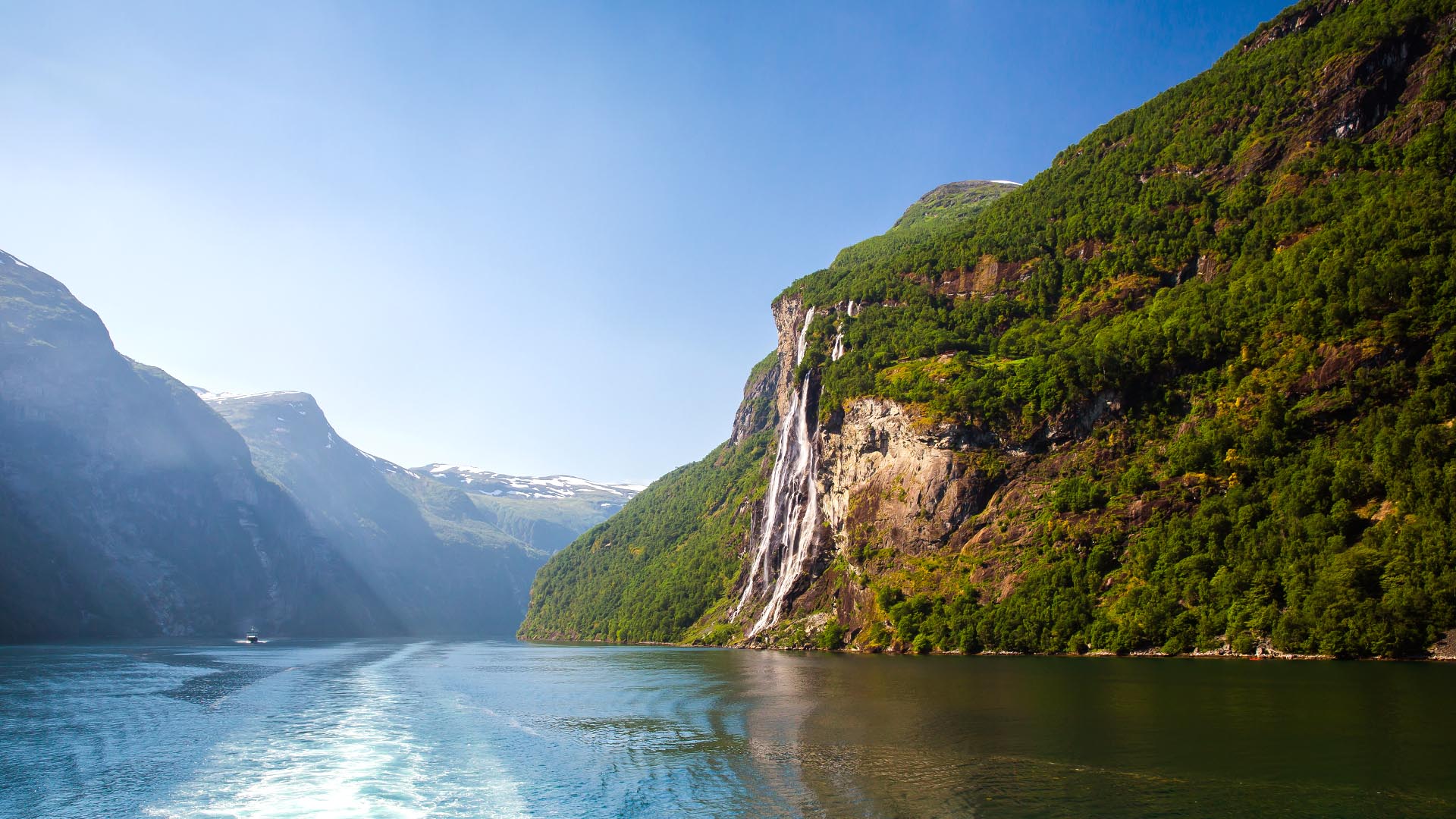
Best time to visit Norway on a cruise
You can cruise Norway’s magnificent and diverse coast any time of the year. That said, we do recommend the summertime for the best experience.
Between May and September, you’ll enjoy long days, ideal for sightseeing. That’s true from the boat or on excursion stops on the mainland. Take photos in the midnight sun and pack more in your day.
In winter, you may enjoy the smaller crowds, but days are much shorter. You may also find the sea is a bit rougher. The one bonus of a winter cruise is the chance to admire the northern lights in the sky above.
A cruise is, in fact, excellent for spotting the auroras as you’ll be away from city light pollution.
- Browse fjords cruise & train tours
- Discover Norway on a Hurtigruten voyage
Best time to go to Norway for hiking
Do you have dreams of standing proudly atop Trolltunga or Pulpit Rock ?
You may have seen the scenic photos of people standing by the cliff edge, with calm fjords below and rocky mountains in the distance.
April until October is the best time to hike to those famous heights. To skip the potential queues for the best Instagram snaps, you should visit during the shoulder season. Late spring and early autumn are quieter times of year that are fantastic to experience the mountains in a bit more peace.
In fact, autumn may be the best time as you’ll find more paths accessible at this time compared to spring. And you’ll be treated to the orange and yellow foliage of the forest.
- Check out these active tours of Norway
Best time to visit Norway for the midnight sun
The midnight sun is an incredible phenomenon whereas the sun does not set below the horizon. It occurs inside the Arctic Circle during summer.
For example, Tromsø and Svolvær , located inside the Arctic Circle, experience the midnight sun between mid-May and late July. You’ll want to visit the northern parts of Norway (or neighbouring Sweden and Finland) at this time to witness it.
Imagine hiking or sitting by the Norwegian Sea admiring the scenery while basking in the light of the sun in the middle of the night.
Just make sure to bring an eye mask to help you sleep!
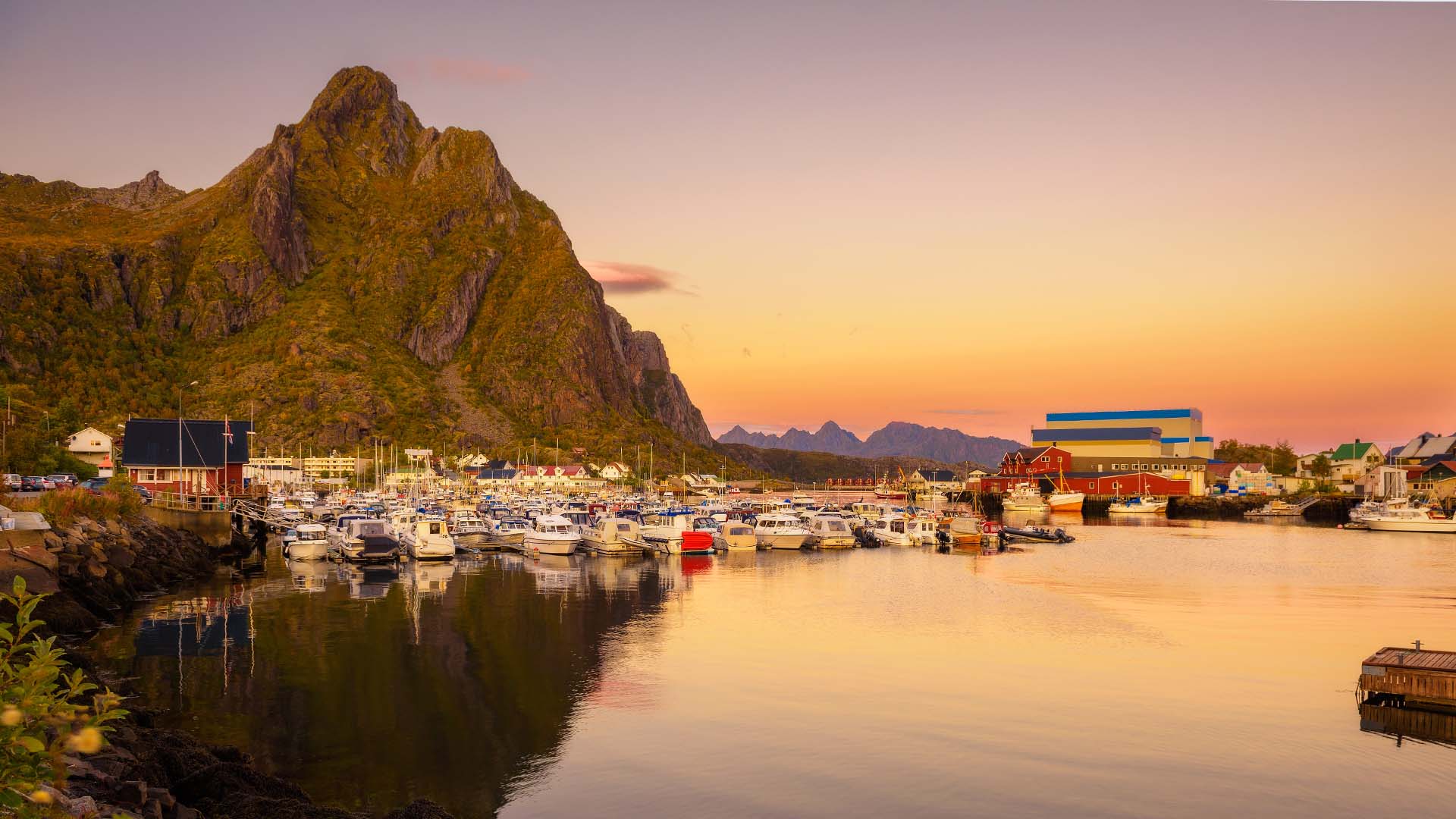
Best time to visit Norway for whale watching
Every year, whales pop up along the Norwegian coast. For this reason, it’s a good location to go on a wildlife cruise to spot them up close.
These gentle giants of the sea are most commonly seen along the Vesterålen coast, just north of Lofoten. Make sure to go there in summertime for your best chances and for more varied sightings.
You could spot sperm whales, but also pilot whales, minke whales, humpback whales, dolphins, and killer whales.
For the best whale-watching experience in Northern Europe, we recommend heading to North Iceland instead. Indeed, Húsavík is considered the capital of whale watching. Trips are available all year long, but summer is the best time to visit.
You might see dolphins, minke whales, humpback whales as well as some sperm whales and maybe the elusive blue whale.
Learn more about whale watching in Iceland .
What to pack for a trip to Norway
The weather in this part of the world can be fickle, but don’t let that stop you from enjoying the best of Norway. Pack well to come ready for rain or sunshine and take advantage of your trip to the fullest.
For all seasons, you should pack layers so you can be flexible depending on the day's temperature. We especially suggest bringing a waterproof jacket and comfortable walking or hiking shoes.
Even in the summer it’s best to have a pair of light gloves, a hat and a scarf handy. Don’t forget your sleeping mask to help with the light nights of summer.
In winter, make sure to pack some warm layers (preferably woollen) along with an insulated jacket.
Finally, don’t forget your camera to snap away at all the spectacular landscapes!
- For more travel inspiration, check out these classic holidays in Norway
Norway is an exceptional destination that can be enjoyed all year long. We hope this post convinced you of that!
When you’re ready to book your dream Norway holiday, take a look at these top Norway packages . And if you’re still not sure or would like local advice, get in touch . Our travel experts can be reached s via live chat, toll-free numbers or email.

Camila grew up between the French Canadian and Chilean cultures, before moving to Scotland in 2012. When she’s not travelling or writing about travels, Camila loves to read, run, and puzzle. Her favourite destinations have been Reykjavík, Copenhagen, Estonia and Cape Town.
Find Camila on LinkedIn .
Getting there
We'd love to give you the same amazing travel experiences as you read about in our blog! To visit the destinations and attractions mentioned in this post - and to discover a few new highlights along the way - check out these recommended Nordic Visitor tours.
HIGHLIGHTS OF NORWAY
- USD ($)
- CAD ($)
- AUD ($)
COMPLETE NORWAY
Related posts, 5 top norway road trips: a local expert’s view.
Blogs , Activity , Scandinavia , Norway , Guides , Things to Do
7 Incredible Things to See and Do in Norway
Best time & place to see northern lights in norway, 10 things to do in norway in winter.
We’re not taking new bookings for travel to Norway at the moment. Our specialists can advise you on all the destinations you can currently book with us.
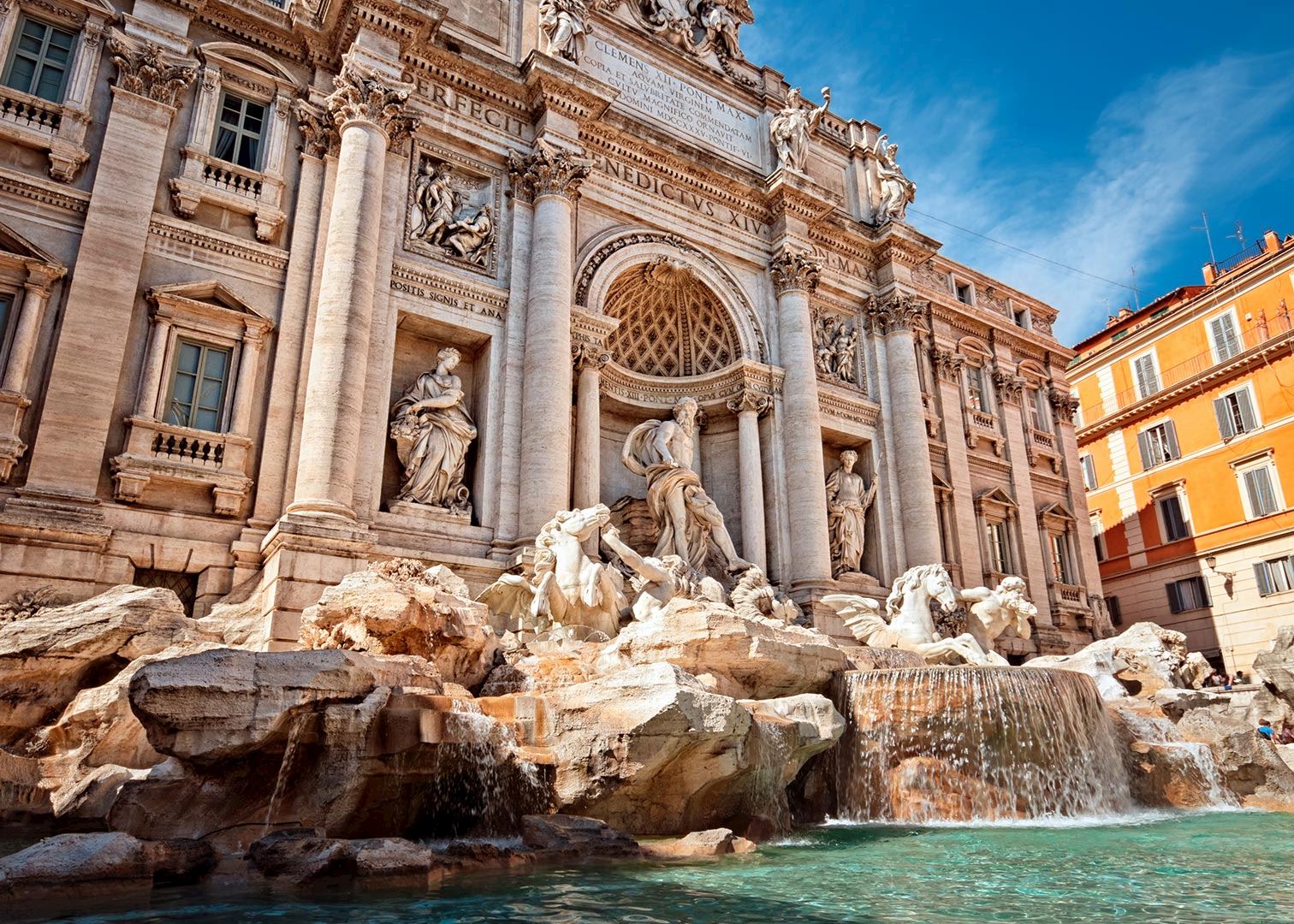
Change location
- Call us today from 10am
- 01993 838 925 01993 838 763 or
- REQUEST A QUOTE
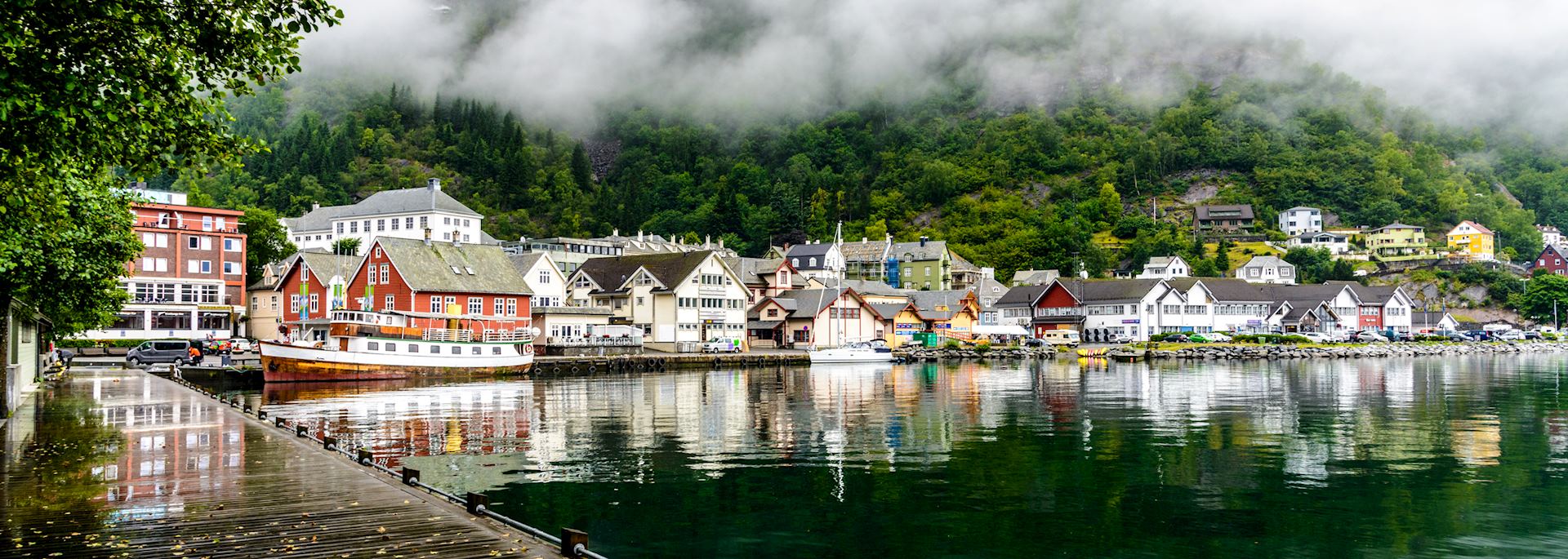
When is the best time to visit Norway?
- Month-by-month
The best time to visit Norway in the northern region is in the autumn, which brings thinner crowds, cooler weather between 5°C to 10°C, and glorious foliage.
The best time to visit Norway in the southern region is between May and August, when the days are long, the landscapes are green, and the weather is warm, between 16°C and 22°C. This is a popular time to explore the region, so expect to see a few more visitors around. In northern Norway, you can hike under the midnight sun at this time of year.
The two regions have very different climates, so when you visit Norway will likely depend both on what you want to do when you’re there and where you want to go.
Starting in late November and running until February or March, the whole country turns into a wintry playground, especially the northern region. If you’re comfortable with frigid temperatures, this is an excellent time to visit the Arctic Circle, where you can watch the northern lights and enjoy the deep snow that blankets the landscape.
The best time to visit the fjords is in April, May or June, which are perhaps the most photogenic months, when the fruit orchards on the shoreline explode into pastel bloom. However, this area of the country offers a milder climate and so makes an excellent destination year-round.
Month-by-month guide for travelling in Norway
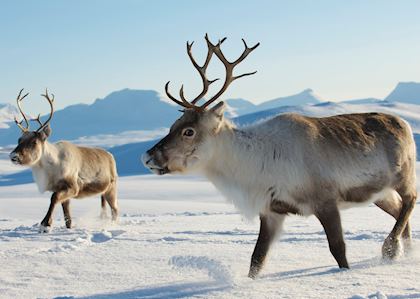
Visiting Norway in December - February
The whole of the country becomes a snowy winter playground during these months, though the deepest snow and coldest weather is found inside the Arctic Circle, where you can often see the northern lights. Temperatures can drop as low as -20°C (-4°F) up in the north, but it’s milder (around -2°C or 28°F) in the fjordlands.
Events & Festivals
- The Nobel Peace Prize Award Ceremony draws luminaries from around the world to Oslo in early December.
- Norwegians celebrate Saint Lucia Day with festivals of lights and parades on 13th December.
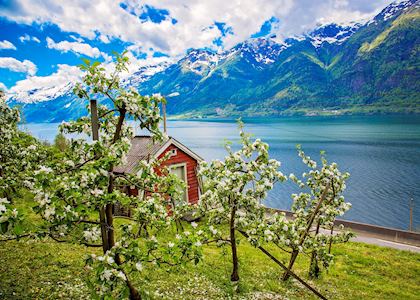
Visiting Norway in March - May
Winter begins to lift and the weather turns milder. The fjordlands burst into bloom as the shoreline orchards of fruit trees blossom. Melting snow fills the rivers and the waterfalls swell as wildflowers unfurl. There are fewer crowds in the cities this time of year, making it a good time to visit museums and other cultural attractions.
- The Bergen International Festival brings together performers, singers, dancers and other artists for a week-long festival in late May.
- Discover Norway’s medieval heritage at Oslo Middelalderfestival, also held in late May.
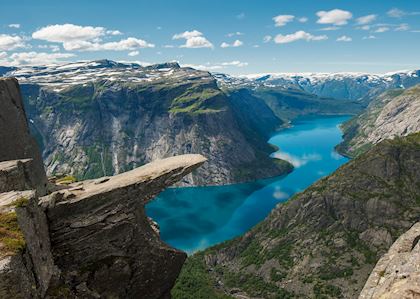
Visiting Norway in June - August
Days get longer, the weather warms and nights get shorter. In the Arctic Circle, there’s 24 hours of daylight, and you can hike under the midnight sun. This is when the weather is at its most stable across the country, with generally pleasant temperatures. It’s an excellent time to explore the rugged countryside and try to spot wildlife. It’s also the most popular season to visit, so be sure to plan well ahead.
- Bergenfest is a music festival in early June spanning a number of genres, including rock and hip-hop.
- The Oslo Jazz Festival and the Oslo Chamber Music Festival both take place in mid-August.

Visiting Norway in September - November
Days shorten, temperatures drop and the air is crisp and cool as the foliage shifts to gold. These are the wettest months, so cities tend to be busier than the countryside — it’s wise to plan ahead if you want your choice of hotels. Some of the attractions will take the opportunity to shut down while it’s quieter.
- The Ultima Contemporary Music Festival in Oslo is a long-running event sponsored by the crown prince each September.
Why travel with Audley?
- 100% tailor-made tours
- Fully protected travel
- Established for over 25 years
- 98% of our clients would recommend us

Travel advice
Practical tips for travelling to Norway, from social protocols to guidance on money matters, with a link to the latest FCDO travel advice.

Request our brochure
Covering all seven continents, The World Your Way shows you how you can see the world with us. It features trip ideas from our specialists alongside hand-picked stays and experiences, and introduces our approach to creating meaningful travel experiences.
Trip ideas and travel guides for exploring Norway
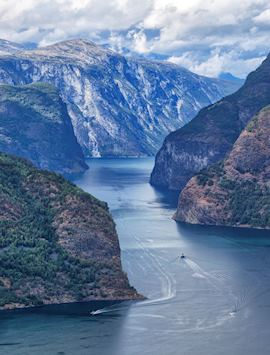
Introduction to Norway
6 days from £2,240pp
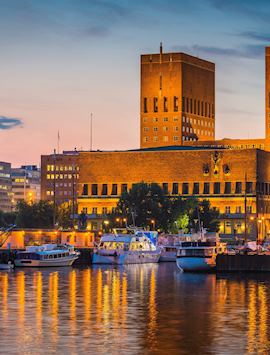
Highlights of Norway
7 days from £3,390pp

Active Scandinavia
9 days from £4,490pp
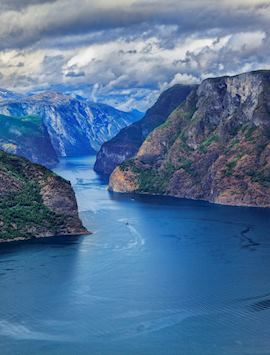
Beauty of the fjords
8 days from £4,605pp
The Best Time to Visit Norway for Weather, Safety, & Tourism
The best times to visit Norway for ideal weather are
July 2nd to August 26th
based on average temperature and humidity from NOAA (the National Oceanic and Atmospheric Administration). Read below for more weather and travel details.
Norway Travel Guide
Temperature.
- Perceived Temperature
- Rain and snow
- Humidity and wind
- The busiest and least popular months
- Overall travel experience by time of year
Other Norway Travel Info
Weather in norway.
Average temperatures in Norway vary greatly. Considering humidity, temperatures feel cold for most of the year with a fair chance of precipitation about half of the year. The area is less temperate than some — in the 16th percentile for pleasant weather — compared to tourist destinations worldwide. Weeks with ideal weather are listed above . If you’re looking for the very warmest time to visit Norway, the hottest months are July, August, and then June. See average monthly temperatures below. The warmest time of year is generally late July where highs are regularly around 65.1°F (18.4°C) with temperatures rarely dropping below 51.6°F (10.9°C) at night.
Norway Temperatures (Fahrenheit)
Norway temperatures (celsius), “feels-like” temperatures.
The way we experience weather isn’t all about temperature. Higher temperatures affect us much more at higher humidity, and colder temperatures feel piercing with high winds. Our perceived temperatures factor in humidity and wind chill to better represent how hot or cold the day feels to a person.
Norway Perceived Temperature (F)
Norway perceived temperature (c), average norway temperatures by month.
Daily highs (averaged for the month) usually give the best indication of the weather. A significantly lower mean and low generally just means it gets colder at night.
Show Fahrenheit
Show celsius, precipitation (rain or snow).
If dry weather is what you’re after, the months with the lowest chance of significant precipitation in Norway are April, June, and then May. Note that we define “significant precipitation” as .1 inches or more in this section. The lowest chance of rain or snow occurs around early June. For example, on the week of June 4th there is 1 day of precipitation on average. By contrast, it’s most likely to rain or snow in late December with an average of 2 days of significant precipitation the week of December 24th.
Chance of Precipitation
The graph below shows the % chance of rainy and snowy days in Norway.
Snow on the Ground
The graph below shows the average snow on the ground in Norway (in).
Average Rain and Snow by Month
Show inches, show centimeters, humidity and wind.
Norway has some very humid months, and above average humidity throughout the year. The least humid month is May (61.7% relative humidity), and the most humid month is November (75.5%).
Wind in Norway is usually moderate . The windiest month is January, followed by December and February. January’s average wind speed of around 10.2 knots (11.7 MPH or 18.9 KPH) is considered “a gentle breeze.” Maximum sustained winds (the highest speed for the day lasting more than a few moments) are at their highest in late December where average top sustained speeds reach 18.3 knots, which is considered a fresh breeze.
Relative Humidity (%)
The graph below shows the average % humidity by month in Norway.
The graph below shows wind speed (max and average) in knots.
Average Wind Speeds
Show wind speeds.
All wind speeds are in knots. 1 knot = 1.15 MPH or 1.85 KPH.
Show Relative Humidity by Month
Is it safe to travel to norway.
Our best data indicates this area is generally safe. As of Dec 04, 2023 there are no travel advisories or warnings for Norway; exercise normal security precautions. Check this page for any recent changes or regions to avoid: Travel Advice and Advisories . This advisory was last updated on Nov 21, 2023.
The Busiest and Least Crowded Months
The busiest month for tourism in Norway is August, followed by April and May. Prices for hotels and flights will be most expensive during these months, though you can save if you purchase well in advance. Tourists are unlikely to visit Norway in October. Those willing to visit at these times will likely find it the least expensive month.
Estimated Tourism by Month
Most popular months to visit, overall norway travel experience by season, spring (march through may).
Humidity and temperatures combine to make this season feel moderately cold. Highs range from 57.8°F (14.3°C) and 36.1°F (2.3°C) with warmer temperatures in the later months. Rain is somewhat common with 4 to 5 days of significant precipitation per month. Spring is the busiest for tourism, which makes it a good time for those looking for things to do.
Summer (June through August)
The middle-year months have comfortably cool weather with high temperatures that are brisk. These months see moderate precipitation with 4 to 5 days of precipitation per month. June – August is the second busiest season for tourism in Norway, so lodging and other accommodations may cost slightly more.
Fall (September through November)
Fall daily highs range from 58.1°F (14.5°C) and 35.4°F (1.9°C), which will feel chilly given the humidity and wind. It rains or snows a significant amount: 5 to 6 days per month. Tourism is the slowest during these months due to the weather, so hotels may be affordably priced.
Winter (December through February)
Weather is far too cold this time of year in Norway to be enjoyable for warm weather travelers. The average high during this season is between 36.1°F (2.3°C) and 29.2°F (-1.6°C). On average, it rains or snows a fair amount: 4 to 6 times per month. These times of year are fairly slow with tourists.
Best Times to Travel › Norway
Similar Destinations
- Ringebu, Norway
- Oyer, Norway
- Stor-Elvdal, Norway
- Lillehammer, Norway
- Svingvoll, Norway
- Gudbrands valley, Norway
- Gjovik, Norway
- Nordre Land, Norway
- Vestre Toten, Norway
- Hamar, Norway
Popular Destinations
- Myakka State Forest, the United States
- Gold Coast, QL, AU
- Nice, France

17 Things You Need to Know Before Visiting Norway

- 1. Norway is a Scandinavian Country
2. Polar Bears do not Walk in the Streets
3. the norwegian currency is nok (norwegian krone), 4. most norwegians speak english, 5. norway is a safe country to visit, 6. winter, spring, summer, fall, 7. always bring an extra layer of clothes, 8. wild camping is allowed in mostly all of norway, 9. national parks and most outdoor locations are free to use, 10. norway has the best salmon, 11. traveling in norway can be expensive if you only eat out.
- 12. Northern lights aren't visible everywhere
- 13. Norway is a Long Country
- 14. There aren't Many Dangers in the Wild
15. Norwegians eat a lot of Taco
16. the difference between southern norway and northern norway is huge.
- 17. The Midnight Sun Isn't a Different Sun
Are you dreaming of visiting Norway one day? Perhaps you've already booked a flight and have begun planning the trip. Regardless of where you are in the process, here are 17 things you should know before visiting Norway:
1. Norway is a Scandinavian Country
We Norwegians tend to believe that Norway is the center of the earth and everyone knows who we are. The truth is that Norway isn't as large as we want to believe and everyone doesn't even know that Norway even is a country.
Norway is a Scandinavian country with approximately 5.2 million people and has numerous times been named one of the best places to live and/or visit.
(For those who don't know: Scandinavia consists of Norway, Sweden and Denmark; 3 nordic countries located in Europe)
A common misconception is that Polar Bears walk the streets in Norway. This is, fortunately, not the case. In fact, there are no wild Polar Bears on mainland Norway.
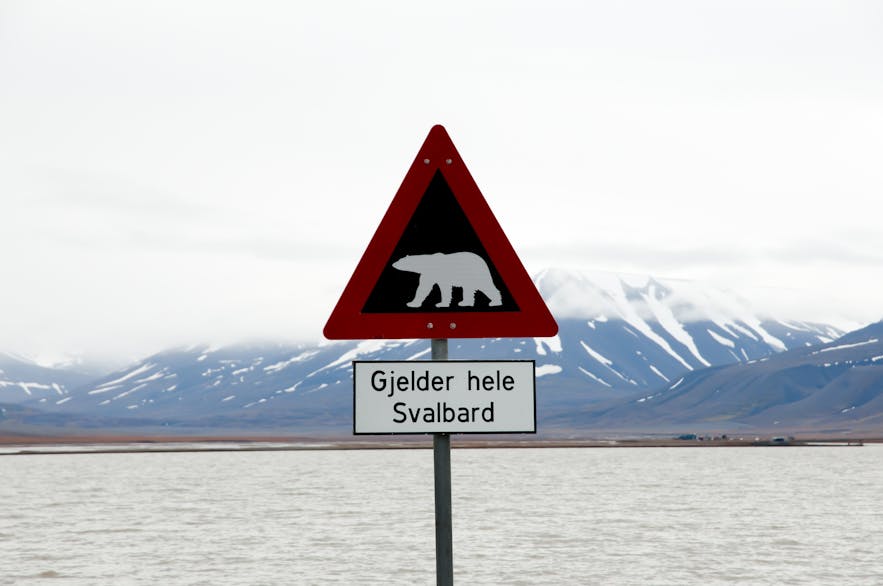
Norway is actually a really civilized country and you would be surprised to see how modern it is. We even have cars driving in the streets...!
Svalbard, however, is a Norwegian archipelago between mainland Norway and the North Pole where there are more Polar Bears than people. Still, it's rare that there are any incidents between the inhabitants and Polar Bears.
The currency we use in Norway is the Norwegian Krone. So, if you're traveling with only Euro you won't come far. The Norwegian Krone was recently weakened which means that if you're traveling to Norway in the near future it will be cheaper than what it was only one year ago.
It should be mentioned that Norway is using less and less cash. You can mostly anything with a credit card, even taxis and hot dogs! That means that it's not a crisis if you forgot to bring cash.

Don't know Norwegian? No problem! The majority of Norwegians speaks English. Even though some are a bit shy to have a full conversation, they are able to understand most and to help you with any questions you might have.
So, don't be afraid of saying hi to a stranger!
Norway is known to be one of the safest countries in the world. Crime rates are extremely low even in major cities such as Oslo , Bergen , Trondheim , and Stavanger .
As with any other urban areas, you should take certain precautions but there's not much to be afraid of. Even walking alone during the night is relatively safe and the chances are small that you'll become the victim of a crime.
Most crimes in Norway are related to home and office burglaries. There are some groups of pickpocketers traveling around the most touristic areas during summer so keep an extra eye on your wallet when you're in a crowd (still, the possibilities of anything happening is low).
There are 4 seasons in Norway: winter, spring, summer, and fall. Be sure to take this into consideration when you're planning to visit Norway . Some attractions are only open during a specific season and certain hikes are unreachable during winter. If your main purpose is to visit one specific location figure out what season is optimal for that.
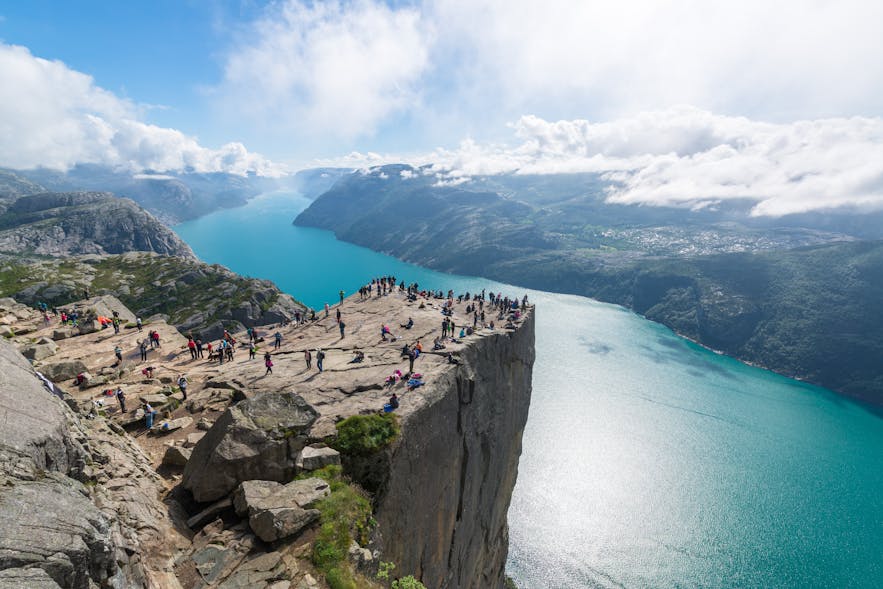
Another thing to keep in mind is that the weather changes a lot between seasons. Make sure that you always bring enough clothes when traveling to Norway as it does get cold! Keeping an eye on the weather forecast is always a good idea.
The weather, as mentioned above, changes a lot between seasons in Norway so you always want to bring enough clothes. Most importantly, if you're planning to go on some hikes during your visit, you need to bring an extra layer of clothes. Even during summer, it's wise to bring a rain jacket and a fleece in your backpack in case the weather changes or the temperatures drop when you reach a higher altitude.
Due to " Allemannsretten " (every man or woman's right of public access), you can pitch a tent wherever you want in Norway (unless anything else is stated at a specific area). The outdoors is very important for us Norwegians and we do our best to maintain the right of using the outdoors freely. So, make sure that you leave no traces behind and don't do any damage to nature.
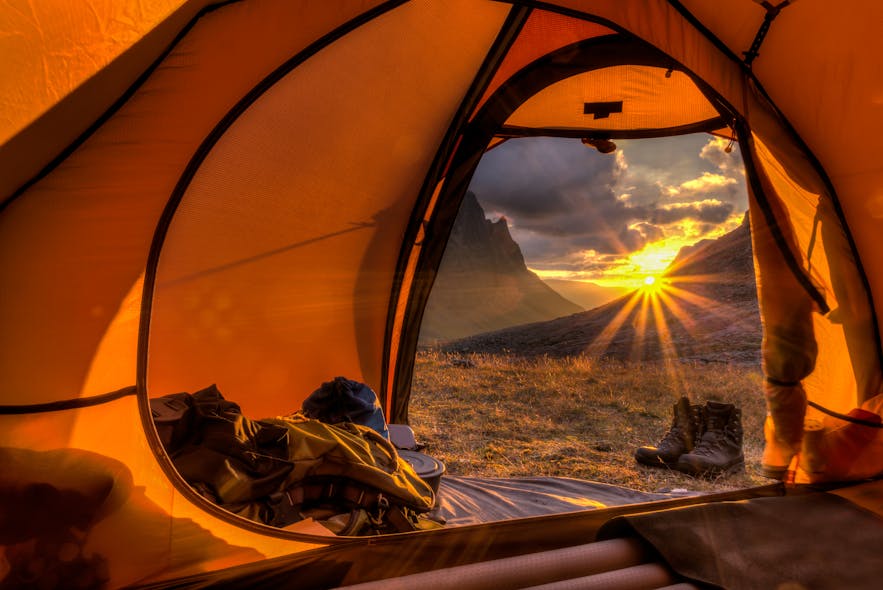
There are also several campsites all over Norway that are cheap to stay at. At these sites, you often have the possibility to take a warm shower, clean your clothes and charge any batteries.
Also, due to "Allemannsretten", all public lands are free to access. This means that you don't have to pay an entrance fee for a national park and you're free to go mostly wherever you want. All we ask is that you treat nature with respect and do your best not to leave any traces behind.
It's true, Norway has the best salmon. In fact, it was Norwegians who introduced the Japanese to Salmon Sushi in the 1980's. That's how good our salmon is.
While salmon isn't cheap, make sure that you have at least one proper salmon meal in Norway even if you're traveling on a budget.
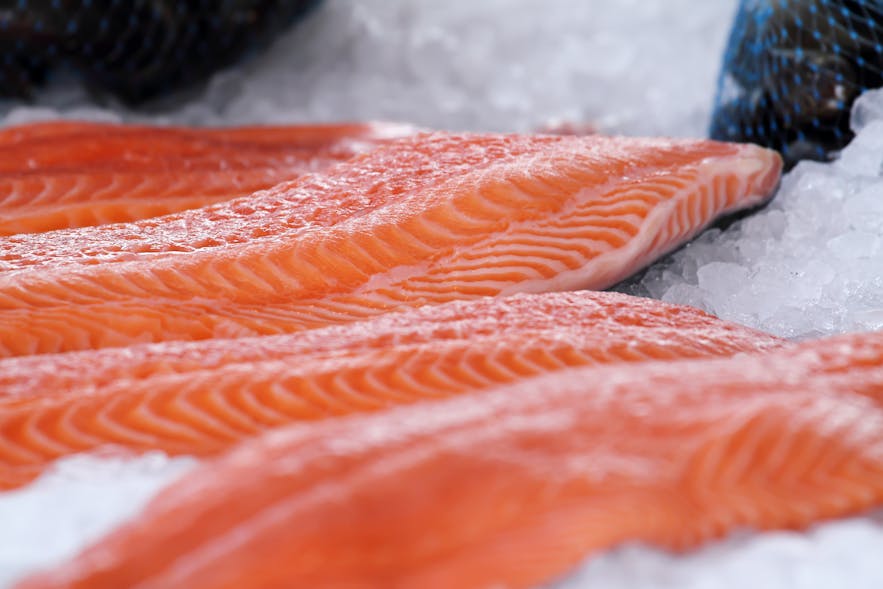
It's no secret that Norway is an expensive country to visit. Even though it's less expensive now that the Norwegian Krone is weak, it's not cheap. One way to avoid spending too much money during your travels in Norway is to eat less at restaurants. Purchasing your own food at a supermarket is much cheaper than going out every day. Unlike many other countries, Norway doesn't have a culture of going out to eat.
If you are traveling on a budget make sure that you read through our Norway on a Budget Guide .
12. Northern lights aren't visible everywhere
Are you dreaming of seeing the northern lights? Well, Norway is the right place to do it!
There's something magical about watching the sky turn into a green and purple formation dancing all over. I still remember the first time I saw it for myself, it was a moment that changed my life...
Many tourists come to Norway with the intent to see the northern lights . However, the northern lights (or Aurora Borealis) isn't visible all over Norway.
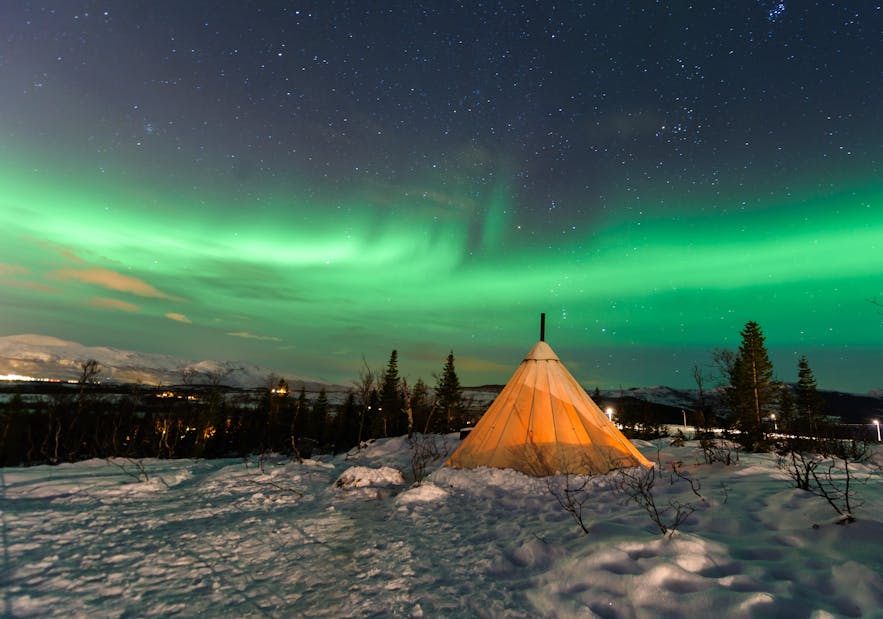
Since Norway is a long country you're normally only able to see the lady in green in the northern parts of Norway. The further south you go, the fewer lights you will see. Places such as Lofoten, Bodø and Tromsø are popular areas to watch the northern lights .
You should also remember that the northern lights won't be visible during the summer as it is too bright during that season. Typically, you've got the best chance of seeing some activity between October and April.
13. Norway is a Long Country
Another large misconception about Norway is that it's a small country which is easy to travel around. This isn't the case. Even though only 5 million people live here, it’s a large country by area (148 718 square miles) that stretches from 57° to 81° North. This means that you're not able to spend a couple of days in Norway and see both the west coast, capital and northern parts. In fact, driving from Kristiansand in southern Norway to Nordkapp in Northern Norway takes about 38 hours non-stop.
Therefore, you should plan your trip carefully and look at the distances between the places you want to go. If you want to see places in all regions I strongly suggest you spend some days extra or plan more than one trip.
- Press here for self-drive itineraries in Norway
- Press here for self-drive tours in Norway
14. There aren't Many Dangers in the Wild
Besides the Polar Bears on Svalbard, there are no dangerous animals waiting to attack you in the Norwegian wild. Either you're in the woods, on a mountain or on a glacier, you have nothing to fear.
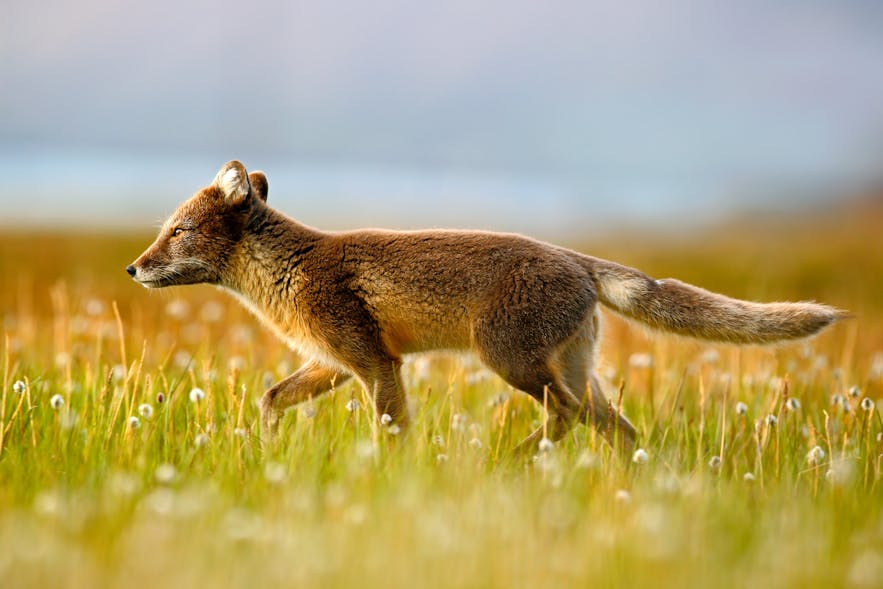
There are animals that you want to avoid but they will typically run away before you even see them. You can read more about wildlife and animals in Norway here .
If you visit a Norwegian family on a Friday evening the possibility is high that they are having Tacos for dinner. As a joke, it's said that Tex-Mex is Norway's national food. Yes, it really is that popular - even my grandma makes Tacos on Fridays!
(Ok, you might not have needed to know this but it's a fun fact that might work as an awkward icebreaker!)
Since Norway is such a long country it goes without saying that the differences are quite significant. In the southern Norway, you have beautiful coasts and warm (not tropical!) weather, the East has large areas of woods and the capital, the West has the fjords and mountains while the north has the arctic landscapes.
You might also notice that the dialects spoken throughout Norway are quite different and if you're just learning to speak some Norwegian it might be a bit confusing.
17. The Midnight Sun Isn't a Different Sun
During winter, northern Norway has polar nights; a period where the sun never rises above the horizon and you have 24 hours of dark. During summer, however, it's the exact opposite; the sun never sets.
You might have heard of the Midnight Sun before. Unlike what a few tend to believe, the midnight sun is actually not a different sun...it's just the same sun as during the rest of the year but it doesn't go down; meaning 24 hours of daylight.
- Press here for things to do in Oslo
- Press here for things to do in Lofoten
- Press here for things to do in Tromsø
Popular articles
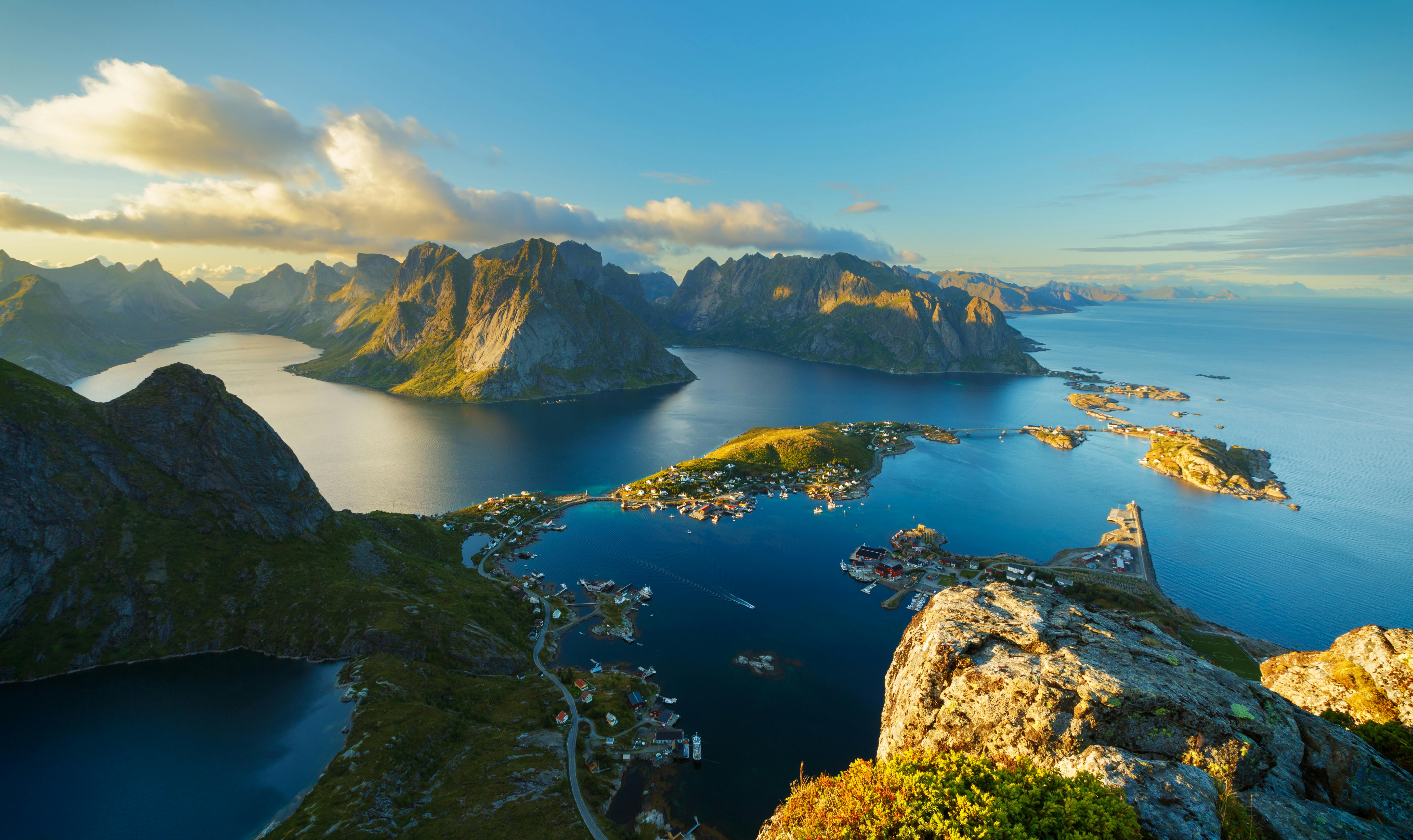
7 Amazing Hikes in Norway
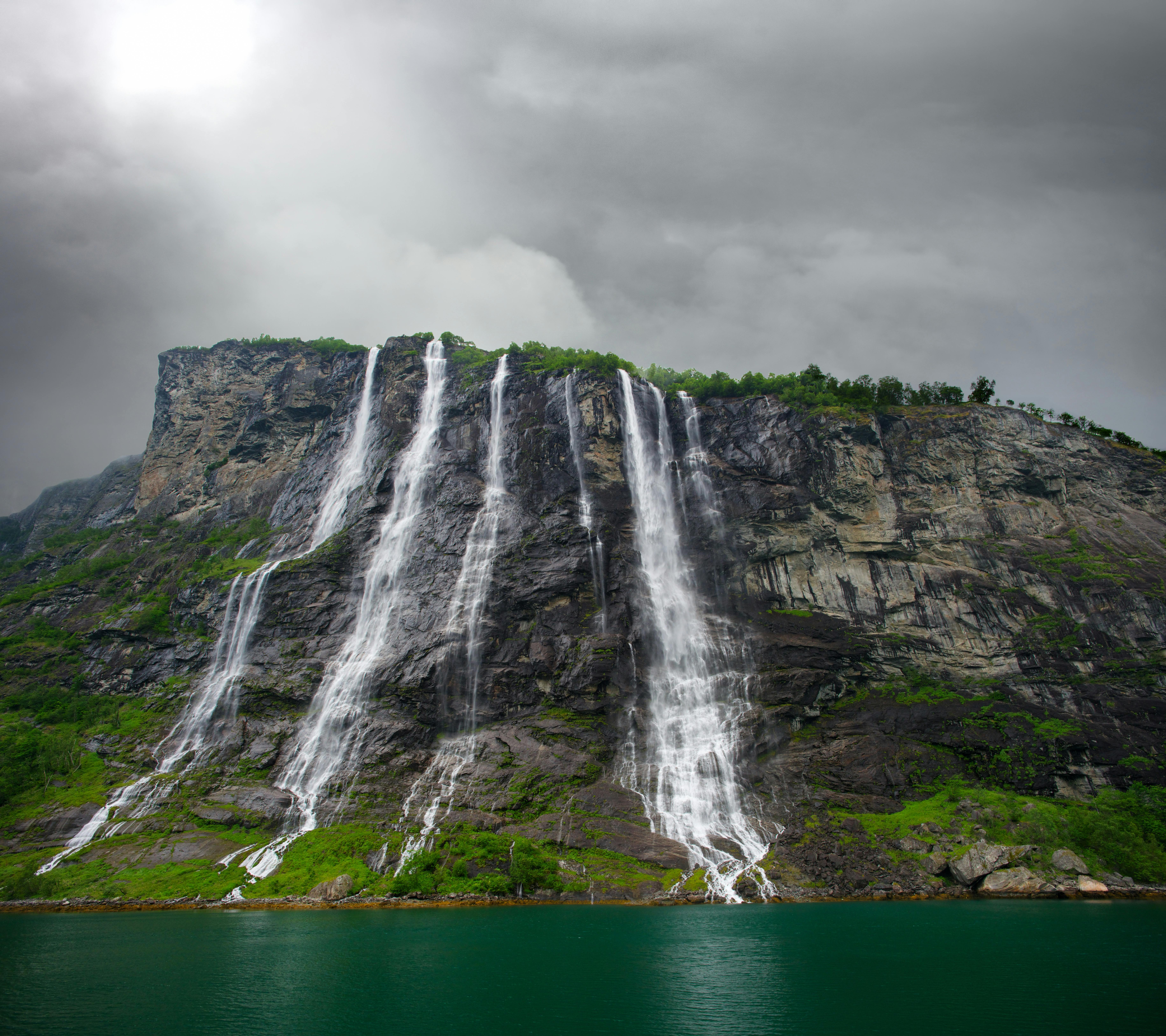
Top 10 Waterfalls in Norway
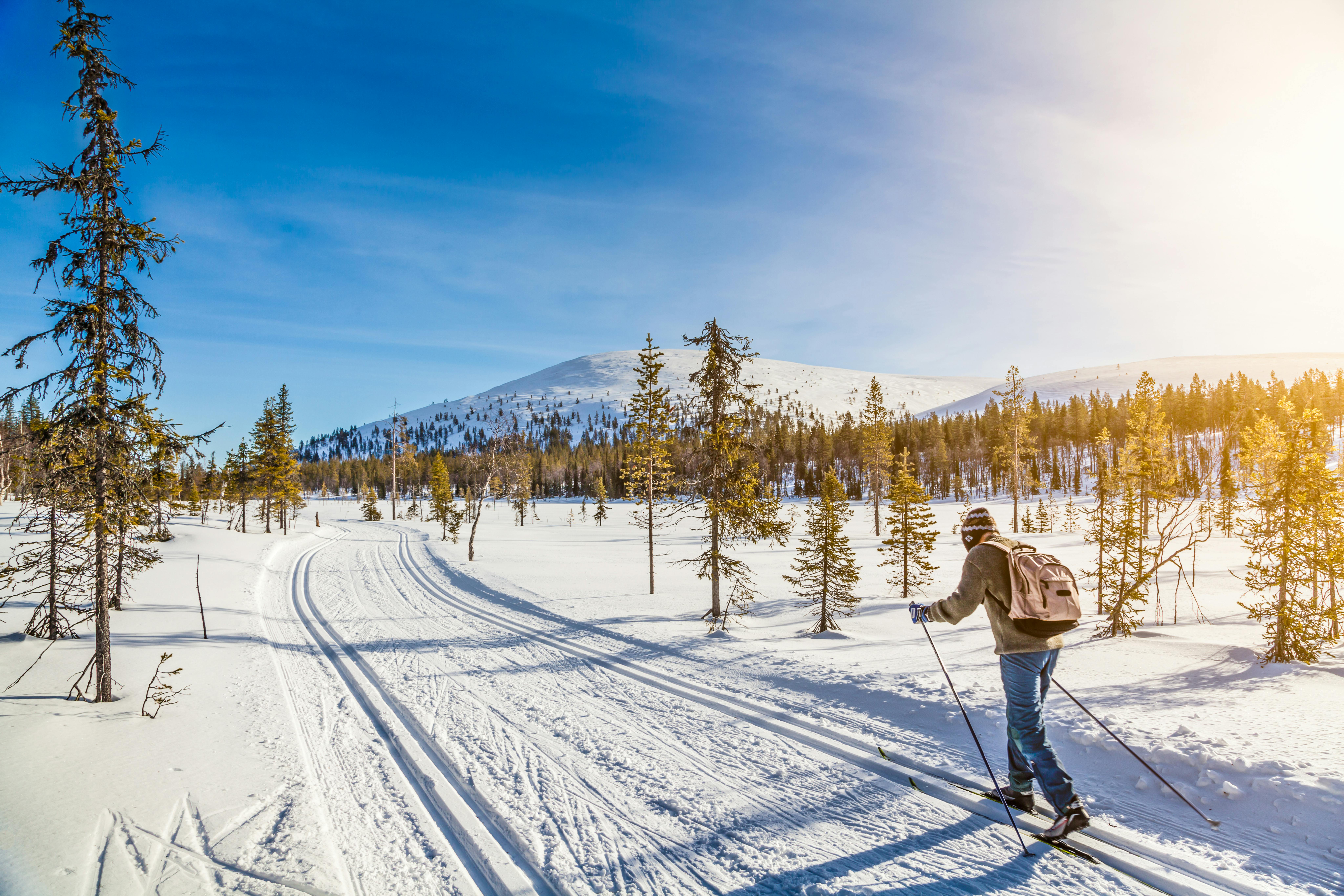
Top 10 Things To Do In Norway
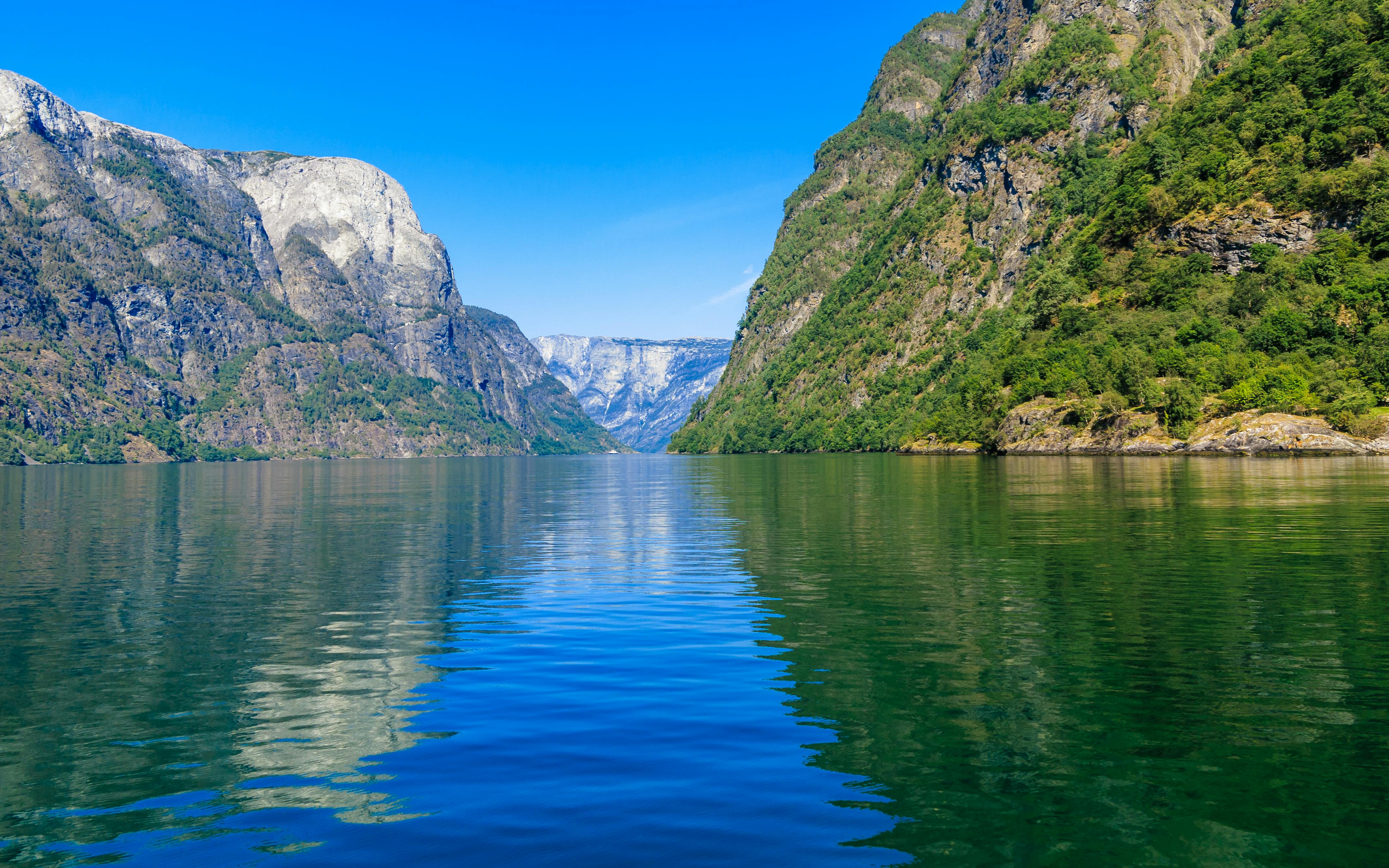
The Ultimate Countdown of Norway's Fjords
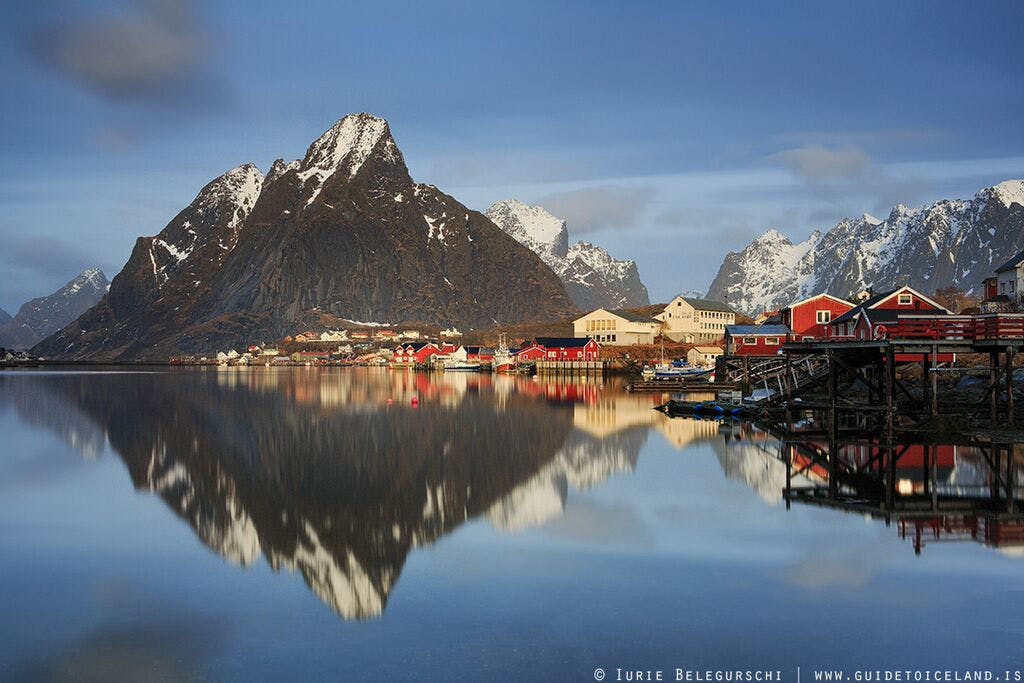
8 Things You Didn't Know About Norway
Other interesting articles.
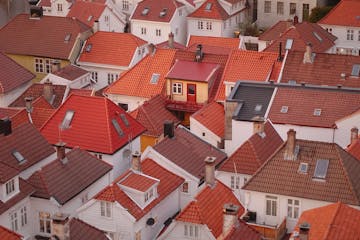
3 Reasons why Bergen is Ideal for Family Travel
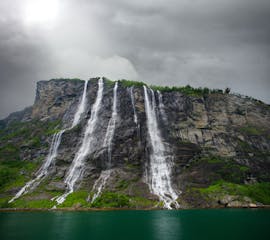
The Most Amazing Thing About Oslo (hint: It's not the Opera House)
Top things to do in norway.
Book your complete trip with the best companies only
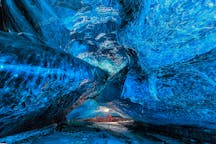
Adventure Tours
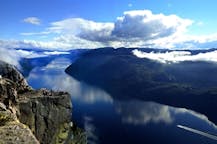
Fjord Tours
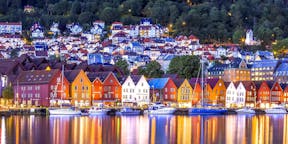
Vacation Packages
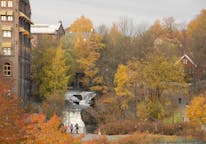
Biking Tours
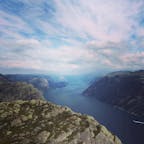
Sightseeing Tours
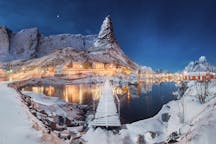
Lofoten Tours
7 Days in Norway Itinerary for the First-Time Visitors
Disclaimer: This article includes affiliate links to the products we earnestly love and recommend, meaning at no extra cost to you, we might make a teeny-weeny commission if you click on the link and decide to buy something. The money will be used to sustain this little cozy blog we call our virtual home.
Norway is vast with unlimited exploration opportunities that it’s not easy or I’d say it’s rather an overwhelming task to put together an itinerary that satisfies your travel goals. Norway has 5 regions viz. Northern Norway , Trøndelag , Western Norway , Southern Norway , and Eastern Norway , each more beautiful than the next, each has a different story to tell, and you’d find yourself dealing with the feeling of missing out while crafting 7 days in Norway itinerary.
I’m here to help you calm your anxiety levels by sharing a 7-day itinerary for Norway that’s just right for first-time visitors. It gives you a perfect introduction to the country in a limited time!
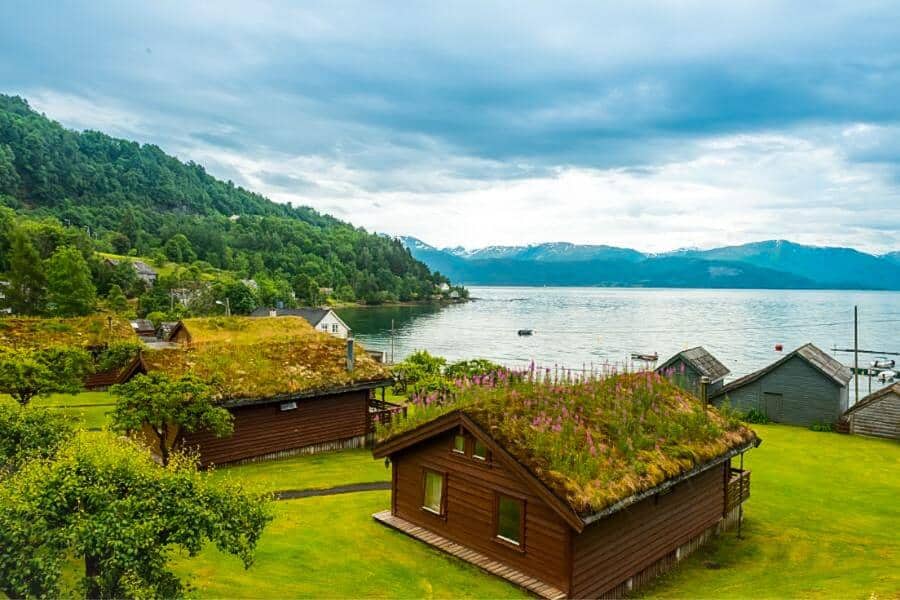
Norway Itinerary Map
7 Days in Norway Itinerary in Nutshell
Have more days in Norway? Read Our 2 Weeks in Norway Itinerary
Norway Itinerary 7 Days: Explore the Best of Norway in One Week
From storied fjords, majestic mountains, beautiful waterfalls, charming towns, and vibrant capital city to sweeping vistas – my Norway itinerary captures it all in 7 days!
Day 0: Arrive in Oslo
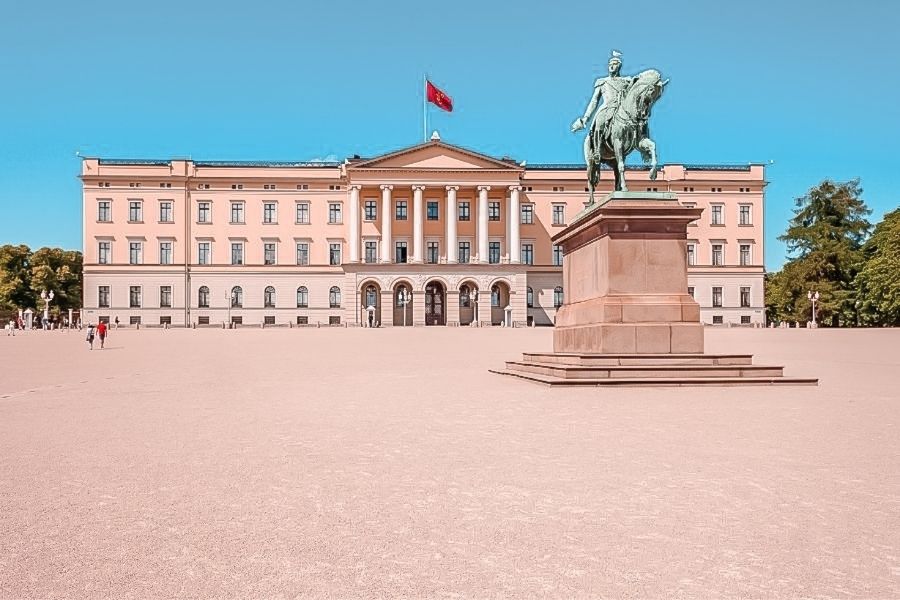
I started my Norway trip in Oslo, so would recommend you do the same. Norway’s fascinating capital and largest city, Oslo is where most of the international flights to Norway land.
To score the best flight deals to Oslo , I suggest you book your tickets 3 to 6 months in advance. Airlines like Norwegian Air and SAS frequently have competitive fares, especially if you’re flying from within Europe. Don’t forget to set up price alerts on Skyscanner to snag deals the moment they drop!
Olso Airport Transfer
Once you land in Oslo, hop on the Flytoget , a high-speed train that zips you from Oslo Gardermoen Airport to the city center in about 20 minutes.
The train runs every 10 minutes during peak hours and every 20 minutes during off-peak times. A one-way ticket costs around 230 NOK (roughly 19.92 EUR or 26 USD) per adult.
While Flytoget is a convenient and quick option, you can also take a regular NSB train , which is slightly cheaper but takes a bit more time. Taxis and airport buses are available too but expect to pay a premium for the convenience.
I you favor convenience and direct service like me, booking a private transfer is also an excellent, albeit more expensive, option.
Where to Stay in Olso
Make sure you book a hotel that’s right in the heart of the city so you stay close to where the action is. It saves you from the hassle of public transportation too.
I stayed at the Karl Johan Hotel with my family. Located on the main street in Oslo, the hotel scores points for its excellent location, welcoming staff, and value for money.
You can also check my guide to the best places to stay in Oslo .
Grab the best deals on accommodation in Oslo
What to do in Oslo on Arrival Day
You can spend the rest of the day depending on what your body says. If you feel tired after a long flight, you can rest and charge yourself up for the next day.
If you are restless like me and feel active enough to step out of the hotel, you can walk around exploring the city center. Stroll the Karl Johans Gate , Oslo’s main street, and stop by Slottsplassen to admire the Royal Palace .
You can check out the nearby buildings of Oslo City Hall , the Nobel Peace Center , and the National Theater .
If you are not having your dinner in your hotel, I’d recommend Katla , a unique dining experience right in the heart of Oslo. I loved dining here and enjoyed their food and services.
Day 1: Explore Oslo
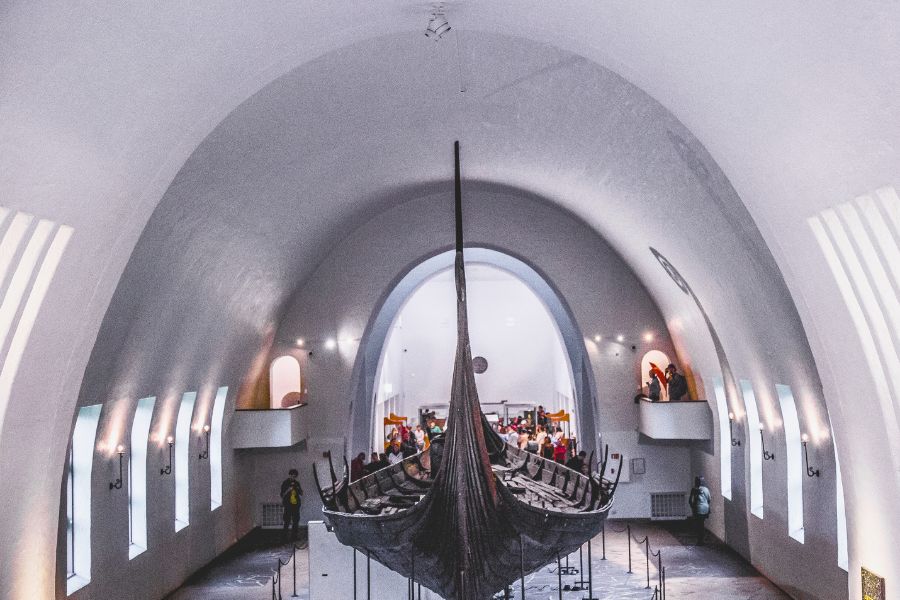
The best way to explore Oslo is by taking a guided walking tour , guided bike tour , or self-guided walking tour around the city. I almost always choose to take a guided tour, free or paid, as I feel it gives you a headstart in a new city.
The walking tour in Olso lets you admire the landmarks in Olso like Karl Johans Gate , National Theatre , University Place , Norwegian Parliament , Nobel Peace Center , Royal Palace , City Hall , and the National Museum .
There are so many fun things to do in Oslo . Here, you just have 2 days to discover the attractions in Oslo so I’d suggest starting your day with Akershus Fortress or Akershus Castle . The fortress not only offers a historical narrative but also affords spectacular views of Oslo and the fjord. You can join a guided tour to learn more about the culture and history attached to the monument.
After the fortress, enjoy the Oslofjord Cruise that takes you to the Bygdøy Peninsula .
Spend some time checking out one or two of the best museums on the peninsula – Kon-Tiki Museum, Fram Museum, Viking Ship Museum, and the Norwegian Museum of Cultural History .
📣 Heads-Up : If you’ve got your sights set on the Viking Ship Museum, you’ll have to hold onto that excitement a bit longer. The museum is under renovation and won’t reopen until 2025 or 2026. Breathe easy, though— Norway’s still brimming with Viking history to explore !
Given your time limit, choose the museums that pick your interest. All of them are equally fascinating and provide unique insights into Norway’s history and culture.
If you are a museum person, you’ll love Oslo has over 50 museums for you to explore. If you ask me, you must add a visit to the Munch Museum to marvel at Edvard Munch’s iconic works.
Or you can choose to take an island hopping tour that lets you explore the ancient islands of Hovedøya , Lindøya , and Gressholmen .
Come back and sit at one of the eateries by the Aker Brygge , a beautiful harbor front in Oslo to enjoy the views of the fjord while enjoying lunch at Louise Restaurant . And don’t forget to try gelato at Paradis Gelateria .
End your day with authentic Norwegian cuisine at Maaemo , one of the world’s best restaurants !
I suggest you buy Oslo Pass to make the most of your time in the Norwegian capital. The pass saves you a lot of time, money, and hassle. It’s all the more important when you’ve limited time to explore the city.
⛵ Read More: The Ultimate 3-Week Nordic Itinerary
Day 2: Explore Oslo
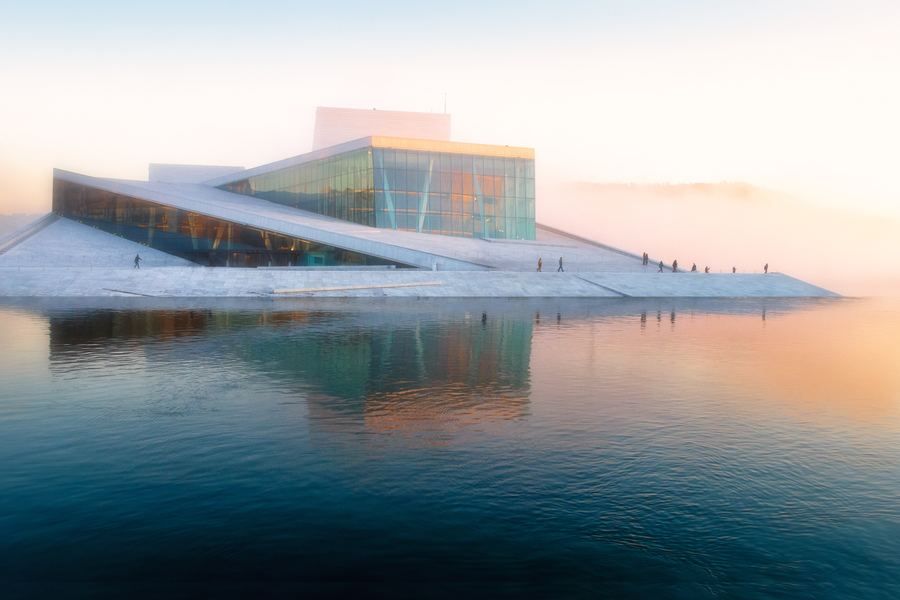
Start your day 2 in Olso with a visit to Vigeland Sculpture Park aka Frogner Park . With over 200 sculptures in bronze, granite, and wrought iron, it makes for an exceptional outdoor gallery.
Spend some time exploring the Oslo Opera House . Don’t just admire it from the outside, though—the roof offers panoramic views of Oslo! It’s an architectural marvel where you can literally walk on the opera.
You might want to take a quick detour to Barcode Project , a series of ultra-modern, high-rise buildings located near the Opera House, it gives you a taste of Oslo’s forward-thinking architecture.
Stop by Mathallen Food Hall for lunch. It’s a feast for the senses with all sorts of local and international culinary delights. Alternatively, you can try Vaaghals , a restaurant that blends traditional and modern Norwegian gastronomy.
Oslo is surrounded by nature, so take a short tram ride to Ekebergparken , a sculpture and national heritage park offering stunning views of the city, or maybe take a stroll along the Akerselva River .
For dinner, you can head to Arakataka for authentic Norwegian flavors or Oslo Street Food for a global culinary adventure.
Norway is one of the top coffee-consuming nations (one of the reasons it’s close to my heart), and experiencing the local coffee culture could be an intimate way to wrap up the day.
Day 3: Oslo to Bergen via Scenic Bergen Railway | Explore Bergen
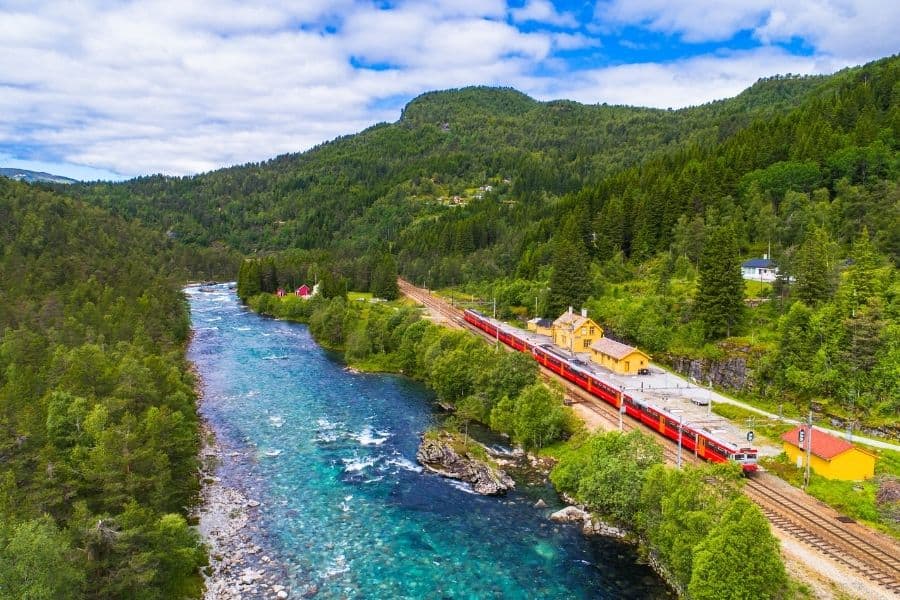
It’s time to ride one of the most scenic train journeys in the world, the Bergen Railway ( Bergensbanen )!
Grab a window seat and glue your face to the window for some of the most dramatic landscapes you’ll ever witness in your lifetime.
This beautiful train journey is a part of Norway in a Nutshell Tour where you get down at Myrdal to join the Flåm Railway ( Flåmsbana ), a short yet utterly picturesque train journey.
Tip: Make sure you book your tickets in advance. You must board the 8:25 am train so you can reach by 2:55 pm to have half a day to explore Bergen.
⛵ Read more about this enthralling train journey from Oslo to Bergen .
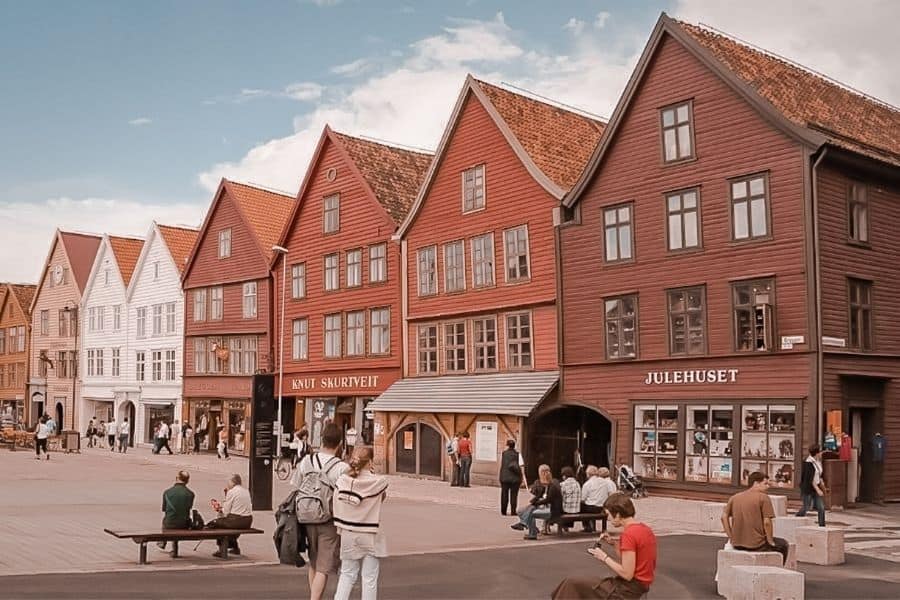
Check in your hotel (as always I recommend booking a hotel in the city center), freshen up, and get set to discover the capital of Fjord Norway.
Trust Me On This: Don’t forget your waterproof gear; Bergen is famous for its sudden showers.
Start your day with a visit to Mount Ulriken , the highest of the 7 mountains around Bergen. You can hike the mountain but it takes about 4 to 5 hours to complete the hike.
As you are short on time, take the Ulriken cable car up and down the mountain to enjoy the 360-degree views over the city.
Another not-to-be-missed attraction in Bergen is Mount Fløyen . It’s a beautiful hike provided you’ve time else you can take Fløibanen funicular to the mountain.
Come back down to the city center and spend your evening exploring Bryggen , a UNESCO World Heritage site that features pretty waterfront wooden houses dating back to the 1700s.
If you want to join a guided tour, this walk through the past and present of Bergen by I Love Bergen is perfect as it covers the most popular attractions as well as secret spots in the city.
Or you can join an all-inclusive guided tour that includes city sightseeing, a fjord cruise, and Mt Fløyen Funicular.
Taste the local seafood and experience the rich trading history dating back to the 1200s at Bergen Fish Market .
I stayed at Hotel Norge by Scandic . Located right in the heart of Bergen, the hotel is rated highly for its location, services, and food. It’s also one of the top picks by families with children.
Check out the best accommodation options in Bergen
Just So You Know: If you’re looking to explore beyond Bergen’s walkable city center, consider grabbing a day pass for unlimited bus and light rail travel. These passes can be easily purchased at tourist centers or via the ‘ Skyss ‘ mobile app, offering a cost-effective way to roam far and wide.
⛵ Related Read: Best Places to Visit in Norway with Kids
🚘 Looking for reliable & affordable car hire in Norway?
I trust and recommend Discover Cars , a leader in online car rental bookings! It promises transparency, security, convenience, and incredible savings.
Day 4: Bergen to Odda via Rental Car | Hardangerfjord Cruise
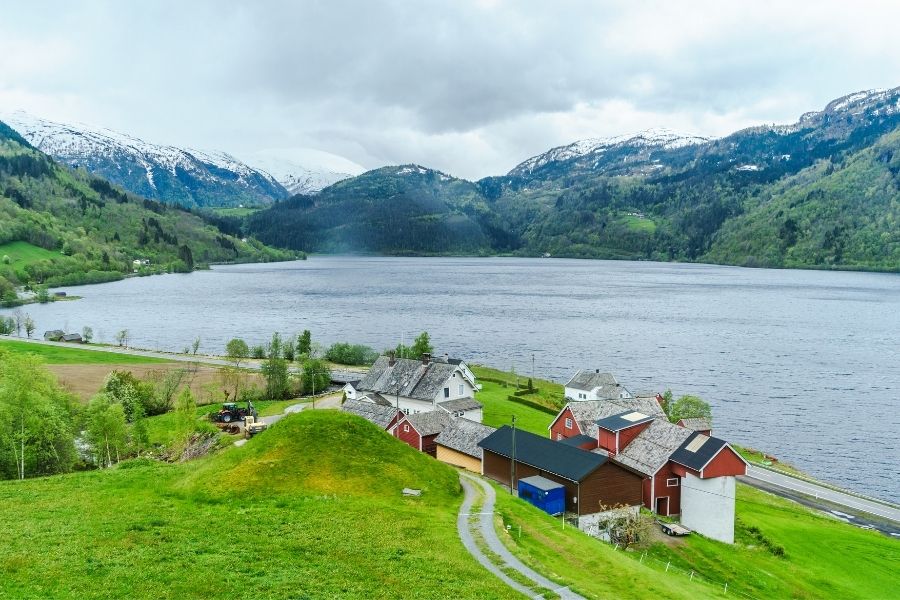
Pick your rental car to drive the beautiful roads in Norway. I completely rely on and recommend Discover Cars to rent a car wherever you go.
Find the best deals for car rental here . You should book well in advance to grab the low-price deals.
Road-tripping is one of the best ways to explore Norway. It’s a delight to drive along the road with breathtaking views of fjords, mountains, waterfalls, and glaciers.
A road trip from Bergen to Odda via Fv7 (this route includes the Tørvikbygd-Jondal ferry to cross the fjord) takes around 3 hours excluding the time to make stops along the way.
Don’t forget to pack some road trip essentials and a travel playlist with maybe classic Norwegian songs to set the mood.
There are many scenic stops (because, well you’re in Norway) along the way so it’s wise to allow yourself enough time to stop and take in the epic views.
One of the prettiest stops is the Steinsdalsfossen waterfall in Norheimsund.
Once in Norheimsund , take the fjord cruise on the Hardangerfjord aka the queen of the fjords with gofjords .
Cruising along the fjord, you’ll witness charming villages surrounded by steep mountains with snow-covered peaks and majestic waterfalls. You’ll also be able to see the Folgefonna glacier .
You’ll make a stop at Eidfjord to visit the Norwegian Nature Center Hardanger and the stunning and largest waterfall in Norway, Vøringsfossen .
Come back to Norheimsund to pick up your car and continue your drive to Odda. Once in Odda, make sure to check out Låtefoss waterfall in Oddadalen aka the Valley of Waterfalls .
Tip: If you love national parks , then you may want to consider visiting one of the national parks near Odda – Hardangervidda National Park and Folgefonna National Park .
I stayed at the Tyssedal Hotel , located by the Hardangerfjord at the foot of the Hardangervidda Mountains. It’s about 6 km (3.7 miles) north of central Odda.
Just about 7 km (4.3 miles) from Skjeggedal, the starting point of the Trolltunga hike, the hotel serves as a perfect base for those who want to do the Trolltunga hike.
Find the best deals on accommodation near Trolltunga
⛵ You Might Like: Beautiful Norwegian Words
Day 5: Hike Trolltunga

Today, you’ll experience one of the most scenic and popular hikes in Norway, Trolltunga.
Literally translating to troll tongue, it’s a cliff located at about 1,180 meters above sea level shaped like the tongue of a troll that extends out from the mountain.
From the main trailhead in Skjeggedal , the hike is 28 km (round-trip) and can take anywhere between 10-12 hours to complete depending upon the stops you make.
There’s another trailhead at Mågelitopp from where the round-trip hike is 20 km which can take about 8 -10 hours to complete.
The hike is long and arduous but worth it. The views from the top are magnificent! Nothing matches the joy and thrill of standing on the edge of the cliff and looking down at the crystal blue fjord right below.
- You must be well-equipped and well-prepared for the hike. Wear sturdy hiking boots and a wind and waterproof jacket. Pack some warm clothes because it gets cold as you gain elevation. Carry food and plenty of water. Once you’re on the trail, you’re on your own in terms of food and water, so pack wisely!
- There’s a small kiosk near the Skjeggedal trailhead where you can grab some basic snacks or a hot beverage before you begin the ascent. It’s a great spot for those last-minute munchies or for filling up your thermos with some hot cocoa or coffee.
- It’s best to take on this hike during the summer months of June, July, and August.
- Start early so you can get back before it gets dark. Plus, there is a limited number of parking spots at Skjeggedal and Mågelitopp so reaching early guarantees you a spot.
- If you want to leave your car at the hotel, there are shuttle services from Odda to Tyssedal and Skjeggedal and a shuttle bus from Skjeggedal to Mågelitopp.
- There are cliffs and fencing is missing so exercise caution.
- Don’t forget to check the weather forecast before embarking on a hike. Be aware that weather conditions can change quickly so be ready to handle the weather changes.
- I recommend you join a guided hike especially if you are not an experienced hiker as the local guides know the business in and out.
Traveler’s Tip: If you aren’t a hardcore hiker and find Trolltunga tough, the Buer Glacier is a good alternative. It’s a shorter trek, about 5 km round-trip, with fewer elevations but stunning glacial views. And if you want to skip hiking altogether, Odda Valley Museum , Agatunet , and Odda Church are some of the cultural gems in and around Odda.
Day 6: Odda to Flåm via Rental Car | Flåm Railway | Nærøyfjord Cruise

It’s not just another day in your 7-day Norway itinerary. It’s extra special. Today, you are going to meet the king of the fjords , Sognefjord , the largest and deepest fjord in Norway.
From cruising the wildest and most beautiful arm of Sognefjord, the UNESCO-listed Nærøyfjord to visiting a charming village of Flåm located on the other arm of Sognefjord, Aurlandsfjord to riding the scenic Flåm Railway to visiting a Viking village of Gudvangen located at the end of the Nærøyfjord to driving one of the steepest roads in Northern Europe, Stalheimskleiva that offers the scenic stops like Stalheimsfossen and Sivlefossen waterfalls – today’s going to rock!
And you’ll make a brief stop at a fairytale village of Undredal during your Nærøyfjord cruise with Heritage Taste Fjord Safari .
Stalheimskleiva is a little detour when driving from Odda to Flåm. Make a stop at Gudvangen and visit the Viking Valley .
Once in Flåm, board the Flåmsbana (Flåm Line) between Flåm and Myrdal. This 20 km long railway line lets you experience nature at its best coupled with historical cultural landscapes and the greatest engineering skills.
Flåm Railway Museum is a nice stopover before or after your Flåm Railway journey.
Known for its Viking-inspired ambiance, Aegir Brewery is the perfect place to enjoy some local brews and unwind after a long, adventurous day.
After a much-needed break, take a fjord cruise or fjord safari through Nærøyfjord. The 3-hour tour passes through tiny and charming fjord villages, endless waterfalls, majestic mountains, and mountainside farms. For me, this cruise was the best part of my trip to Norway.
The stories laced with Norwegian history and culture narrated by your guide keep you informed and entertained as you take in the beauty all around.
I booked Flåm Ferdaminne , a beautiful apartment with views of mountains and the ocean. The accommodation options in Flåm are limited so make sure you book well in advance.
Find the best deals for accommodations in Flåm
Day 7: Flåm to Oslo via Rental Car | Fly Back Home
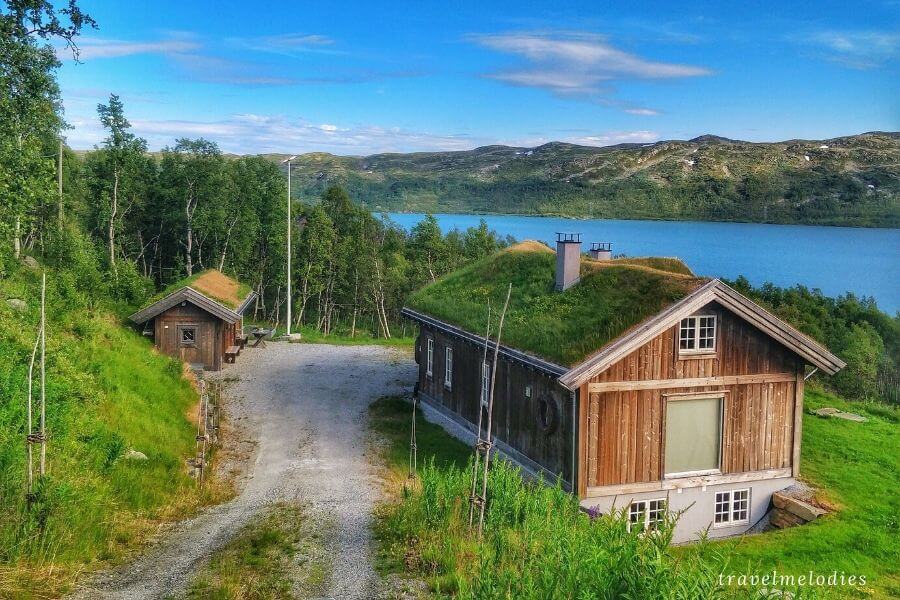
There couldn’t be a better ending to your last day in Norway than this gorgeous road trip.
The road trip takes you through fascinating tunnels, medieval churches, charming towns, mountain passes, national parks, and dramatic fjords – In short, it’s another chance to witness Norway in its insanely beautiful glory before you leave (of course, to come back again)!
As you start from Flåm, take a slight detour from E16 to visit Stegastein viewpoint . You can also check Otternes Bygdetun , a cluster of old farmhouses for a different perspective on Norwegian culture on the way.
The viewpoint is a part of the National Tourist Road , Aurlandsfjellet (the snow road) which runs from Arland to Lærdal and gives stunning panoramic views of Aurlandsfjord.
There are many amazing stops like the Lærdal tunnel , Borgund Stave Church , Gol Stave Church , many beautiful waterfalls, and lovely sights like the one in the picture above depending upon the route you take.
⛵ Read my article about a road trip from Bergen to Oslo to know more about the routes you can take.
The drive is long (can take more than 6 hours with pitstops) so I’d suggest starting super early. I started at about 7 in the morning, reached Oslo at 3 pm, and still had time to explore around as my return flight was scheduled at 9 pm.
Alternative Tip: You can book your flight back home the next day so you can take this road trip at a leisurely pace rather than rushing through it.
To be honest, 7 days in Norway is too short a time to grasp the beauty it holds. Be that as it may, wherever you go in Norway and for however long you spend in Norway, you’ll cherish the experience forever.
Norway Travel FAQs
What is norway famous for.
Norway is known for its pure wilderness. From otherworldly fjords, lush woodlands, Viking heritage, arctic nature, endless outdoor adventures, and happiness index ranking to breathtaking northern lights, unreal midnight sun, stunning islands, charming villages, scenic rail journeys, beautiful road journeys, and delicious cuisine – Norway is famous for all things bright, beautiful, and delightful.
Is 7 Days Enough in Norway?
7 days in Norway are good enough to experience the highlights of the country. My 7-day Norway itinerary lets you explore the best of Norway in one week. It includes fjords, cities, small towns, and villages, rail journeys, road trips, culinary experiences, and everything Norwegian.
Is Norway Expensive to Visit?
Yes, it’s one of the most expensive countries in the world but worth every penny you spend. Yes, it’s that beautiful! Having said that, there are ways to cut costs and save money like booking a vacation home rental, cooking your own meals, buying discount passes for attractions and transport, exploring on foot, and looking for free things to do in the country (there are so many.)
What is the Best Time to Visit Norway?
Norway is stunning no matter the season. Still, the best time to visit Norway largely depends on your reason for visiting Norway. If outdoor adventure is what you are seeking – With extra long days and pleasant weather, June to August is the best time to go. If you wish to catch the elusive Northern Lights, September to March will be your best option. The shoulder seasons of spring and fall bring limitless natural beauty all around and perfect weather and is a great time to visit if you want to experience the country crowd-free.

How to Get Around Norway?
With an efficient transportation network, it’s easy peasy to navigate Norway. Super reliable rail, road, and sea network makes it easy even to venture into the remote parts of the country. Every city, town, and village is armored with an excellent system of buses, trams, undergrounds, and trains.
NORWAY TRAVEL ESSENTIALS Here are the essential resources that I use and recommend while planning a trip to Norway. For travel insurance: Heymondo . It’s the most affordable travel insurance with maximum coverage. For Connectivity: Airalo . It’s the first-ever eSIM global website where you can buy an eSIM at affordable prices and stay connected while traveling. For booking flights: Skyscanner and WayAway . They are the best search/comparison flight booking sites that help you find the best and cheapest flight deals. And with the WayAway membership plan, you’ll get cashback for every booking. Plus, with the special promo code “MELODIES” a 10% discount is activated. For finding accommodations: Booking.com and Agoda . They are the pioneers among hotel booking websites that give you a lot of choices with their huge selection of properties reviewed by travelers. For rental car: Discover Cars . It’s the best international car rental platform for all your car rental needs. For ground transport: 12Go . It’s one of the most popular sites for booking bus and train tickets across various destinations around the world. For tours & day trips: Viator , Get Your Guide , and Klook . They offer the best city tours and day excursions in Norway. For guidance on the go: A Lonely Planet Guidebook for Norway comes in handy here.
Save Our Guide to 1 Week in Norway to Pinterest

Anjali Chawla
31 thoughts on “7 Days in Norway Itinerary for the First-Time Visitors”
Norway is definitely somewhere I’d like to visit and this one-week itinerary looks amazing with stunning scenery, hiking a scenic train journey and Oslo. What’s not to like…though maybe a bit more time would be good! Thanks for sharing!
Thanks Linda. Absolutely Norway is a destination everyone must visit. The scenic train journey was a highlight of our trip. There is so much to see in Norway, you can definitely add more days to the itinerary. Hope you can take your trip sometime soon.
An amazing way to spend 7 days in Norway!
Thanks for reading and appreciating.
So many things you mention in this itinerary are on my list of things I want to see when I get to Norway. This itinerary will come in very handy.
We are so glad that you found the itinerary helpful. It keeps us motivated to write more. Thanks
Norway is so so beautiful. Sometimes, I wonder if a place like that exists in reality. Keep up the awesome work.
Yes indeed Norway has stunning natural beauty that’s mesmerizing. Ha ha, you must visit to check for that. Thanks for spending time and liking.
I visited Oslo when my children were little. They were delighted to run in the outdoor sculpture garden. We even saw naked Norwegian children swimming in the fountains. Great post!
Looks like you need to go back and explore Norway again with kids now. They will hav so much more to do. Ha ha, you reminded me of kids swimming in fountain in Philly, US. Thanks a lot for appreciating.
I’ve been meaning to visit Norway for a while. Thanks for making my life easier with such a great itinerary. Loved the suggestions and pictures!
Made our day by saying this. Glad to hear that you found the itininary helpful. Do let us know if you need any more suggestions, would lov to help. Do shares after you visit Norway
Ahh, Norway is such a dream destination of mine! I loved this first-timer’s guide. It’s exactly what I need to get my feet wet. I love the variety of regions you shared. Thanks for the inspiration!
Thanks Elena for stopping. Glad you found it helpful and inspiring for you to travel. Do let us know if you need any help in planning your trip.
I think it would be awesome to be in Norway to view the Northern Lights. Have you seen them? Great post and ideas for future travel opportunities.
That’s next thing on our bucket list. After witnessing the midnight sun, now we are planning for Northrern lights in Norway. Fingers crossed. Will share our experience regarding that.
My goodness, I hope I never have to ‘do’ Norway in a week! A week in each region would be more doable. But I guess, if you are limited by time, this sounds like a good place to to start.
Thanks for sharing this itinerary, it is really helpful and motivator to travel Norway and the celtic countries, beautiful description with pictures and emotions. I am planning to visit these countries. Thanks for all your advices and tips.
Hey, so nice to come across this. We as a family of 3 who love travelling. Visiting Norway for the first time, I am doing all my research. I’ve bookmark this page 🙂
Few question if you don’t mind answering: 1. How does parking a car and paying for it works? Being in UK we have many restrictions and car parks do get busy quite quickly. 2. If we can only do 1 fjord cruise, which one you recommend from your experience? 3. Not sure we can Hike Trolltunga, any other options that you like to suggest.
Thanks again for writing this wonderful blog. I am looking forward to read more.
Thanks for getting in touch 🙂 You’d love Norway. It’s a stunningly gorgeous country. And we are glad that you found our blog helpful. Okay, now let’s answer your questions:
1. Norway is strict when it comes to parking rules. It’s definitely a challenge to find parking in the main Norwegian cities and if you do, it’s quite expensive. You can find metered parking along city streets, parking lots, and parking garages. Once you find the right parking space, make sure to display a parking ticket (you can get it from the nearest automated parking meter or P-automat) on your car’s dashboard. You must carry Kroner coins to use P-automat. 2. I’d recommend Pulpit Rock Hike as it’s the easiest yet the most beautiful hike ( I feel so) in Norway. 3. If you don’t want to hike Trolltunga, you can extend another day in Bergen and hike from Fløyen to Ulriken (Vidden).
Hope this helps.
Happy Travels!
I am glad I come across this blog, visiting Norway soon this will be handy. May I ask you how was driving in Norway specially parking at places? Is there a 1-2 hour hike you have tried that you recommend ?
Great post and I am looking forward to read more…
Hello! I know this is an old post but wondering what you’d add to this trip if you had 10 days? Also, we’re a bit too lazy for Trolltunga so we’d exclude that. Thanks!
With 10 days on hand, I’d add Stavanger, Geiranger, and Trollstigen to this itinerary.
Day 1: Arrive in Oslo | Explore Oslo Day 2: Explore Oslo Day 3: Fly To Stavanger | Explore Stavanger Day 4: Stavanger to Bergen via flight | Explore Bergen (Or you can spend another day in Stavanger and enjoy Lysefjord Cruise) Day 5: Explore Bergen Day 6: Drive from Bergen to Flåm via Gudvangen Day 7: Flåm Railway | Nærøyfjord Cruise Day 8: Flåm to Geiranger | Geirangerfjord Cruise Day 9: Explore Geiranger | Trollstigen Day 10: Geiranger to Oslo | Fly Back Home
You can get ideas from our 2 weeks in Norway itinerary . If you don’t want to hike Trolltunga, you can spend some more time in Bergen as the city’s charming and has so much to explore. Hope this helps.
Happy Travels 🙂
We have an opportunity to visit Norway in March. Our main goal is seeing the Northern Lights . Is this feasible ?
March, in general, gives a good chance to see the northern lights. The spring equinox brings peaks in aurora activity making it the best time to witness this celestial wonder.
I was searching on google for 7 days itinerary and woila your blog was so easy to plan . I am planning for Norway in Sept and you blog will be of utmost help. thank you Anjali.
Thanks for the encouraging words, Ankur 🙂 I’m glad I could help. Norway is a gorgeous country. You are sure to fall in love with it. Happy travels!
Wonderful post.
Any suggestions on easier hikes in Norway? Fairly flat, up to 5km roundtrip.
How easy is it to get one-way car rentals?
Vøringsfossen – Måbødalen, Kyllingdalen, Sognsvann Loop, Briksdalsbreen, and Ustedalsfjorden Loop are a few easy and flat hikes or walks in Norway that I know about. You can easily get a one-way car rental, however, it usually doubles the rental charges as they add a one-way drop-off fee.
Great effort. Drooling here about the prospect. I note in your 2-week Norway you created a google map. Can you/Have you done the same for the 1 week? Thanks. Warren
Thanks Warren! I’ve just added a google map in my 1 week Norway itinerary. Hope it helps.
Leave a Comment Cancel reply
© 2024 Travel Melodies. All Rights Reserved.
As an Amazon Associate, we earn from qualifying purchases.
- Search Please fill out this field.
- Manage Your Subscription
- Give a Gift Subscription
- Newsletters
- Sweepstakes
How to Visit Oslo, According to Someone Who Spent 6 Years in Scandinavia
Oslo, Norway, is a year-round destination — with saunas, fjord cruises, and fascinating museums.
Best Hotels and Resorts
Best things to do, best restaurants, best time to visit, how to get there, best neighborhoods.
Christopher Larson/Travel + Leisure
The mere idea of a summer day in a place like Oslo — home to subzero waters and black-metal music — might seem like a mirage. But the summers here are famously light and hot, with the Norwegian capital being an ideal playground for sunbathing, swimming, fishing, and hiking, replacing the darker months’ skiing, ice bathing, and roaring fireplaces.
Beyond its outdoor pursuits, Oslo 's eco-conscious efforts exceed most cities. In 2016, it introduced a “climate budget” with a goal of reducing emissions by 95 percent by 2030; two years later, 1,000 trees were planted for the Future Library project ; and in 2019, the city was crowned the European Green Capital .
Oslo’s young professionals and creatives may scatter themselves among the hip, diverse neighborhoods of Grünerløkka and Tøyen, or the more upscale Frogner and St. Hanshaugen (picture Parisian-like facades and tree-lined streets with mansions), but the main thing this city’s dwellers have in common is their commitment to time spent in nature. Visitors will find eco-friendly hotels committed to eliminating waste and championing reusable materials, restaurants that support third-world communities, and spas and saunas dispersed between the city’s central harbor and the dense surrounding forest.
At a time when travelers are becoming aware of how their leisure choices impact the environment, it’s interesting to see Oslo’s dedication to learning about and introducing the bigger ideas behind eco work. September’s Oslo Innovation Week, for example, is largely digital, with the aim of solving real global challenges through entrepreneurship, innovation, and green tech — the subjects of its panels include energy, circular economy, and life-science investment. For anyone interested in such, its panels and events make it a good time to visit.
For me, having spent six years in Scandinavia, and long summers and winters in Norway , Oslo became a base for months at a time. Most favor Danish and Swedish coastal cities for their accessibility. Like any capital, the Norwegian city is fast-changing and home to global diasporas that help shape the identity of this fjord-laden delight.
Top 5 Can’t Miss
- Any trip to Oslo calls for a bracing ice dip and sauna session.
- History buffs might note the elaborate original fixtures of Sommerro, a former electricity factory
- Restaurant Alex is the newest place to see and be seen, yet it's ultra-welcoming.
- Marvel at Vigeland, a park displaying nude sculptures.
- Go cross-country skiing or hiking, or simply enjoy the view from the top, at Nordmarka.
Francisco Nogueira
Not long after Sommerro's fall 2022 opening, the hotel and spa made its way on Travel + Leisure' s list of the 100 best new hotels in the world . Its electricity factory history is felt while the mid-century interior design and moody lighting offer a polished feel. The 231 rooms of various sizes include annexes, sloped ceilings, and exquisite upholstery, plus top-tier amenities and service. Don't miss the newly opened Izakaya, which serves a Nordic-Japanese menu.
Villa Inkognito
The next-door sibling property of Sommerro, Villa Inkognito is housed in a former private residence dating back to 1870. It was transformed into offices for the city’s first electrical company, and later served as the Algerian embassy. The 11-room retreat is also available on a full buyout basis for an ultra-special trip, and each room is meant to feel like a home away from home.
Amerikalinjen
This revved-up former Norwegian America Line headquarters toots its own stylish horn. The cheery staff resurrects the bustling energy of the storied spot , which is decked out in snappy tailoring from Norwegian fashion favorite Holzweiler. Guests can also expect a chic library, original elevators, and ceiling stuccos that remain across the rooms.
The Well Spa & Hotel
The Well Spa & Hotel provides a holistic approach to health — meaning uniform bathing suits and gowns, a zero-digital policy in restaurants and communal areas, excellent menus, relaxing treatments, and a decidedly tranquil feel in the stunning sculpture garden. Located in Sofiemyr, about 20 minutes from Oslo's city center via its own shuttle, the impressively vast property makes for a divine solo sojourn or a social spa trip.
Clarion Hotel The Hub
Located close to Oslo Central Station, Clarion Hotel The Hub stands out with its magnificent lobby showcasing marble features, a sumptuous bar, and refurbished rooms.
Taylor McIntyre/Travel + Leisure
With rugged natural terrain skirting the entire city, it’s no wonder most extra-curricular activities here revolve around getting outdoors. A winding, 20-minute tram ride up Nordmarka takes visitors to the place where the trees for Future Library are planted. Take the lift to ski jump Holmenkollen, then stop by Holmenkollen Restaurant for tartare, a hot toddy, and mountaintop views.
Sauna and Swim
In the winter, the adrenaline rush is rewarding, and come summer, the waters are refreshing. At Badstuforening , it's $25 for a two-hour communal seat; enjoy the peaceful camaraderie (and views) of this sweet setup. Just make sure to bring a towel. Alternatively, try Salt , a sauna and art space that's set opposite the Snøhetta-designed opera house and hosts concerts, plays, and exhibitions.
Museum Hopping
Explore the intricate history of explorer life at the Fram , which contains the reconstructed remnants of the ship that raced to the South Pole, headed by Norwegian adventurer Roald Amundsen. In the center of town, check out the Nobel Peace Center for its permanent and roving collections of significant human rights accomplishments. An unsung gem is the Emanuel Vigeland Museum , complete with frescoes and gong bath concerts. Tip: Plan in advance planning due to the location's unusual opening hours.
Silent Fjord Cruise
Take a silent electric fjord tour on the Brim Explorer , with multiple options to suit your mood. There’s yoga on the deck, an elegant brunch, or a dinner cruise. Other perks of this slick and small liner include less crowds and an intimate setting for your crew.
Courtesy of Restaurant Alex
Restaurant Alex
An overnight success with everyone from students to billionaires, this restaurant calls for advance reservations. Emerging chef Alexandra Ek guides a well-priced brasserie-style menu, while the resident DJs don’t frown upon dancing on tables after hours.
Sabi Omakase
Japanese cuisine this far from East Asia has a terrific head start thanks to the abundance of cold sea. At Sabi Omakase , guests can expect a carefully composed seasonal menu that's served in a harmonious, low-lit space. Interestingly, the chef used to be a surgeon — the locale and its offerings are not remiss of precision, and, yes, you’re safe in his hands.
Solsiden Restaurant
Solsiden is a fail-safe institution for seafood on the water, dapper and light-filled with its glass structure. Put on a pretty dress or shirt and enjoy the harbor breeze at this summer-only restaurant. Order the renowned shellfish tower and the Champagne.
It’s no secret Norway can whip the wallet. This fresh and lovely Asian noodle joint is a way of preserving splurges for another day while still giving you the opportunity to eat well. Plus, every purchase feeds a child in Africa, where founder André Evju spent lots of time.
Plant-filled with kitschy white tiles and pink lighting, Njokobok offers Senegal-style community dining. Order the jollof rice, grilled dorada, or whole lamb and indulge in the location's famous onion sauce three ways. Oslo has a sizable African diaspora, so you'll find good Ethiopian, Eritrean, Moroccan, and Somali restaurants throughout the city.
Christopher Larson/Travel + Leisure
While winter is for snow and snuggles, summer in Oslo is all about swimming and seafood.
Spring (or shoulder season), meanwhile, is ideal for soaking up art, history, opera, and the boutique shops. June through September sees music festivals such as By:Larm and Øya , and winter is prime time for ski tournaments, cozying up in a cabin, and cold-weather rituals like ice bathing and relaxing in a sauna.
The main thing to consider is winter's darkness — there are nearly 20 hours under cover, compared to summer’s two-hour nights.
Flying into Gardermoen is ideal for easy access into the city — it's about 20 minutes via speed train. Arriving at another airport means a long bus ride to the city, so don't be duped by the cheaper inter-European flights to Torp Sandefjord Airport. Another way to arrive is by cruise — check out eco operators such as Hurtigruten. You might also consider the spectacular, nearly eight-hour, cross-country Bergen Line route — often dubbed one of the most beautiful train rides in the world. If you're arriving from elsewhere in the country, domestic airline Widerøe is a great option.
Andrea Pistolesi/Getty Images
This east-of-central pocket is having a resurgence, thanks to the introduction of some trendy bars and restaurants, but its leafy, suburban feel is enduring. In addition to its waterside location, there are gorgeous local bistros, Frogner Church, grand foreign embassies, and lots of indie cinemas here. Plus, you're still a stone's throw from the theaters, palace, Litteraturhuset (House of Literature), and Vigelandsparken (Vigeland sculpture park).
The peninsula of Bygdøy has not only amassed some of the capital’s best museums and relics, but it’s also home to idyllic beaches — Huk, Paradisbukta, and Bygdøy Sjøbad — for swimming and picnicking. For something a bit more cultural, browse the collections at the Fram, Norwegian Maritime Museum, Oscarshall, or Norwegian Museum of Cultural History. The Gol Stave church is also a must-see.
Day Trip to Drøbak
The wider area of Oslofjord is full of small towns, and picturesque-as-they-come Drøbak is a wonderful jaunt for the day. Just a 40-minute drive (or 90-minute scenic ferry ride) outside of Oslo, Drøbak is home to the dramatic Oscarsborg Fortress , great shellfish in cute old buildings, a summertime opera, and even a quirky year-round Christmas shop.
How to Get Around
Once you arrive in Oslo via the Flytoget airport transfer, walking is doable and preferable to most. An Oslo Pass is handy for riding the tram, train, bus, and ferry. E-scooters can be less arduous than biking if you need to dash somewhere, but locals prefer a more relaxed and measured approach to getting around.
Related Articles
- Skip to primary navigation
- Skip to content
- Skip to primary sidebar
- Skip to footer
Heart My Backpack uses affiliate links, which means that if you make a purchase through my links, I may earn an affiliate commission.
My Top 30 Norway Itineraries – Two Days to Two Weeks in Norway
April 20, 2023 by Silvia 49 Comments
I’ve made so many trips around Norway in the past six years I’ve been living here, so I thought it could be helpful for me to gather all of my itineraries in one place. I also find that I often get questions from people trying to organize their Norway trips that I’ve already answered in past itineraries, so I wanted to make it easier to find all the information in one place.
Okay, so here’s a collection of all my top Norway itineraries, organized in order of length.
I’ve started with weekend trips, where I’m just giving suggestions for single places to visit, but if you scroll farther down I’ve linked my longer one and two week+ itineraries later in the post.
And of course if you have lots of time you can mix and match these destinations and itineraries to fit your schedule! Just keep in mind that Norway is really big. Like I think people way underestimate its size because we’re only five million people here.
I can’t tell you how many people have come to me saying they have five days in Norway and will start in Oslo, then get the train over to Bergen and then drive up to Tromsø to see the Northern Lights. Um, Bergen is an overnight train journey from Oslo, and driving from Bergen to Tromsø will take you 28 hours without stops .
And no, sadly Norway’s train line does not go all the way up to Tromsø – it ends in Bodø.
If you want more in depth advice, I’ve also gathered all my best tips for planning an incredible trip through southern Norway (from the far south up to Trondheim) in a 93-page ebook that covers my top recommendations for places to visit (both on and off the beaten path), the best times of year to visit, how long to visit for, the best accommodation choices, transportation, what to eat, what to pack, and a sample itinerary that covers my personal favorite route through the south. You can purchase The Southern Norway Travel Guide here .
And if you’re coming to Norway for the northern lights, I’ve written an in depth ebook covering all aspects of planning your northern lights trip, including the best places in Norway (and the Nordics) to see the northern lights, the best time to see the northern lights, my top northern lights accommodation choices, tour options, how to chase the northern lights (including which apps I use), how to photograph and film the northern lights, what to pack for your trip, and other exciting Arctic activities to try on your trip up North.
If you want to ensure you have the best northern lights trip possible, you can purchase the ebook here .
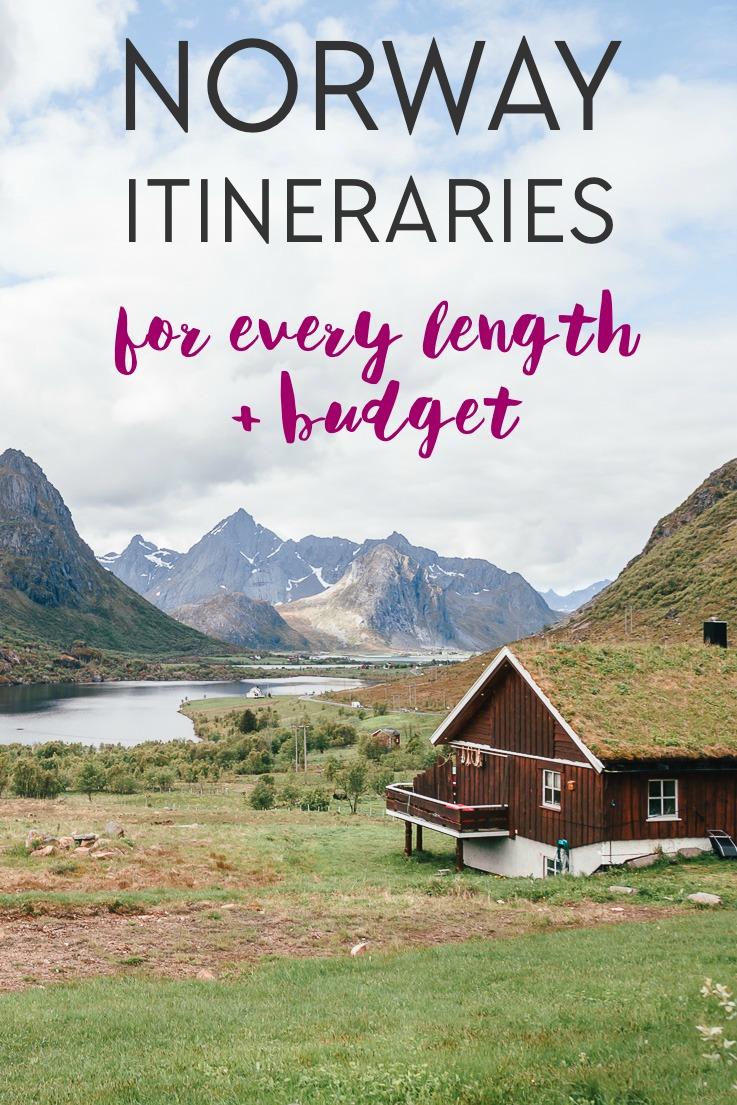
Table of Contents
Norway Weekend Itineraries
If you’re coming to Norway for just a weekend I’d really recommend sticking to one place. Norway is a big country, public transport doesn’t run that often and can have delays, and moving around to a bunch of places in a short time frame can get expensive.
That said, you could also consider renting a car and exploring a bit of the area if you can, as the best part of Norway is getting out of the cities and towns and seeing some of the beautiful nature here. Norway is also an easy country to drive in, as there is so little traffic here.
Though if you get motion sickness definitely bring some tablets or Sea Bands , as the winding roads here can do a number on your stomach! I’ve written a more detailed guide to things to know when planning a road trip in Norway here .
Sometimes I feel guilty when I’m in Oslo because it’s such a fun city, but I am always telling visitors to Norway to skip it, or at least cut their time there short.
Oslo is fun for locals and the only city in Norway that actually feels like a big city, but there are a lot of other cities in Europe that do what Oslo does best even better. In other words, Oslo is a great city for Norway , but I wouldn’t necessarily consider it one of Europe’s great cities.
And that’s totally fine, because Norway isn’t really about cities.
Okay, maybe I’m being harsh, and maybe it’s because I’ve received too many messages from people telling me how disappointed by Oslo’s “fjord.” Yes Oslo is technically on a fjord, but if you’re looking for those famous mountainous fjords you’re going to need to head west or north.
But if you do have your heart set on Oslo, it does have some great shopping, amazing restaurants, sort of okay nightlife (lol), and lots of museums. You won’t be bored. I’ve written about things to do in Oslo here , the Oslo Christmas markets here , and a guide to finding the best Oslo accommodation for your budget here .

If you’ve found a cheap flight to Oslo for a weekend trip but now I’ve scared you off spending all your time there, consider spending a night or two in Rjukan! You can book a bus to Rjukan here , but I’d really recommend renting a car if you can, as the drive to Rjukan via Gaustatoppen is truly spectacular.
Rjukan is a quirky mountain town with an important World War II history. It’s also listed as a UNESCO Industrial Heritage Site and it’s really cool to see the old factories and worker accommodation.
But I also love that it’s at the foot of both Gaustatoppen, one of Norway’s most beautiful mountains, and Hardangervidda, Northern Europe’s largest high mountain plateau (which is also home to Norway’s largest herd of wild reindeer).
I used to live half an hour from Rjukan so I visited the town many times (and even briefly considered moving there), and I’ve written a guide to things to do and where to stay in Rjukan here .
This would be an especially great place to visit with kids, with lots of fun sites like the Krossobanen cable car, the Gaustabanen funicular, and the Vemork WWII museum.

Bergen is probably the most popular destination for a weekend trip to Norway – and for good reason. The city is gorgeous (sorry Oslo, but Bergen is way prettier), and there are loads of international flights here.
This is also an easy base from which to take a day trip out to the fjords, and as it’s a big tourist hub there are lots of activities and tours organized out of Bergen. I’ve written a complete guide to Bergen here and a guide to planning a road trip from Bergen here .
This is also where you can take the famous Norway in a Nutshell tour, which goes up the Flåm Railway and through the gorgeous Aurlandsfjord. But! Before you book the tour, read this to find out how you can save tons of money on Norway in a Nutshell.
If you want any easy weekend destination in Norway, Bergen is perfect. You’ll get a very Norwegian experience and everything is set up perfect for tourists, from all the lovely hotels here to the unique activities and adventure tours offered here.

Hardangerfjord
If you fly into Bergen, you could also rent a car and drive down to Hardangerfjord to spend a night or two.
Hardangerfjord is beautiful and so peaceful, especially in the spring when the orchards are in bloom. I’ve written more about driving through Hardangerfjord here .
And if you do spend the night here, I can recommend staying at Utne Hotel, which dates back to 1722 and is perfect for anyone who enjoys unique, historical accommodation. Check current rates and availability here
Or if you want something a bit cheaper but equally lovely, stay at Ullensvang Gjesteheim, which is in the prettiest part of Hardangerfjord. Check current rates and availability here
A lot of people head here to hike Trolltunga, or the famous Troll’s Tongue that you’ve probably seen all over Instagram and Facebook. Just be aware that it’s an advanced level hike and extremely popular – these days you’ll usually find a long line of people waiting to take photos on the rock. You can read more about hiking Trolltunga here .

Whenever someone asks me where they should go in Norway if they only have a few days, I tell them to go to Ålesund or Lofoten.
Ålesund really gives the best introduction to Norway, because you get to experience a Norwegian city and then you can drive up to Trollstigen for those amazing mountain views, and then over to Geirangerfjord to see Norway’s most beautiful fjord!
Ålesund is such a beautiful city, and the surrounding nature is seriously stunning. Like, I definitely think this is one of the prettiest corners of Norway, and I’m always shocked that most tourists choose to visit Oslo and Bergen instead. I’ll never understand.
But that’s also good news for you if you like to get off the beaten path a bit!
Ideally I would recommend spending a night or two in Ålesund and then renting a car and spending a night or two in a quieter area on the fjords. I’ve written a guide to things to do and where to stay in Ålesund here , and where to stay around Geirangerfjord here .

Another great weekend destination in Norway is Trondheim – my old home!
Trondheim has a rich history and in fact at over 1,000 years old Trondheim is the oldest of Norway’s major cities. It was the religious center of Northern Europe during the Middle ages and has a beautiful old town and Norway’s most impressive cathedral, Nidaros Cathedral.
It’s a really walkable city and the airport is just a short bus or train journey away, so it’s definitely one of the easiest places to spend a weekend in Norway.
Trondheim is a big foodie city with several award-winning restaurants, so if you like to go out to eat, Trondheim is perfect.
It’s also a university city so there’s a great young vibe here and lively night life. And then of course the old town area Bakklandet is one of the prettiest corners of Norway.
I’ve written a guide for things to do in Trondheim here , and where to stay in Trondheim here .
Trondheim – Oppdal
I’d say the only thing missing with a weekend trip to Trondheim is that you don’t really get to experience Norway’s beautiful landscapes. I mean, the city is on the coast and there is a lovely park area to go hiking in above the city, but it’s not the sort of dramatic landscape that Norway is so famous for.
But if you wanted you could spend a night or two in Trondheim (I’d say one full day in Trondheim is plenty to see the main sights) and then rent a car and drive down to Oppdal. I spent a weekend here while living in Trondheim and it’s one of my favorite memories from my time there.
The drive is beautiful and the scenery there is amazing as you climb up into the mountains. This is the perfect place to experience Norwegian cabin life, just relaxing inside at night and hiking or skiing during the day, and there are lots of cabins available on Airbnb, like this big cabin and this traditional Norwegian cabin .
This is the ultimate Norwegian experience, because this is how Norwegians spend their free time in Norway – in their cabins!
Trondheim – Røros
Another great combination with Trondheim would be to take the train down to Røros. This old copper mining town is a UNESCO World Heritage Site and truly like nowhere else in Norway. It’s especially beautiful in the winter, as it gets lots of snow and is even known as Norway’s “Christmas town,” but I visited in late spring and loved it then too.
I’ve written more about visiting Røros here , including where to stay and eat.
Like I already said, when someone says they only have time to visit one place in Norway, Lofoten is one of my top choices.
I mean, Lofoten sort of has it all. Okay, it doesn’t have any big cities, but Svolvær is quite a large town with a lot going on, and then you’ll find mountains, beaches, fjords – you’ll even find people surfing here!
It also has a historical significance as a center for fishing, which is why the islands are covered in those iconic red fisherman cabins. You’ll get a great sense of Norway’s fishing history here, as well as the Viking history here.
But mostly, the Lofoten Islands are just really, really beautiful. In fact probably most Norwegians would say Lofoten is the most beautiful place in Norway, and I wouldn’t argue.
Lofoten has also grown in popularity in the past few years, and they’ve done a good job of keeping up with the increase in tourism by establishing more unique accommodation options and tour activities. There’s seriously so much to do here, and so many cool places to stay.
You could either fly into Bodø, rent a car there and take the ferry over to Lofoten, or fly into Svolvær and rent a car from there. It is possible to explore Lofoten by public transport, but you will be limited by bus schedules and will end up missing out on a few of the more off the beaten path areas.
I’ve written a guide to planning a Lofoten road trip here , a sea eagle RIB safari and Northern Lights chasing here , and horseback riding here . And here are 11 things to know before visiting the Lofoten Islands .

Helgeland Coast
I love the Helgeland coast and while you would need more than a weekend to properly explore it, you could very easily visit just one of the islands.
The Helgeland coast has the same dramatic landscape and fisherman cabins of Lofoten, without all the tourists. This is seriously such a hidden gem in Norway. I’ve also heard people say that the friendliest people in all of Norway are on the Helgeland coast. You will be warmly welcomed here!
You can fly or take the train to Bodø, and then from Bodø get the express ferry to Støtt. I’ve written more about Støtt, how to get there, and where to stay here .
Or you could get the express ferry to Lovund, another beautiful island on the coast. I’ve written more about Lovund, Norway here . Or if you have some extra time visit both Støtt and Lovund!
This would be a really unique weekend trip to Norway, as not many foreign tourists plan trips here. So if you like to get off the beaten path and discover the local culture, and if you love beautiful landscapes, definitely consider spending a weekend on one (or a couple) of these islands.
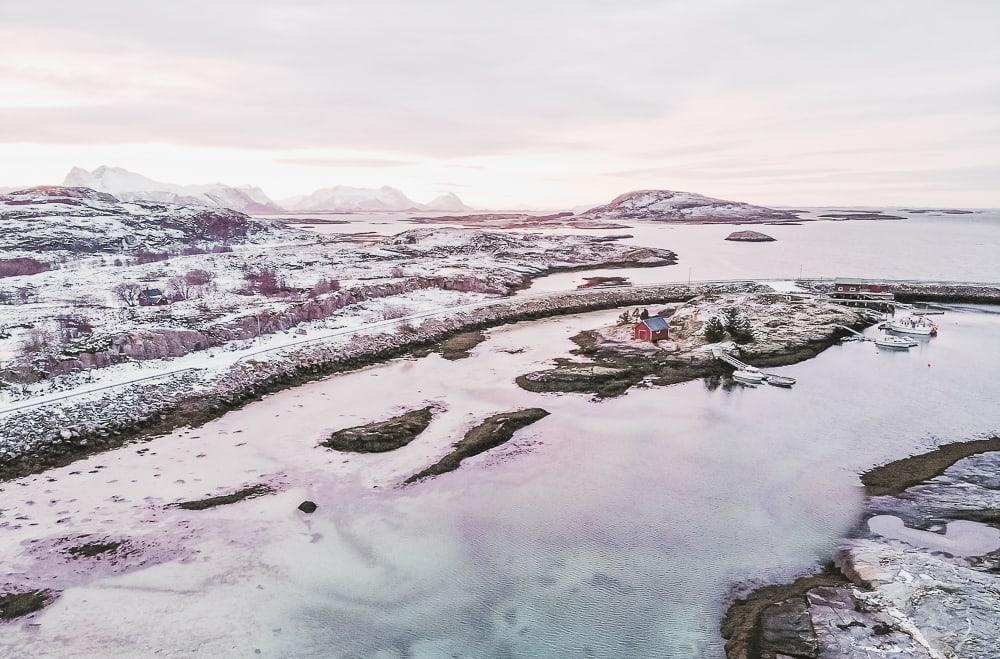
Tromsø, Senja & Dyrøy
After Bergen Tromsø might just be the second most popular weekend destination for tourists coming to Norway – at least in the winter during the Northern Lights season!
I’ve written more about things to do in Tromsø and where to stay here . To be honest I didn’t super click with Tromsø when I visited last summer and this past December, and I’ve heard so many locals complain that now it’s getting way too full of tourists. Then again I know a lot of people who absolutely adore Tromsø, so you might love it.
Update: it’s funny that I wrote that, because I’ve actually just moved to Tromsø!
But what I really loved was flying into Tromsø and then driving down to Senja and Dyrøy. The drive is beautiful and both islands are so magical.
You’ll probably only have time to go to one unless you take a long weekend (we had four nights so we flew into Tromsø and then spent two nights on Senja and two on Dyrøy). Senja has more dramatic scenery and famous hikes, while Dyrøy is the loveliest quiet escape into nature.
I’d say Senja will give you those big bucket list experiences with its Instagram famous hikes, whereas Dyrøy would give you a really authentic, off the beaten path local experience in Norway. I’ve written about visiting Senja here and visiting Dyrøy here .

There are lots of other nice places to spend a weekend in Norway as well, but these are the main ones I’d recommend, especially if you’re new to the country and want to see a highlight. I do include other spots in my longer itineraries for when you have more time to spend in Norway.
So I’m sorry if I missed out on your favorite spot – don’t be mad at me!
Five Days to One Week in Norway Itineraries
Bodø – helgeland – lofoten – vesterålen.
If you only have a week in Norway, I really recommend sticking to the north and skipping Oslo and Bergen altogether.
Okay, you might think I’m biased because I live in the north, but actually I chose to move to the north largely because it’s the most beautiful part of Norway and is the region I’m most excited to write about and photograph. I love the open spaces here, there are fewer people (and tourists), and the landscape is much more dramatic than in the south.
If you want to cover a lot of ground, this Bodø – Helgeland – Lofoten – Vesterålen itinerary will show you the best of Northern Norway. It’s a busy schedule, but if you want to see as much as you possible can in one week, this is for you! I did this in the winter, but it would be equally amazing in other seasons as well.
You’ll spend a couple of nights on a quiet island on the Helgeland coast, a day or two experiencing city life in Norway, you’ll get to explore the famous Lofoten islands with their mountains and fjords, and then go up to quieter Vesterålen to see reindeer and whales. So you’ll really get to see all of the highlights of Norway within one week.
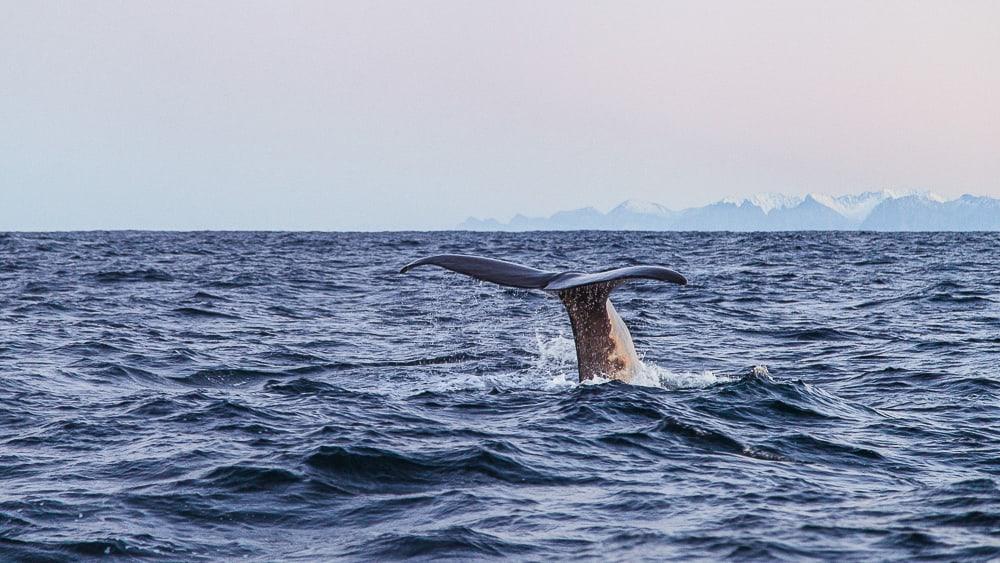
Tromsø – Senja – Dyrøy
If you want to head even farther north, I also loved my Tromsø – Senja – Dyrøy trip.
My friends and I flew into Tromsø and then drove straight to Senja, where we spent two nights, and then we headed to the island of Dyrøy for another two nights. We left Dyrøy early so that we’d have the morning in Tromsø before our flight, but if you have a full week you could spend a night or two in Tromsø as well.
I wouldn’t spend more than two days in Tromsø, as there’s not a great deal to do there. The city center is small and there are a few nice restaurants and cafés but that’s sort of it. It’s also a big tourist destination for Northern Lights tours, so downtown is full of tour offices, so if you want to get away from tourist crowds I’d recommend getting out of the city. But the surrounding nature is breathtaking!
Again, I did this trip in the winter, but Senja is a great hiking destination in the summer, plus in the summer you could stop by Sommarøy to see the amazing beaches there.
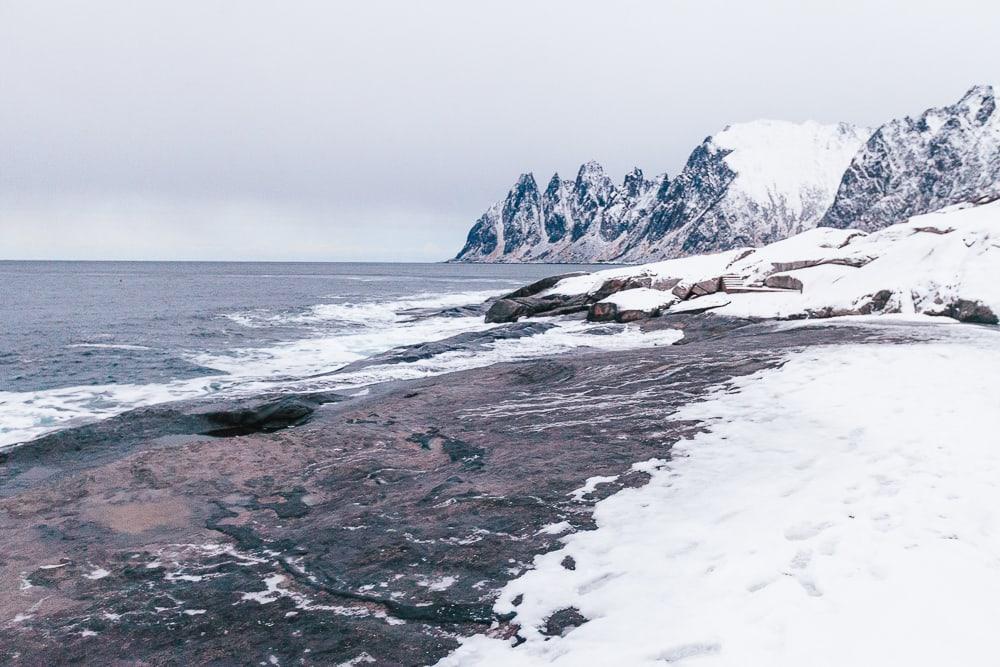
If you want a less hectic itinerary without so much driving, just spend a week on Lofoten !
The first time I visited Lofoten I stayed one week, and even after returning several times over the past few years I still feel like I have so much left to see on Lofoten. So you definitely won’t get bored.
This way you’ll be able to really explore the island, go on hikes, and get into the nature. I’d actually love to spend a full month on Lofoten one day, as there really is so much to explore there.

Narvik – Kiruna – Vesterålen – Lofoten
If you’re looking for those big Arctic bucket list experiences, this Narvik – Kiruna – Vesterålen – Lofoten itinerary is for you. You’ll get to see reindeer, huskies, and whales, and in the summer the midnight sun and in the winter the Northern Lights, and you’ll even get to sleep in an Arctic Dome – one of the best experiences I’ve had in Norway.
When my friend who hates the cold came to visit me in Norway in January, this was the itinerary I made to win her over – and it did!
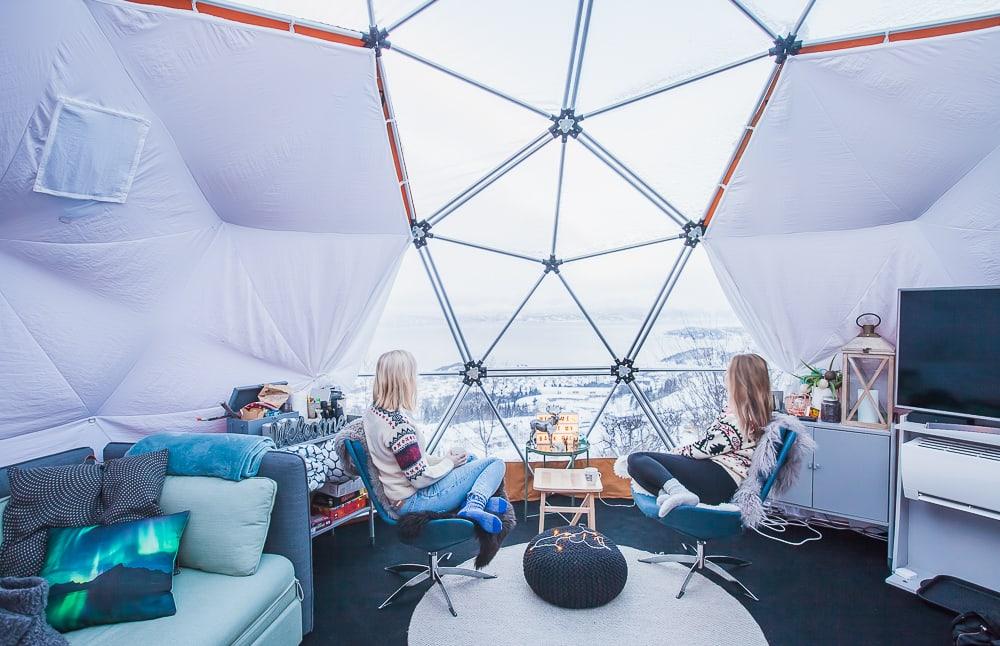
Bodø – Helgeland Coast
The Helgeland coast is so dreamy, and still relatively undiscovered, especially amongst foreign tourists. Plus the people here are so, so friendly. It’s a totally different experience than visiting the super crowded and touristy areas of southern Norway (where the locals don’t always love all the tourists).
I still have so much of the Helgeland coast left to explore, so I’ll definitely be updating this with a couple of itineraries once I make some more trips here this spring and summer.
But for now I would suggest flying or taking a train to Bodø and spending a day there, and then getting the express boat to Støtt and a few of the other small islands along the coast. If you stick to the small islands you won’t need to rent a car, as you can get around them by foot or by renting a bicycle.
Plus the small islands are so special. You’ll get an immediate sense of Norway’s culture and history here, and the locals really are so friendly.
You can get the Travel Pass Nordland for 990 NOK, which gives you access to all of the buses and express boats (not the ferries) in Nordland for one week, so you can island hop as much as you want.
Alternatively you could get the train or fly to Mosjøen and then rent a car there and explore the coast by car.
I’m going to try to do this trip both with and without a car and report back this summer!
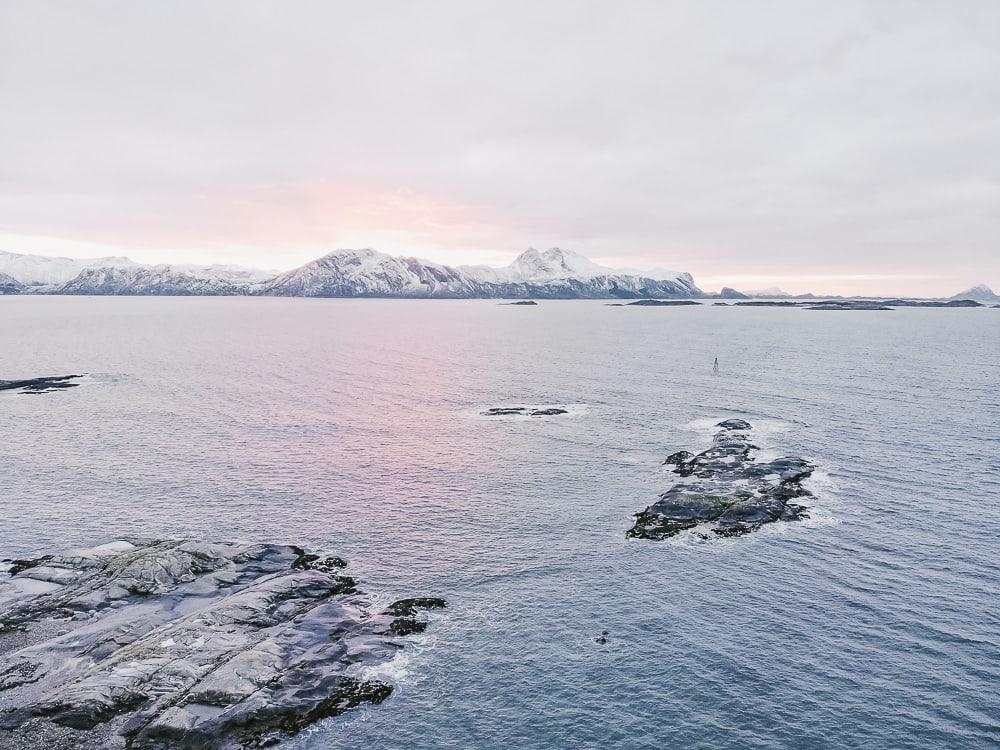
Mosjøen – Helgeland Coast
Like I said, I still have a lot more of the Helgeland Coast to explore, but I did recently take a trip from my home in Mosjøen out to the islands of Dønna and Herøy , which many locals had told me were two of the prettiest islands along the coast here. And they weren’t wrong!
I drove from Mosjøen to Sandnessjøen and then caught a ferry to Dønna from there, but you could also fly directly to Sandnessjøen and then you wouldn’t even necessarily need to rent a car, because the islands are so small. Or it would be really fun to rent a bicycle in Sandnessjøen to explore the islands by bike!
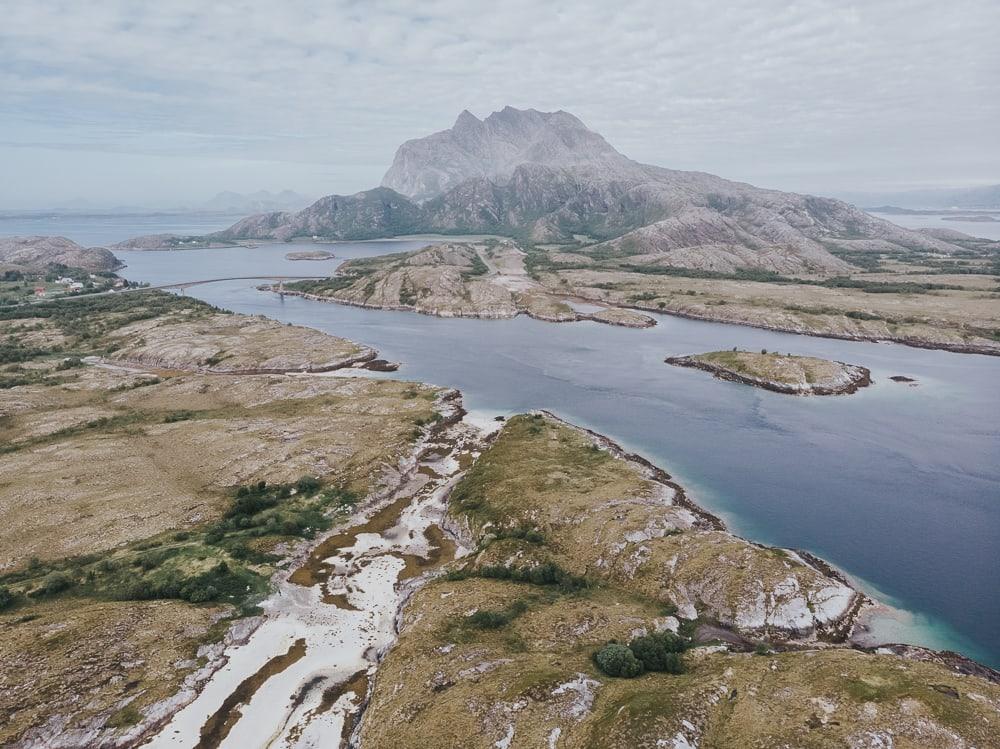
Tromsø – Lyngen – Alta – Kokelv – North Cape
This Tromsø – Lyngen – Alta – Kokelv – North Cape itinerary is one of my favorite northern lights itineraries, as it includes some of Norway’s best northern lights hotels .
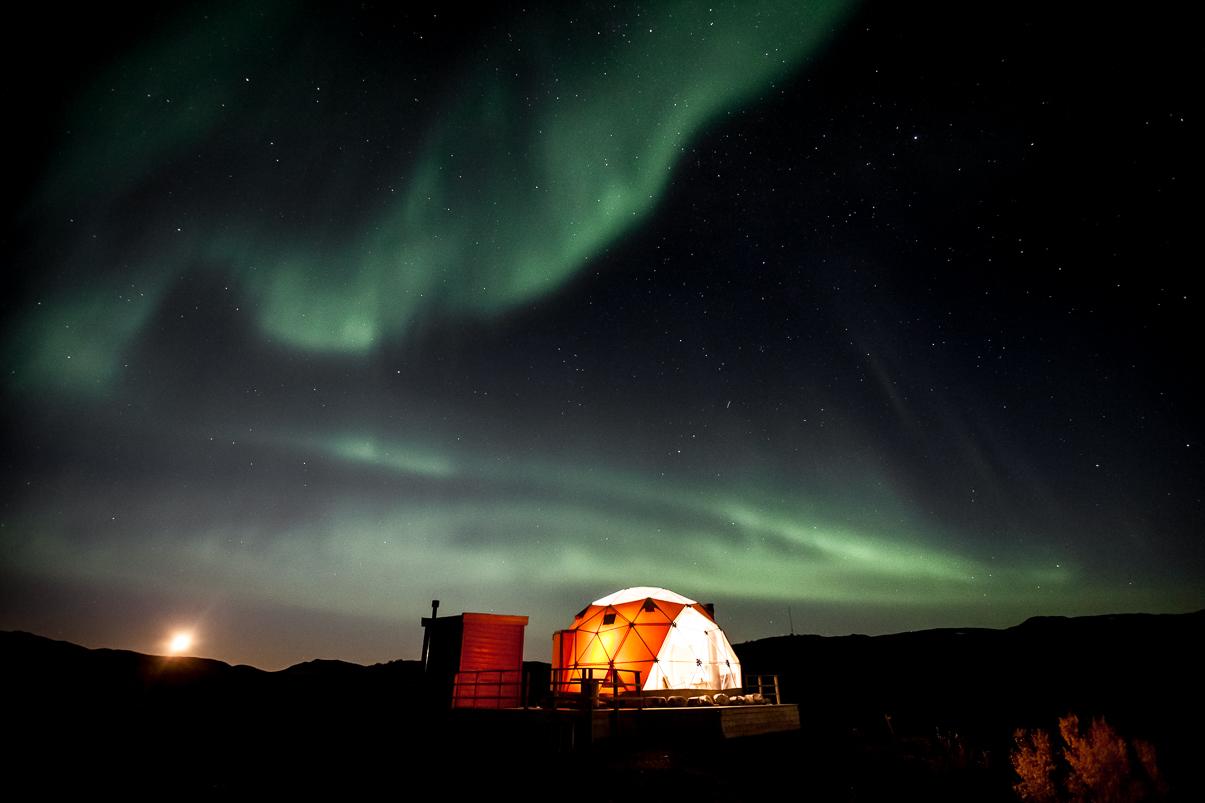
Kiruna – Hammerfest – Hamningberg – Kirkenes – Rovaniemi
This is one of the most recent one week trips I’ve taken, and it was one of my all time favorites! And as a bonus, this will also take you through Sweden and Finland, so you get three countries in one trip.
This Kiruna – Hammerfest – Hamningberg – Kirkenes – Rovaniemi itinerary will take you to the very top of Europe, the border of Russia, and through some of the most beautiful spots in the Arctic. I did this trip in the summer under the midnight sun, but you would have an equally amazing trip in the winter under the Northern Lights.
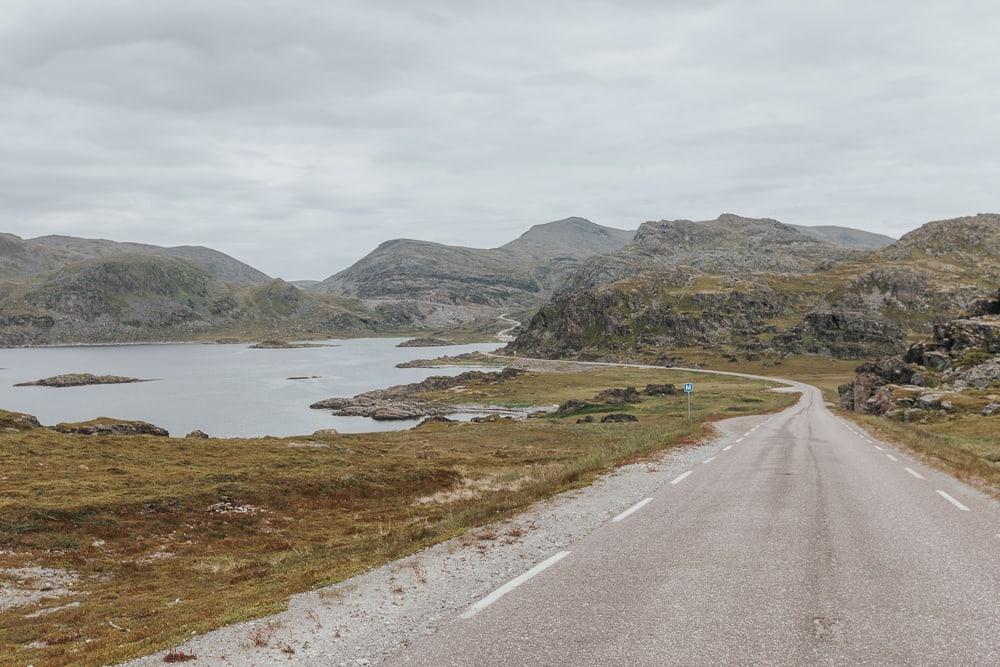
Okay so while I personally prefer northern Norway, I know a lot of people want to see the iconic destinations of the south like Oslo, Bergen, and the most famous Pulpit Rock and Trolltunga hikes.
And the most famous of Norway’s fjords are in southern Norway, so it’s not like the north has all the looks.
So don’t worry, I’ve made some itineraries for southern Norway too!
Bergen – Aurland – Jotunheimen – Fjærland – Balestrand – Bergen
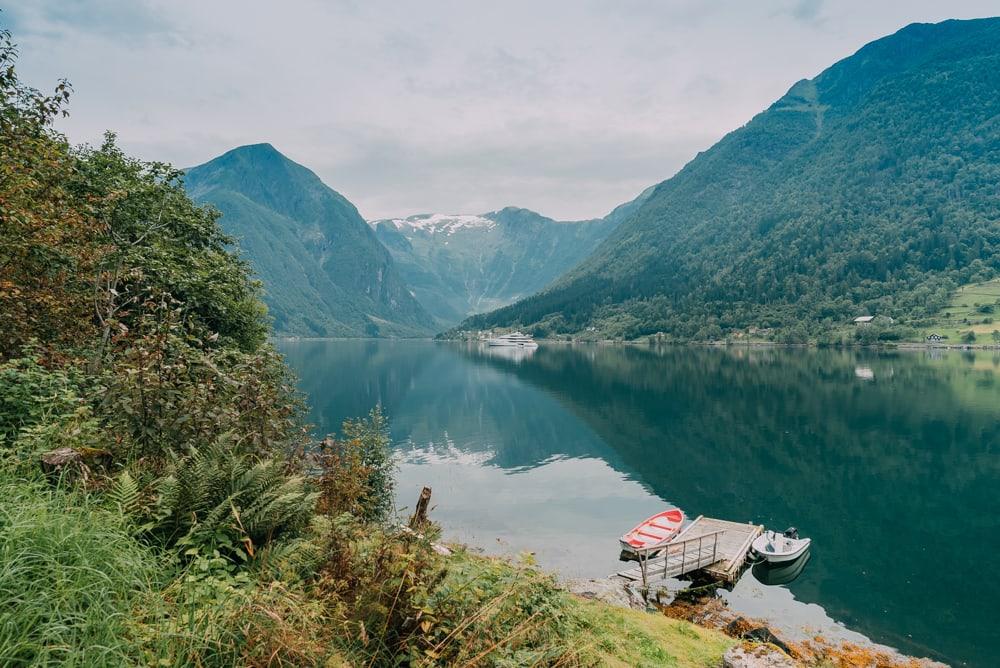
If you want to see the best of fjord Norway, this is the trip for you.
Spend one night at Hotel Aurlandsfjord in Aurland, then take both the Aurlandsfjellet Scenic Route and Sognefjellet Scenic Route and drive up to Jotunheimen National Park and spend a night at Leirvassbu Fjellstue . Add an extra night here if you want to take a day to hike in Jotunheimen.
Then drive down to Fjærland for a night at Fjærland Fjordstue . Then take the Gaularfjellet Scenic Route and loop back to Balestrand for a night at Kviknes Hotel . Then drive back to Bergen the next day.
Read more details about this itinerary here .
Oslo – Rjukan – Odda – Hardangerfjord – Bergen
If you want to do the traditional Oslo – Bergen – fjord loop but add in some special stops along the way, this Oslo – Rjukan – Odda – Hardangerfjord – Bergen itinerary is probably my favorite one week itinerary for southern Norway. This is the first itinerary listed in the blog post.
You’ll start in Oslo, then spend a night in the lovely town of Rjukan, drive along Hardangerfjord, and get to see Bergen. This is a busy itinerary with quite a bit of driving, but I think you will love it!

Oslo – Kristiansand – Stavanger – Bergen – Hardangervidda
If you want to do the famous hikes like Pulpit Rock and Kjeragbolten (the rock stuck between two cliffs), then this Oslo – Kristiansand – Bergen – Hardangervidda itinerary is for you! This is the second itinerary listed in the blog post.
You’ll take a train from Oslo to Kristiansand, which is known as Norway’s “riviera,” and then you’ll head through some amazing mountain and coastal scenery through Stavanger towards Bergen. Then from Bergen you’ll drive over Hardangervidda, Northern Europe’s largest high mountain plateau, and through Telemark back down towards Kristiansand. You’ll see a huge variety of landscapes, as well as both villages and cities, so it makes for a great introduction to Norway.
Oslo – Røros – Trondheim – Kristiansund – Alesund by public transport
Most of the itineraries I’ve mentioned require you to rent a car, partly because I always love a good road trip, and partly because a lot of areas of Norway don’t have frequent public transport. But this Oslo – Røros – Trondheim – Kristiansund – Alesund itinerary uses only public transport, with a combination of trains, ferries, and buses. This is the third itinerary listed in the blog post.
So usually when people want to see Norway by public transport they do the famous Oslo – Bergen Norway in a Nutshell route. But there’s a reason I’m not recommending that itinerary here.
I mean, if you really want to do it you can read more about how to plan Norway in a Nutshell here , but to be honest I really don’t think that route shows off the best of Norway, or the most beautiful sites. It’s a good route if you want something really easy, because you’ll basically be following the same route as everyone else on the buses, trains, and ferries, so you can just follow the crowd.
But if you’re a little more independent and want to get off the beaten path a bit and see even more impressive views, do this itinerary instead. It’s so much better, I promise!
You’ll get to see Røros, a really beautiful historic town, Trondheim and Ålesund, which are my top two favorite cities in Norway, and you’ll see some of the most stunning landscapes in southern Norway.
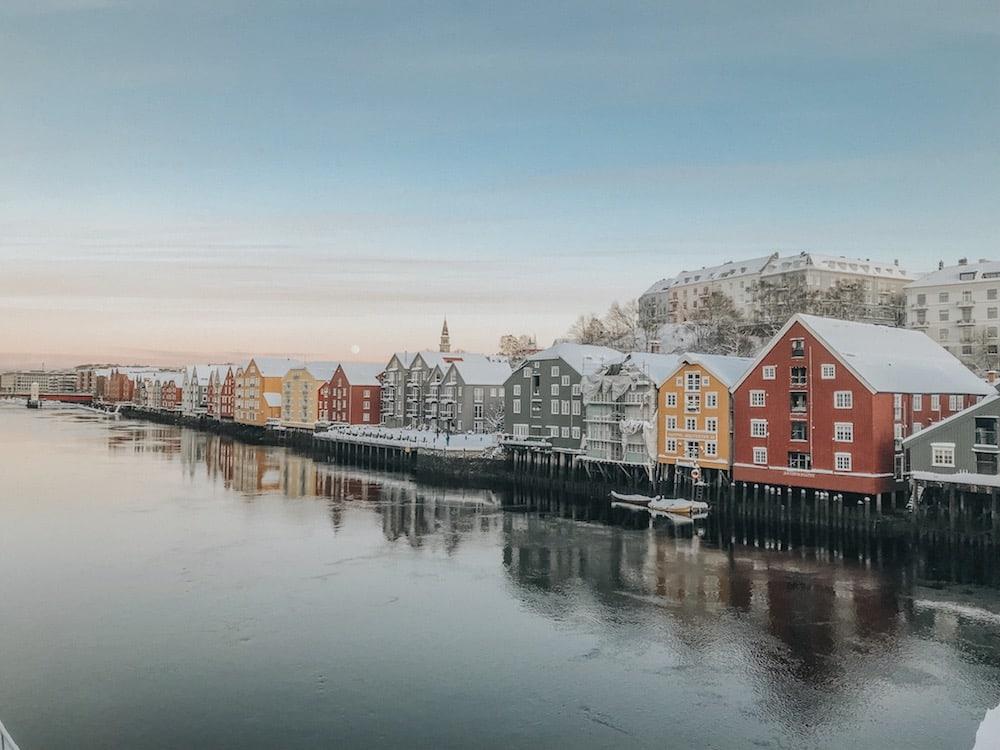
Ten Days to Two Weeks in Norway Itineraries
All of the one week itineraries I mentioned above could easily be stretched out longer. In fact the Odda – Hardangerfjord – Bergen itinerary mentions an optional extension by adding Ålesund and the Atlantic Ocean Road .
But otherwise I recommend one of the itineraries below!
Bergen – Aurland – Balestrand – Fjærland – Jotunheimen – Geiranger – Trollstigen – Ålesund – Hjørundfjord – Stryn – Bergen
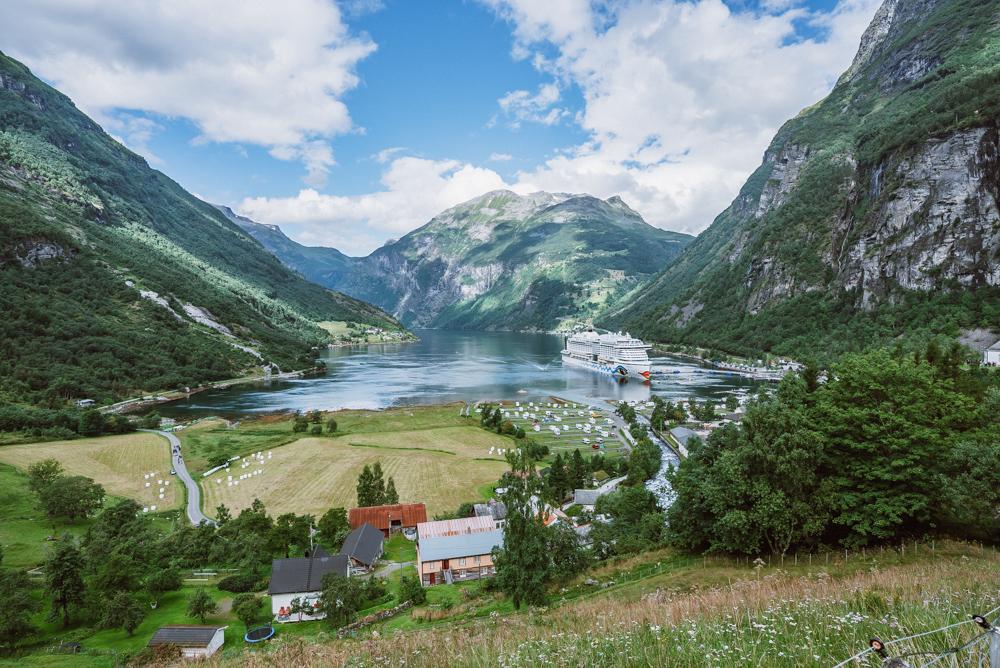
Spend one night at Hotel Aurlandsfjord in Aurland, then take the Aurlandsfjellet Scenic Route and drive to Balestrand for a night at Kviknes Hotel . From Balestrand take the Gaularfjellet Scenic Route and then drive to Fjærland for a night at Fjærland Fjordstue . Then take the Sognefjellet Scenic Route and drive into Jotunheimen National Park. Spend a night or two at Leirvassbu Fjellstue .
Then drive to Geiranger and spend a night at Hotel Union Geiranger . Then take the Geiranger – Trollstigen Scenic Route to Åndalsnes and spend a night at G rand Hotel . Then drive to Ålesund and spend a night or two at Hotel 1904 . Then drive along Hjørundfjorden to Sæbø and stay at Sagafjord Hotel . Then drive to Stryn and spend a night at Hjelle Hotel . Then either drive all the way back to Bergen, or split up the drive with a night at ThonPartner Hotel Førde .
Røros – Trondheim – Kristiansund – Atlantic Ocean Road – Molde – Romsdalsfjord – Hotel Union Øye – Hjørundfjord – Hoddevik – Stryn – Hitra – Golden Detour
This is one of my all time favorite Norway itineraries, but you’ll need at least two weeks for this – it will be even better with three weeks. This fjord and culture itinerary takes you through Norway’s most beautiful fjords as well as some Norwegian cultural heritage sites.
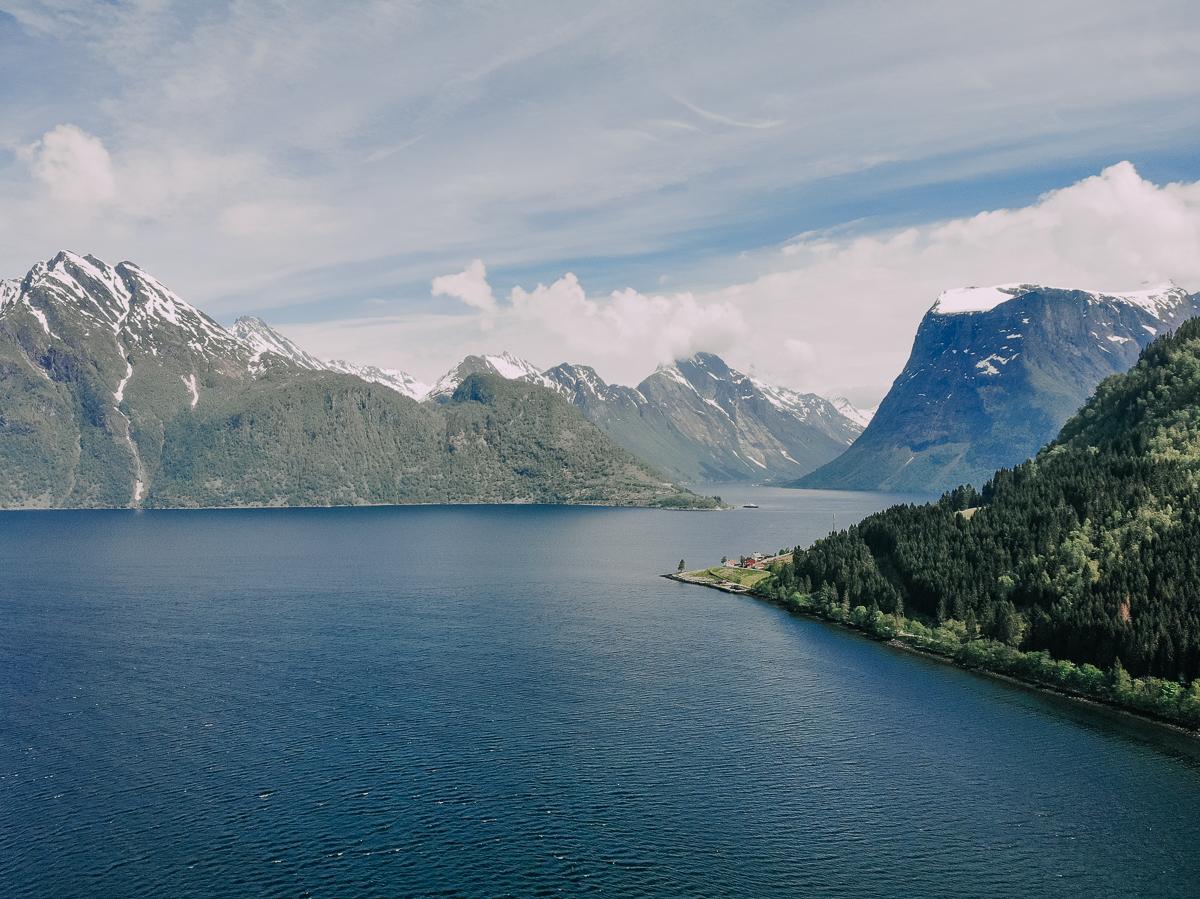
Oslo – Bodø – Helgeland – Narvik – Tromsø – Lyngen – Alta – Lofoten
I absolutely loved this Oslo – Bodø – Helgeland – Narvik – Tromsø – Lyngen – Alta – Lofoten itinerary . You’ll get to see a huge portion of the country on the train ride up from Oslo to Bodø, and all of the stops on the way are some of my favorite places in Norway.
And if you have any longer, I would definitely consider adding a detour to Senja and even Dyrøy to your itinerary when you’re driving from Narvik up to Tromsø. You could also stop for a day in Oslo and Trondheim on your way up north.
And then if you have even more time, drive all the way up to the North Cape from Alta. It’s an extra 3 and a half hours of driving, but since you’ve made it this far north in Norway you might as well go as north as you can get!

Narvik – Kiruna – Vesterålen – Lofoten – Bodø – Mosjøen – Trondheim
If you want to check off a bunch of arctic bucket list experiences like husky sledding, staying with reindeer, overnighting in an Arctic dome, and whale watching, take a look at this Narvik – Kiruna – Vesterålen – Lofoten – Bodø – Mosjøen – Trondheim itinerary .
Plus you’ll get to go to Sweden as well!
This is the full trip that my friend Danielle and I did when she visited me in Norway, so if you’re wondering what I personally recommend to my friends coming to Norway for the first time, this is it!
I wanted to include Narvik for a stay in an Arctic Dome, which is Norway’s answer to the glass igloo, and then Kiruna has both the husky and reindeer Airbnbs which I love so much.
And then Vesterålen is amazing for whales, reindeer, and nature views, and Lofoten is one of the most beautiful places in Norway. The train ride from Bodø to Mosjøen is the most beautiful train ride in all of Norway, and you’ll end up in Trondheim to see big city life in Norway.
In Trondheim we went to a bunch of fancy restaurants and quirky cafés, and then Danielle flew straight out of Trondheim Airport instead of having to go back down to Oslo.
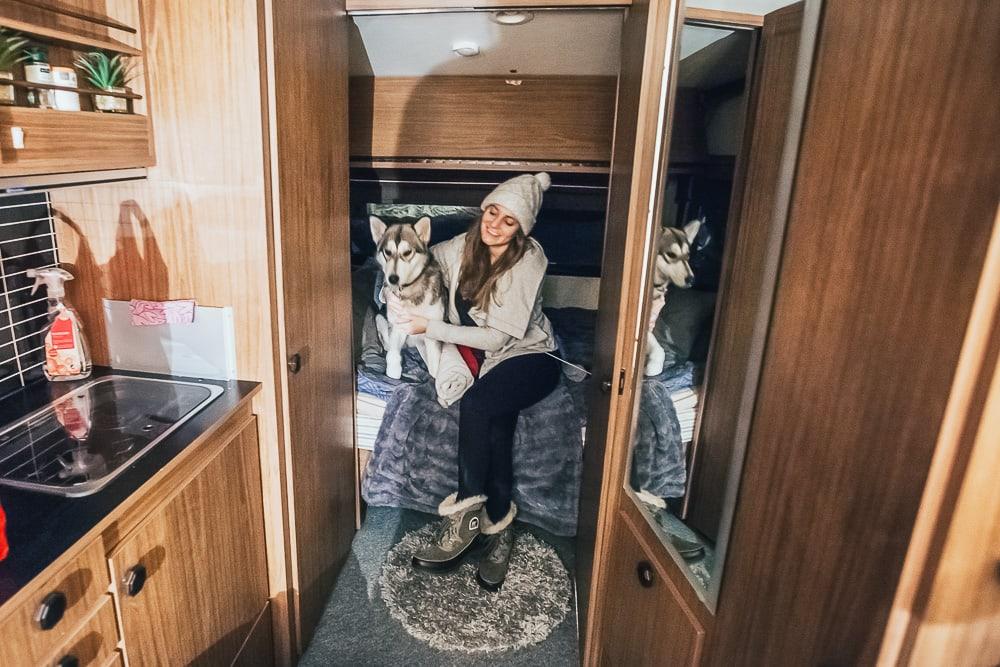
Trondheim – Mosjøen – Vega – Lovund – Lofoten
When my two travel blogger friends Sam and Sher came to visit I knew I had to put together an epic itinerary for us, and I think I succeeded with this Trondheim – Mosjøen – Vega – Lovund – Lofoten itinerary .
This trip covers the best of Norway, in my opinion, with one of Norway’s most beautiful big cities, Trondheim, gorgeous islands along the Helgeland coast, and then the iconic Lofoten islands.

Tromsø – Storslett – Kokelv – Hammerfest – Sørøya – Porsangerfjord – Vardø – Tana – Karasjok – Kautokeino – Alta – Lyngen – Tromsø (pet friendly!)
Okay this is a long one, but I actually did do it in two weeks and didn’t feel rushed. This Arctic itinerary includes stops in all of my favorite spots in the far north of Norway, including Lyngen, Hammerfest, and Vardø. It also takes you deep into Sami country in eastern Finnmark, to learn more about local Sami culture. Oh and this itinerary is totally pet friendly, as I did it with a dog!
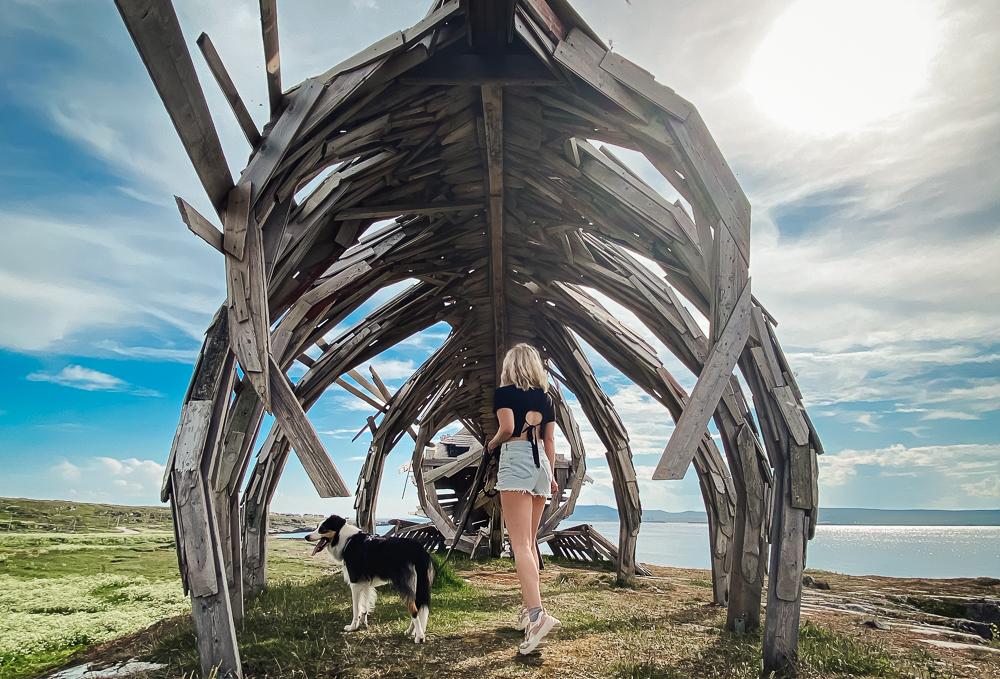
Getting to Norway
Lots of airlines fly into Oslo, so you shouldn’t have a problem finding good flights.
And if you’re on a budget you’re in luck – Norwegian is a budget airline with some of the cheapest connections between the US and Europe.
I fly Norwegian all the time, but just remember that it is a budget airline so you’ll have to pay extra for checked luggage, meals on board, and even water during your flight. I always bring several sandwiches and lots of snacks and a big water bottle that I refill at the airport (after security of course!) to tide me over.
But the planes are really nice with big windows, lots of overhead space, and they’ve designed the lighting to help combat jet lag (not really sure how or if it really works, but I like to think that it does!). There’s also an option to fly their premium class, which I believe comes with meals and maybe checked luggage – I’ve never flown premium on Norwegian though so I can’t say if it’s worth it or not. I do know that it’s not as fancy as business class on other airlines.
Oh and be sure not to exceed the carry on luggage limit if you don’t pay for checked luggage with Norwegian, because they are super strict. My friend recently flew Norwegian to visit me in Norway and she had to pay $200 to check her bag at the airport, which was about how much her flight had cost! I mean, at least her flight had been super cheap to start with, but it was still a bit of a blow.
I do love Norwegian, but sometimes you can find even better deals with other airlines, and if you do it’s definitely nicer to fly a non-budget airline. Luggage fees add up and it’s so much nicer to fly an airline with meals and drinks included. I often fly KLM and Finnair as well.
I’ve also flown Icelandair directly out of Trondheim, though they’re also a budget airline and super strict with luggage – a flight attendant once really yelled at me for having two bags with me, even though my second bag fit under the seat in front of me and my larger bag was a backpack that was smaller than most of the suitcases other people had brought on as carry ons. I definitely hadn’t broken any rules but she was so mean about it anyway, and clearly I’m still feeling very bitter about the whole experience, haha.
So yeah, try to find a flight with a non-budget airline if you don’t want the added stress.
My go-to for finding flights are Skyscanner and Kiwi.com. Kiwi.com especially is a sneaky travel hack tool that can find great connections that other search engines don’t include – I’ve written more about Kiwi.com and how to use it here .
You’ll probably be flying into and out of Oslo Gardermoen Airport which seriously is one of the nicest airports in the world. And guys, I travel for a living so I spend a lot of time in airports.
Pro tip #1: if you want to look like a local, head straight to the Tax Free shop once you land. It’s always funny getting off flights in Oslo because every Norwegian will go straight to Tax Free to buy alcohol, and it’s only the tourists that skip it, haha. But seriously, if you do want to drink in Norway and are on a budget, you’ll save a lot of money by picking up something here.
Pro tip #2: Don’t get the Flytoget, or Airport Express Train, into Oslo from the Airport. It’s only three minutes faster than the regional train and costs twice as much!
Again, it’s only ever tourists who get the express (“express”) train while all Norwegians get the Vy train. You’ll see the Vy (formerly NSB) ticket machines on your right once you exit customs and you can buy your tickets there. You can also check the train schedule at vy.no .
What to Pack for Norway
The most important thing about packing for Norway is to bring lots of layers. The weather here is really unpredictable so it’s important to be ready for lots of different temperatures throughout the day.
Oh and you’ll definitely want waterproof shoes here, whether that’s hiking boots in the summer or winter boots in the winter.
I’ve written a complete guide for what to pack for winter in Norway here, and a guide to what to pack for summer in Norway here.
It’s also a good idea to buy travel insurance for your trip to Norway, as storms can often cause delays and if you’ll be hiking or doing outdoor activities you want to be covered in case of an accident. Plus Norway isn’t exactly a cheap destination, so you don’t want to end up losing money due to weather delays or unforeseen events.
I always get travel insurance wherever I travel, as several incidents in the past have taught me that it’s always worth it.
I personally use World Nomads because that’s what I used as a backpacker and I’ve had to file claims twice with them now and they paid me promptly, no additional questions asked. They also helped get me to a hospital in Beijing when I was too overwhelmed/dying to find one on my own, so I am forever grateful to those guys.
You can find a quote on World Nomads here .
Want to see more of my travel photos? Follow me on Instagram here ♥
Want to see more of my travel videos? Subscribe on YouTube here ♥
Related Posts
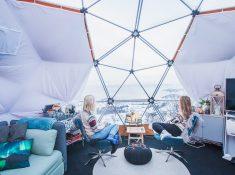
Reader Interactions
Get updates.
Subscribe to my newsletter for exclusive updates and stories from my world travels and life in Norway!
Riley - Riley's Roves says
March 1, 2019 at 5:51 am
SERIOUSLY cannot wait to get to Norway one day. Thanks for posting these! It’ll help me plan when the time comes.
Silvia says
March 1, 2019 at 5:01 pm
I hope you love it as much as I do when you do come!
Alberto says
March 3, 2019 at 10:07 pm
Hi Silvia Hope this note finds you well
I have been reading your blog and I have to say that is really great, I love it, honestly speaking I am writing to you as even though your blog has plenty of information about different routes and places to visit taking into account the amount of time that a person will be spending in Norway, my case is a bit special as I am traveling:
For a whole week, from Saturday 8th to Saturday 15th of June (we are arriving in Oslo around 10am on the 8th, and we will be leaving around 12pm on the 15th) With my girlfriend and our son, who is nearly three years old He doesn’t do long car trips very well He does not do bus journeys very well either… He likes trains and planes though I would personally like combining the southwest with the north, if possible Basically our idea is to see Oslo (we’ll be there for a day), Bergen (I guess we should…), some fjords (obviously :)), and maybe go to the north (fly to Tromso…)
Bearing in mind those facts, what route – option would you recommend me? I don’t mind taking trains and flights (especially I prefer taking flights, if possible…)
Please let me know, and apologies for bothering you as I am sure you are busy with your blog and answering lots of questions from different people
Thanks very much in advance Alberto P.S.: By the way I also wrote to you an email just in case you would not read this comment… 🙂
March 5, 2019 at 2:02 am
These look great and are very helpful! I am heading to Norway solo for the second time in April. I decided to mix it up a little by spending 4 days in Bergen and then taking public transportation to Odda for three days. I didn’t want to stress my time too thin and travel too much by public transit, plus I wasn’t sure of all of the options, but it looks like you really can get around with your Oslo – Røros etc. route.
Francesco Trebbi says
March 17, 2019 at 2:38 pm
Absolutely great posting. I actually happy when i done this topic. I am excited world have a excellent author. Always i am waiting for next reading. Thanks a lot for great posting share.
Kym Channell says
March 23, 2019 at 9:19 pm
Thanks for all this info – it’s a fantastic blog! I’ve just booked for 11 days total in Norway, including flying in and out days in June and will be definitely taking into consideration some of the itineraries you have discussed. Wasn’t sure about booking to go there initially as only considered it when cheaper flights to Iceland got booked out, but after reading your blogs starting to feel super excited about it! Your efforts in doing the blog are much appreciated – thanks!
March 24, 2019 at 1:22 pm
I’m so happy to hear that – I personally prefer Norway over Iceland 🙂
May 14, 2019 at 6:41 pm
So I’m seeing mixed reviews. Is it bad to travel in mid May? I will be there from May 17-June 3 and after reviewing these itineraries I’m starting to get a bit nervous. I picked Norway because it was on the best travel destinations for May. If anyone knows anything please help me ease my mind.
May 15, 2019 at 6:17 am
I think that’s a perfect time to come! Just bring layers in case it’s still cold. It will be beautiful though, and far less crowded.
June 17, 2019 at 1:07 pm
Incredible pictures on this post! I have been to about half of these places, but totally inspired to go to the others. I wonder if you have a favorite.
Florencia Coldman says
June 20, 2019 at 12:19 am
Hello, how are you? We are a party of six, we where planning on going from Tromso to Senja and then Lofoten around Christmas. Do you think it’s too dangerous that Rout in late December taking into consideration that we would be driving a Car for six passengers? We would really appreciate your take on this matter Kind Regards Florencia
Amber Hill says
June 20, 2019 at 1:57 pm
Hi Silvia, your blog is amazing! I am sitting here at 10pm with many hours of reading ahead of me!! I am struggling to put together an itinerary for Norway so all your blog posts will be a great help. I am especially excited by all the ‘off the tourist trail’ information. This is what I am looking forward to exploring. We are a family of 4. Kids are great little travellers. We are looking at September (2020) as I want to avoid the crowds over June/July (when our winter school hol’s are). The Lonely Planet says that many places close down in September? Do you agree? Or will we be ok to find accommodation?? We are coming from Melbourne – it’s a long way!! Many thanks, Amber
Tamara D says
July 28, 2019 at 4:39 pm
Hi Silvia!!! Your blog is amazing!!!!! Thank you for taking the time to give so many details and tips! My friends and I plan to take a girls trip March 28-April 4, 2020. What towns do you recommend seeing with that time frame during that time of year?
August 3, 2019 at 9:13 am
Silvia, really great post with all details, pictures and very helpful to plan our tour to Norway. Thank you for such a wonderful article!
Anoushka Sivaraman says
January 22, 2020 at 6:34 pm
Really enjoyed reading your blog. I’m travelling in April and flying into Oslo. Can you please suggest a 5 day itinerary which would include public transport? Is it reasonable to do Oslo Bergen and Alesund in that time? Do let me know!
January 23, 2020 at 12:00 pm
Ålesund is quite far from Bergen so it would be hard to fit it in, unless you fly. Best 5-day public transport itinerary would probably be a diy Norway in a nutshell: https://www.heartmybackpack.com/norway/nutshell-tour-diy-review/
Suzie S Russell says
February 4, 2020 at 11:09 pm
Hi Silvia, I am so jealous that you have gotten to travel all these places you’ve been. My daughter and I are hoping to come to Norway either this fall (early November) or next March. The things we want to see and do are 2-3 of the southwestern fjords, Sognefjord, Lysefjord, Hardangerfjord. I don’t know how far apart they are but is it possible to take a ferry to view these wonders? Is it possible to do just a day trip? Also, we want to do a husky sled ride , reindeer encounter/contact and possible sledge ride, spend one night in the arctic dome in Narvik, visit Lofoten with an overnight stay and head to Senja/Trosmo and if we have time maybe head to Kiruna, Sweden and maybe see the ice hotel. We have about 9 days and we’d like to fly in and out of Bergen. We are having a hard time coming up with a suitable itinerary because the distances are so vast and everything is super expensive. Could you help us?
February 9, 2020 at 1:17 pm
First of all I would map out how you are going to get between all of these places, as the distances are quite large – you might want to cut out a couple of places so you’re not super rushed. If I were you I might actually cut out the southwestern fjords altogether and just stick to Northern Norway/Sweden. You could fly into Svolvær in Lofoten, or Narvik, or Tromsø. Plus that way you’ll have more of a chance to see the northern lights!
Suzy Zid says
February 11, 2020 at 2:49 am
Thank you for the wonderful posts, what an amazing blog! I have a question; I saw a few times in different posts on your blog that if you’d have to choose between southwestern Norway and northern Norway, you’d prefer the northern part. However, I am curious because if I were to google the attractions in Norway, there are not much in the north compared to in the southwest – which has plenty!
I also read a lot on sites like TripAdvisor that locals would recommend a longer time in the north, but wouldn’t really go into specifics. The places that the locals actually mentioned are Lofoten, Senja, and maybe Vesteralen. Tromsø, Alta and Narvik are said to be meh, and nobody really suggested Bodø.
So the thing is, I want to believe the locals saying the northern part is better than the southwestern, because my friends and I are splitting our 17 day-roadtrip in Norway into these two parts and I want to convince my travel mates that we should spend more time in north than the other, but google searches are not really helping!
What ratio of days would you suggest we do? I was thinking 7 in southwest and 10 in north, but maybe you have a better advise. Also could you elaborate a little bit as to why you’d choose the northern part rather than southwestern part? Thank you so much if you decided to reply to my comment!
February 12, 2020 at 1:43 pm
Travel in Norway isn’t really about attractions. At least I find that the best experiences here are ones with nature, and honestly the entire country is beautiful. You can find a beautiful hike anywhere here, so the famous ones actually end up being the least appealing, because they’re filled with lots of tourists and souvenir shops. I think it depends a bit on what time of year you are visiting, but I think your plan to spend 7 days in the south and 10 in the north is perfect. I mean personally I would prefer spending all the time in the north, but the south is a bit different so it would be worth experiencing as well if you have the time. The landscape in the north is more dramatic – the mountains are more jagged and the beaches clearer – there tend to be fewer tourists, and then we also have more reindeer here. And if you come in the summer you can experience the midnight sun, and in the winter the northern lights – neither of which you can experience in southern Norway (unless you’re very lucky with the northern lights). Senja and Vesterålen are beautiful, as well as the whole Helgeland region. I also love the Lyngen Alps and Finnmark – you can find my posts from all of those places here: https://www.heartmybackpack.com/life-travel-norway/ Hope that helps and have a great trip!
September 7, 2021 at 7:18 pm
Silvia, Thanks for maintaining this sight. Very informative. In 2022 summer I will be traveling Norway from USA for 2 weeks. This will be my first visit to the country and like to cover the key scenic spots along with hiking to the major picturesque rocks. Main purpose of the trip is nature photography. Mostly I like to drive (wherever possible) to explore the areas at my own pace. Can you pls suggest a feasible itinerary? Thanks
Suzanne says
July 6, 2022 at 12:06 am
Hello, I hope you trip goes great! I am traveling there for the 1st time in Oct. Did Silvia answer you? I would love to know if she did and share the info. Where are all the places you will see?
Bao Nguyen says
December 29, 2021 at 8:28 pm
Hi, I’m traveling to Norway 2022 for the End of Jan- early Feb. The Aurora Borealis is my main attraction so I’ll Be landing in Tromso, but wish to visit places like Sommaroy, Lofoten, and Bodo.
You filled this blog with so many insightful details! I was wondering if you a car was necessary for all these places or if the public transportation would suffice?
Lisa Rubin says
February 22, 2022 at 5:32 pm
Hi Silvia, I am planning a trip with my husband and two grown daughters. We would like to try and combine Fiords and Lofoten and possibly hike Kjeragbolten. This would be about a two week road trip. Do you have an itinerary you would recommend? Also, trying to decide between early July or mid August ? We want to see the best scenery, but in a less touristy way if possible. I would appreciate any advice. Thanks ! Lisa
Stamatis says
May 14, 2022 at 2:26 pm
Hello Silvia, I just bought your Southern Norway Travel Guide, which is very helpful, but now I’m torn between two itineraries, so I thought that you might be able to help. I arrive at Oslo and I will be using public transportation.
1) A version of your public transportation itinerary for 11 days.
Day 1: Oslo – Roros Day 2: Roros – Trondheim Day 3: Trondheim – Kristiansund Day 4: Kristiansund – Alesund Day 5: Alesund (Hjorundfjord Cruise) Day 6: Alesund Day 7: Alesund – Geiranger – Andaslnes Day 8: Andaslnes (Hike Trollstigen) Day 9: Andaslnes – Oslo Day 10-11: Oslo
2) My original idea Day 1: Oslo – Andaslnes Day 2: Andaslnes (Hike Trollstigen) Day 3: Andaslnes – Geiranger – Alesund Day 4: Alesund (Hjorundfjord Cruise) Day 5: Alesund Day 6: Alesund – Stryn Day 7: Stryn (Glacier Hike) Day 8: Stryn – Lom (or Lillehammer) Day 9: Lom (or Lillehammer) – Oslo Day 10-11: Oslo
As you can see my two main goals are to visit Alesund and Trollstigen! The first itinerary allows me to visit Trondheim and Kristiansund (and the Atlantic Road) but the second is a little more relaxed and allows me to enjoy more of Norway’s nature. On day 9 I’ve added a stop to one of these two towns because I don’t want to travel for 8 hours straight and I’ve heard that they are charming. What’s your suggestion?
P.S. I understand, having read your blog thoroughly, that Northern Norway is better but I have the impression that moving around in the north using public transportation is more difficult and that’s why I chose to visit the south. At least I took your advice and focused on your favourite fjords…
Thanks in advance and keep up the good work Stamatis
May 16, 2022 at 1:19 pm
You’ll see more with the first itinerary (I especially do love Røros) but if you would prefer a more relaxed itinerary I would definitely go with the second one! And you’re right, southern Norway has much better public transportation connections, so that’s a good choice for you.
May 16, 2022 at 7:25 pm
Thanks for the reply!
I think I’ll go for the second idea and try to be a little more relaxed, you can’t see everything in one trip after all. After my research, and reading your blog, I started planning a Helgeland road trip, I just need to persuade some friends to follow the plan, and Trondheim (and Roros) would be a great starting point for that…
May 28, 2022 at 2:47 pm
Hi Silvia! Have been reading most of your articles on Norway road trips (& I really want to thank you cause they are amazing and very informative!). You inspired me to organize a road trip at the end of June. I’m also planning to purchase your Southern Norway Travel Guide, but I’d first like to define a topline tour (cause I’m indecisive between the below and planning something around Lofoten). For now I’m planning: Day 1- visit Bergen Day 2 – drive to Hardangerfjord (& explore) Day 3 – Trolltunga Hike Day 4 – Drive until Stegastein (& sleep somewhere in the area) Day 5 – Drive to Geirangerfjord Day 6 – Explore from Geiranderfjord to Trolltunga (morning) & then drive to Ålesund (in the afternoon) Day 7 – Explore Ålesund Day 8 – not sure, potentially drive north until the Atlantic Ocean Road, or take a fjords cruise from Ålesund (though I’m not a fan of crowded cruises) Day 9 – Way back to Bergen (do you recommend taking the 7hours drive from Ålesund to Bergen? Any must-see spots that you’d suggest to stop by?)
Do you think this is a feasible plan? Any must-see spots that I have missed? Especially the last 2 days are not very clear how to best use the time.
Would love to hear your thoughts, it would help a lot! Thank you in advance, Ceci
Bhagya says
June 2, 2022 at 4:03 pm
Hi Sylvia, First off, Congratulations on this very extensive and eminently readable blog. Wish you many more journeys! I am thinking of spending twelve days in Norway, between the 30th of August and 12th of September. We are 3 of us, myself (57), my husband (62) and son (23) from India. We were wanting to do the Fjords and the natural wonders and the Great Atlantic Road in a car after visiting the Myskoxcentrum in Harjadalen. I will go through your blog for details and suggestions. There is one bit of information, I would be very grateful to have from you. I am recovering from a knee injury and so long hikes and walks to view points are not going to be possible. In this context can you tell me the places that need a lot of walking that we should or can avoid. This will help greatly in framing our itinerary. Many thanks
June 2, 2022 at 4:22 pm
You should be fine with your itinerary – the views will be beautiful from the road as well!
Nilesh says
March 22, 2024 at 5:57 pm
Can u send me ur Norway itnery for route this August I am planning for three weeks. Thanks in advance 🙏
July 4, 2022 at 8:23 am
Hey! Thanks for all this info! I’m trying to gauge the cost of a 10 day/2 week road trip in Norway. I haven’t planned any details yet, but I’d probably follow one of the itineraries posted above. Do you have any approximation for how much gas would cost? (Or around how many miles such a road trip would cover) thanks!
Nicole Wahlgren says
August 25, 2022 at 5:29 pm
Hello, I have been reading your blogs for three months now because I am going to Norway for two weeks in October. I want to see both some of the south and some of the north. Is it reasonable to cover Bergen, Alesund, Trondheim, Bodo, Lofoton, etc. all in two weeks? I am solo traveling, so my schedule is very flexible. Also, I am currently trying to find my family who lives in Norway via family contacts & ancestory. I know we had some family outside of Trondheim for awhile, but it would be cool to meet them if I get a chance. They were originally from the Namsos area. Just curious what your thoughts are because I want to see a lot of the country, but also not be overwhelmed by my schedule.
October 1, 2022 at 8:31 am
I just stumbled across your page and it is great to see you are not focused on the normal touristy things and more about seeing the “real” country. Which is the way I prefer to travel.
I have spent the last several hours trawling through your page and will no doubt spend a lot more time. But I wanted to ask: Can you recommend a place to do a horse trek or even just several days of riding.
I will be travelling in either May or June of next year, I am thinking I will stick to public transport and will more than likely be in the Southern region (as it is my first trip to Norway and treating this as a taster, because will be going back in winter at some stage to do Northern.
Ideally somewhere where I can ride to experience the beauty of Norway.
Also interested to hear what you think it would be like travelling solo in Norway.
Marlene LeGates says
November 22, 2022 at 8:22 pm
Your web site is awesome but now I’m totally bewildered as to where to go for our 3-week trip to Norway in June.We like to trave leisurely, so we don’t want to drive (rental car) more than 3 hrs per day (and hpefully many days with no driving at all) and we liike to do gentle hikes and perhaps some kayaking. Fly in and out of Bergen and stick to the south? Fly in and out of Narvik and stick to the north? It doesn’t seem reasonable to try to co a combo. (We are coming from Canada but it’s much cheaper to fly into the UK and then pick up Norwegian Air, kgives us more flexibility as well). Most itineraries are much too rushed. So, some specific questions: I guess you would rate the northern scenery as even more spectacular than int he south, right? I’ve heard that the Lofoten Islands are very poular now with long fery waits; is that true? Any advice would be greatly appreciated.
November 25, 2022 at 1:43 pm
If this is your first trip to Norway I would recommend flying in and out of Bergen and sticking to the south. That way you can explore Norway’s most beautiful fjords, and you won’t have as long distances to cover as in the north. Have fun!
nwa-non says
March 20, 2023 at 9:14 pm
First of all, a wonderful blog and a fantastic resource for visitors to Norway!! Thank you!
I’m planning for an 8-day trip to Norway in August. Flying in and out of Oslo. Mainly want to visit Northern part (but realize that Tromso/Lofoton Islands will not be possible).
Here is my tentative itinerary. Will be renting a car and driving around everywhere.
Day 1 – Fly in to OSL, stay the night at Oslo Day 2 – Start for Lillehammer. Spend night at Oppdal. Day 3 – Start for Trondheim, spend night Day 4 – Start for Ålesund, spend night Day 5 – Visit Geirangerfjord. Spend night at Ålesund Day 6 – Start for Flåm, spend night Day 7 – Start for Oslo, spend night Day 8 – Fly out of OSL
Do you think this is doable without being overwhelmed? If I rent an EV, are chargers readily available? I’m used to driving long distances so that’s not a concern.
March 21, 2023 at 2:39 pm
Hm I think it would make a lot more sense to fly from Oslo to Bergen and rent a car there, but if you really I want to leave from Oslo I think the trip is doable. I would skip Trondheim and head straight to Ålesund instead. And it doesn’t really make sense to drive back to Ålesund after Geirangerfjord, so I would stay somewhere along the fjord instead (here are my suggestions: https://www.heartmybackpack.com/norway/best-geirangerfjord-hotels/ ). Or you could stay somewhere along Hjørundfjord instead ( https://www.heartmybackpack.com/norway/hjorundfjord-norway-beautiful-fjord/ ). Instead of staying in Flåm I might consider the Kviknes Hotel in Balestrand or Fjærland Hotel, depending on if you like a big grand hotel (Kviknes) or smaller cute hotel (Fjaerland) as they’re both a lot nicer than Flåm. I’ve written about both here: https://www.heartmybackpack.com/norway/best-sognefjord-accommodation/ and here: https://www.heartmybackpack.com/norway/aurlandsfjellet-sognefjellet-bergen-road-trip/
April 3, 2023 at 4:44 pm
Thanks for your response!! I’ll look into your recommendations.
Aljoša Gabor says
April 27, 2023 at 10:52 pm
Hi! I tried to purchase your Southern Norway tour guide, but for some reason Gumroad does not want to accept my credit card. Is there any other way to purchase the guide?
Fisher Ahsan says
May 16, 2023 at 9:44 pm
Last year i visited Lofoten . a really lovely place
Holly Taylor says
July 29, 2023 at 5:53 pm
Hello thank you for this amazing blog!! I’m curious if we have 5 nights and are going to Norway on Nov 10 this year. I’ve read a lot about staying south due to the weather and shorter daylight. Would you have recommendations for 5 days in Nov? I want to be sure we plan where we can see the most. My husband & I are traveling with our 22 year old son and we are more interested in seeing all of the beautiful scenery and fjords etc. We will be coming from 7 days in Iceland.
July 31, 2023 at 11:44 am
If you want to see the fjords I would recommend flying to Ålesund and basing yourself there: https://www.heartmybackpack.com/norway/alesund-travel-guide/ You could rent a car and explore Hjørundfjord: https://www.heartmybackpack.com/norway/hjorundfjord-norway-beautiful-fjord/ . Or if you want a chance to see the northern lights, you could go to Lofoten: https://www.heartmybackpack.com/norway/lofoten-road-trip/ or Vesterålen: https://www.heartmybackpack.com/norway/vesteralen-whales-reindeer/ or Tromsø + Lyngenfjord: https://www.heartmybackpack.com/norway/lyngen-alps-blaisvatnet-fjord-cabins/
November 12, 2023 at 5:02 pm
Hello Silvia! I appreciate all of information you’ve provided! My friends and I are in the early stages of planning a six-day trip to Northern Norway in February. We’re specifically interested in itineraries that rely solely on public transportation. Here are a couple of options we’re considering:
Option 1: Fly to Trondheim Take the Nordland line from Trondheim to Bodø Board the express boat Nordlandsekspressen (NEX1) from Bodø towards Sandnessjøen Explore various islands along the way Eventually reach Sandnessjøen for hiking and exploration Fly back to Oslo from Sandnessjøen
Option 2: Take a bus from Bodø to Hamarøy Continue by bus from Hamarøy to Narvik Travel by bus from Narvik to Tromsø Conclude the trip by flying back from Tromsø
Option 3: Start in Bodø Take a Hurtigruten ship to Tromsø Participate in organized trips/excursions from Tromsø
Considering our status as students and budget constraints, which option would you recommend? Your insights would be immensely helpful. Thank you!
November 14, 2023 at 8:58 am
Six days is such a short time, I think I wouldn’t try to do quite as much. I would maybe fly into Bodø, take the express boat down to Træna, Støtt, etc. Then return to Bodø and fly back to Oslo. If you really wanted to see another area as well you could take the ferry to Lofoten.
December 1, 2023 at 5:00 am
Hello! I am going to be visiting Norway for the first time in late April. I want to work from North to South with the end destination being Copenhagen. How difficult would it be during this time to take public transport from Trondheim to Oslo and see all the southern fjords along the way? Oslo to Copenhagen via ferry would be the final move.
December 1, 2023 at 10:18 pm
The most direct public transport from Trondheim to Oslo would be by train, but then you’d miss all the fjords. You could instead take the express boat to Kristiansund and then take buses and/or ferries down to Bergen, and then the train from Bergen to Oslo. Buses in Norway are a bit of a pain and expensive, but certainly doable!
January 21, 2024 at 5:45 pm
Hello Silvia, Thank you for all the useful information on your blog. I would appreciate some advice on journey times to get to Tromsø. I’m visiting Norway with my family this August for 19 days, including returning to Hoek Van Holland. We are driving our campervan from the UK (via Harwich / Hoek van Holland overnight ferry), and want to head straight to Tromsø, with some time for stopping to sleep/eat on the way. We’ll spend a few days there and then head back, stopping to camp, explore the countryside and also possibly visit Bergen/Oslo/beaches. Would it be best to head up to Tromsø via Sweden, then back down through Norway with more time to explore? Can you recommend some route ideas with rough travel times/good places to stop on the way? Thank you 🙂
January 24, 2024 at 12:05 pm
Driving up through Sweden will be quicker, and much less scenic, so I think driving back down through Norway is a great idea. Spend some time on the Helgeland Coast ( https://www.heartmybackpack.com/norway/helgeland-coast-road-trip/ ) and then you can drive down the west coast through Ålesund ( https://www.heartmybackpack.com/norway/alesund-travel-guide/ ) and Bergen ( https://www.heartmybackpack.com/norway/top-29-things-to-do-in-bergen-norway/ ) as well. From Tromsø to Bergen, via Ålesund, is about 30 hours of driving. You can follow this road trip plan for the west coast, except in reverse (ending in Bergen instead of beginning in Bergen): https://www.heartmybackpack.com/norway/aurlandsfjellet-sognefjellet-bergen-road-trip/
Leave a Reply Cancel reply
Your email address will not be published. Required fields are marked *
Once a full-time nomad, I'm now trying to find a balance between continuing to explore off the beaten path places around the world while also building a home in Norway. Want to know more? Head to my About page !
COME AND GET IT!
Subscribe to my newsletter for exclusive updates and stories from my world travels and life in Norway:
Security Alert May 17, 2024
Worldwide caution, update may 10, 2024, information for u.s. citizens in the middle east.
- Travel Advisories |
- Contact Us |
- MyTravelGov |
Find U.S. Embassies & Consulates
Travel.state.gov, congressional liaison, special issuance agency, u.s. passports, international travel, intercountry adoption, international parental child abduction, records and authentications, popular links, travel advisories, mytravelgov, stay connected, legal resources, legal information, info for u.s. law enforcement, replace or certify documents.
Before You Go
Learn About Your Destination
While Abroad
Emergencies
Share this page:
Travel Advisory July 26, 2023
Norway - level 1: exercise normal precautions.
Reissued with obsolete COVID-19 page links removed.
Exercise normal precautions in Norway.
Read the country information page for additional information on travel to Norway.
If you decide to travel to Norway:
- Enroll in the Smart Traveler Enrollment Program ( STEP ) to receive travel alerts and make it easier to locate you in an emergency.
- Follow the Department of State on Facebook and Twitter .
- Review the Country Security Report for Norway.
- Visit the CDC page for the latest Travel Health Information related to your travel.
- Prepare a contingency plan for emergency situations. Review the Traveler’s Checklist .
Embassy Messages
View Alerts and Messages Archive
Quick Facts
Six months recommended
Not required for stays under 90 days
25,000 Norwegian Kroner (or equivalent), not including traveler’s checks
25,000 Norwegian Kroner (or equivalent), without prior approval
Embassies and Consulates
U.s. embassy oslo.
Morgedalsvegen 36, 0378 Oslo, Norway Mailing address: PO Box 4075 AMB, 0244 Oslo, Norway Telephone: +(47) 2130-8540 Emergency After-Hours Telephone: +(47) 2130-8540 Fax: +(47) 2256-2751 Email: [email protected]
Destination Description
Learn about the U.S. relationship to countries around the world.
Entry, Exit and Visa Requirements
COVID-19 Requirements
There are no COVID-related entry requirements for U.S. citizens.
Visit the Royal Norwegian Embassy website for the most current visa information.
Traveling Through Europe: If you are planning to visit or travel through European countries, you should be familiar with the requirements of the Schengen Agreement.
- Your passport should be valid for at least three months beyond the period of stay if you plan on transiting a Schengen country; review our U.S. Travelers in Europe page .
- You will need sufficient proof of funds and a return plane ticket.
- For additional information about visas for the Schengen area, see the Schengen Visa page.
HIV/AIDS Restrictions: The U.S. Department of State is unaware of any HIV/AIDS entry restrictions for visitors to or foreign residents of Norway.
Find information on dual nationality , prevention of international child abduction , and customs regulations on our websites.
Safety and Security
Terroris m: Terrorist groups and those inspired by such organizations are intent on attacking U.S. citizens abroad. Terrorists are increasingly using less sophisticated methods of attack – including knives, firearms, and vehicles – to more effectively target crowds. Frequently, their aim is unprotected or vulnerable targets, such as:
- High-profile public events (sporting contests, political rallies, demonstrations, holiday events, celebratory gatherings, etc.)
- Hotels, clubs, and restaurants frequented by tourists
- Places of worship
- Shopping malls and markets
- Public transportation systems (including subways, buses, trains, and scheduled commercial flights)
For more information, see our Terrorism page.
Crime: Norway has a low level of crime and violent crime is uncommon.
- The most likely forms of crime, especially in the Oslo metropolitan area, include residential and office burglaries and petty thefts.
- Pickpocketing and petty theft occur more frequently in major tourist areas, hotel lobbies, train and transit stations, and surrounding areas. The Oslo Central train station is an especially popular area for pickpockets and bag snatchers.
- Although rare, violent and weapons-related crimes do occur in areas known to have drug trafficking and gang problems, such as certain parts of eastern Oslo. As in any other urban area, you should remain aware of your surroundings at all times.
International Financial Scams: See the Department of State and the FBI pages for information.
Victims of Crime: Report crimes to the local police by dialing 112 and contact the U.S. Embassy at +(47) 2130-8540. Remember that local authorities are responsible for investigating and prosecuting the crime.
See our webpage on help for U.S. victims of crime overseas .
- help you find appropriate medical care
- assist you in reporting a crime to the police
- contact relatives or friends with your written consent
- explain the local criminal justice process in general terms
- provide a list of local attorneys
- provide information on victim’s compensation programs in the United States
- assist you in accessing Norway’s program to provide financial compensation to victims who suffer serious criminal injuries, via the Norwegian Criminal Injuries Compensation Authority .
- provide an emergency loan for repatriation to the United States and/or limited medical support in cases of destitution
- help you find accommodation and arrange flights home
- replace a stolen or lost passport
Domestic Violence: U.S. citizen victims of domestic violence may contact the Embassy for assistance. Victims may also contact:
Police (non-emergency) 02 800 Oslo Emergency Room 116 117 Helpline for Children and Youth 116 111 Hotline for Victims of Sexual Assault 800 57 000 DIXI Center for Victims of Rape 22 44 40 50 Oslo Crisis Center 22 48 03 80 National Association for Victims of Crime 22 16 40 00
Tourism: The tourism industry is generally regulated, and rules are regularly enforced. Hazardous areas/activities are usually identified with appropriate signage and professional staff is typically on hand in support of organized activities. In the event of an injury, appropriate medical treatment is widely available throughout the country. Outside of a major metropolitan center, it may take more time for first responders and medical professionals to stabilize a patient and provide life-saving assistance. At certain times of year, there are increased risks of avalanche and hidden crevasses in mountainous areas throughout Norway. Rapid weather changes may also create hazards in backcountry areas. We encourage you to check with local authorities and websites showing current conditions before engaging in outdoor sporting activities. If you plan to travel to Svalbard, please see more information below. U.S. citizens are encouraged to purchase medical evacuation insurance .
Local Laws & Special Circumstances
Criminal Penalties: You are subject to local laws. If you violate local laws, even unknowingly, you may be deported, arrested, or imprisoned. For instance, it is generally illegal to carry knives or other sharp objects in Norway. Individuals establishing a business or practicing a profession that requires additional permits or licensing should seek information from the competent local authorities before practicing or operating a business.
Furthermore, some laws are also prosecutable in the United States, regardless of local law. For examples, see our website on crimes against minors abroad and the Department of Justice website.
Arrest Notification: If you are arrested or detained, ask police or prison officials to notify the U.S. Embassy immediately. See our webpage for further information.
Svalbard: The Svalbard archipelago consists of nine main islands located midway between mainland Norway and the North Pole. You need a passport to enter Svalbard.
- Unlike Norway’s mainland, Svalbard is not party to the Schengen Agreement and air travelers to Svalbard from Norway will depart the Schengen Zone prior to boarding.
- Travelers to Svalbard face unique hazards given the extreme weather conditions and limited transport infrastructure.
- The U.S. Embassy has no direct representation on Svalbard, limiting its ability to provide emergency consular services.
- Verify that you have adequate travel, medical, and medical evacuation insurance to cover the potential costs of medical treatment or repatriation before you travel to Svalbard.
- Although road systems exist within the three largest towns – Longyearbyen, Barentsburg, and Ny-Alesund – they do not connect with each other, making sea, snowmobile, or limited air service the only options for traveling throughout Svalbard.
- Tourism to Ny-Alesund is restricted due to its status as a research facility and the danger of polar bear attacks.
- There have been several reported instances of death or injury to tourists in the Svalbard archipelago due to animal attacks and boating incidents, often involving unpredictable weather or ocean conditions.
- In cases of illness or injury, a clinic in Longyearbyen can provide limited emergency care until medical evacuation to Tromsoe is available.
- You should consult the Svalbard Tourist Board for the latest travel conditions and information before you go.
Counterfeit and Pirated Goods: Although counterfeit and pirated goods are prevalent in many countries, they may still be illegal according to local laws. You may also pay fines or have to give them up if you bring them back to the United States. See the U.S. Department of Justice website for more information.
Child Protection Laws: The treatment of children is taken very seriously in Norway. All forms of corporal punishment of children are against the law, and any form of violence, humiliating treatment, or neglect may result in the child being taken away from parents by the Norwegian authorities and placed into long-term care by Norway’s social services.
Faith-Based Travelers: See the following webpages for details:
- Faith-Based Travel Information
- International Religious Freedom Report – see country reports
- Human Rights Report – see country reports
- Hajj Fact Sheet for Travelers
- Best Practices for Volunteering Abroad
LGBTQI+Travelers: There are no legal restrictions on same-sex sexual relations or the organization of LGBTI events in Norway.
See our LGBTI Travel Information page and section 6 of our Human Rights report for further details.
Travelers with Disabilities: While in Norway, individuals with disabilities may find accessibility and accommodation very different from that in the United States.
- Oslo Gardermoen International Airport is accessible to wheelchair users and the staff is very helpful with accessibility issues.
- The Oslo subway/light-rail system (T-banen) has above-average wheelchair accessibility.
- Taxi drivers are generally helpful in assisting wheelchair users. It is possible to order taxis with wheelchair lifts.
- From December to March it is extremely difficult for wheelchair users to navigate Oslo’s streets without assistance due to snow and ice.
- Shopping malls, hotels, public buildings, and most modern structures will have accessible toilets.
- Fewer than half of the restaurants in Norway are wheelchair accessible and many have restrooms located up or down a flight of stairs.
- Many modern public structures, such as shopping centers, substitute inclined moving walkways/ramps for elevators, which are difficult for wheelchair users to use safely.
- Norway’s Tourist Board website offers accessibility information specifically for ferries.
Students : See our Students Abroad page and FBI travel tips .
Women Travelers: See our travel tips for Women Travelers .
Medical facilities are widely available and of high quality but may be limited outside larger urban areas. The remote and sparse populations in northern Norway and the dependence on ferries to cross fjords of western Norway may affect transportation and ready access to medical facilities. The U.S. Embassy in Oslo maintains a list of emergency medical and dental clinics in major cities.
We do not pay medical bills. Be aware that U.S. Medicare does not apply overseas.
Medical Insurance: Make sure your health insurance plan provides coverage overseas. Most care providers overseas only accept cash payments. See our webpage for more information on overseas coverage. Visit the U.S. Centers for Disease Control and Prevention for more information on type of insurance you should consider before you travel overseas.
We strongly recommend supplemental insurance to cover medical evacuation.
Vaccinations: Be up-to-date on all vaccinations recommended by the U.S. Centers for Disease Control and Prevention.
Further health information:
- World Health Organization
- U.S. Centers for Disease Control and Prevention (CDC)
Ambulance services are widely available.
Air Quality: Visit AirNow Department of State for information on air quality at U.S. Embassies and Consulates.
Health facilities in general:
- The U.S. Embassy maintains a list of doctors and hospitals . We do not endorse or recommend any specific medical provider or clinic.
- Adequate health facilities are available throughout the country, but health care in rural areas may be below U.S. standards.
- Medical staff may speak limited English.
- Generally, in public hospitals only minimal staff is available overnight in non-emergency wards.
- Patients bear all costs for transfer to or between hospitals.
- Psychological and psychiatric services are limited, even in the larger cities, with hospital-based care only available through government institutions.
Medical Tourism and Elective Surgery
- Visit the U.S. Centers for Disease Control and Prevention website for information on Medical Tourism, the risks of medical tourism, and what you can do to prepare before traveling to Norway.
- We strongly recommend supplemental insurance to cover medical evacuation in the event of unforeseen medical complications.
- Your legal options in case of malpractice are very limited in Norway.
Pharmaceuticals
- Exercise caution when purchasing medication overseas. Pharmaceuticals, both over the counter and requiring prescription in the United States, are often more difficult to obtain in Norway. Medication should be purchased in consultation with a medical professional and from reputable establishments.
- U.S. Customs and Border Protection and the Food and Drug Administration are responsible for rules governing the transport of medication back to the United States. Medication purchased abroad must meet their requirements to be legally brought back into the United States. Medication should be for personal use and must be approved for usage in the United States. Please visit the U.S. Customs and Border Protection and the Food and Drug Administration websites for more information.
- Norway does not allow the importation of some medications that are legal in the United States by prescription. Please review Norway’s rules on medications here .
Assisted Reproductive Technology and Surrogacy
Surrogacy is illegal in Norway.
Adventure Travel
- Visit the U.S. Centers for Disease Control and Prevention website for more information about Adventure Travel .
- The tourism industry is generally regulated, and rules are regularly enforced. Hazardous areas/activities are usually identified with appropriate signage and professional staff is typically on hand in support of organized activities.
- In the event of an injury, appropriate medical treatment is widely available throughout the country. Outside of a major metropolitan center, it may take more time for first responders and medical professionals to stabilize a patient and provide life-saving assistance.
- At certain times of year, there are increased risks of avalanche and hidden crevasses in mountainous areas throughout Norway. Rapid weather changes may also create hazards in backcountry areas. We encourage you to check with local authorities and websites showing current conditions before engaging in outdoor sporting activities.
- If you plan to travel to Svalbard, please see more information above. U.S. citizens are encouraged to purchase medical evacuation insurance. See our webpage for more information on insurance providers for overseas coverage .
Travel and Transportation
Road Conditions and Safety: The maintenance and condition of urban roads is generally good. Rural road conditions are fair, and the availability of roadside assistance is limited.
- Roadside assistance is mainly provided by two service providers in Norway: Viking (phone number +47 06000) and Falck (phone number +47 02222). Both service providers operate with 24/7 duty phones.
- Most roadways beyond the city limits of Oslo and other major cities tend to be simple two-lane roads. In mountainous areas of Norway, the roads tend to be narrow, winding, and have many tunnels.
- Road conditions vary greatly , depending on weather and time of year. Extreme weather, floods, and landslides can occur. This can disrupt both rail and road travel.
- The use of winter tires is mandatory on all motor vehicles from November to April.
- Many mountain roads are closed due to snow from late fall to late spring.
Traffic Laws: Norwegian law requires that drivers always use headlights when driving. Norwegian law also requires drivers to yield to vehicles coming from the right, except in a traffic circle, when drivers are required to yield to vehicles already in the circle.
- Seatbelts are mandatory for drivers and passengers.
- It is illegal to use a hand-held cell phone while driving; violators risk a fine of 1,300 kroner (approximately $215).
- Automatic cameras placed by the police along roadways help enforce speed limits, which are often lower than in other European countries. Fines – and sometimes even jail time – are imposed for violations.
- The maximum legal blood alcohol content level for driving a car in Norway is .02 percent. Police conduct frequent road checks with mandatory breathalyzer tests, and driving under the influence can lead to a stiff jail sentence.
Public Transportation: See our Road Safety page for more information. Visit the website of Norway’s Tourist Board and the Norwegian Council for Road Safety .
Aviation Safety Oversight: The U.S. Federal Aviation Administration (FAA) has assessed the government of Norway’s Civil Aviation Authority as being in compliance with International Civil Aviation Organization (ICAO) aviation safety standards for oversight of Norway’s air carrier operations. Further information may be found on the FAA’s safety assessment page .
Maritime Travel: Mariners planning travel to Norway should also check for U.S. maritime advisories and alerts . Information may also be posted to the U.S. Coast Guard homeport website , and the NGA broadcast warnings .
For additional travel information
- Enroll in the Smart Traveler Enrollment Program (STEP) to receive security messages and make it easier to locate you in an emergency.
- Call us in Washington, D.C. at 1-888-407-4747 (toll-free in the United States and Canada) or 1-202-501-4444 (from all other countries) from 8:00 a.m. to 8:00 p.m., Eastern Standard Time, Monday through Friday (except U.S. federal holidays).
- See the State Department’s travel website for the Worldwide Caution and Travel Advisories .
- Follow us on Twitter and Facebook .
- See traveling safely abroad for useful travel tips.
Review information about International Parental Child Abduction in Norway . For additional IPCA-related information, please see the International Child Abduction Prevention and Return Act ( ICAPRA ) report.
Travel Advisory Levels
Assistance for u.s. citizens, learn about your destination, enroll in step.

Subscribe to get up-to-date safety and security information and help us reach you in an emergency abroad.
Recommended Web Browsers: Microsoft Edge or Google Chrome.
Make two copies of all of your travel documents in case of emergency, and leave one with a trusted friend or relative.
Afghanistan
Antigua and Barbuda
Bonaire, Sint Eustatius, and Saba
Bosnia and Herzegovina
British Virgin Islands
Burkina Faso
Burma (Myanmar)
Cayman Islands
Central African Republic
Cote d Ivoire
Curaçao
Czech Republic
Democratic Republic of the Congo
Dominican Republic
El Salvador
Equatorial Guinea
Eswatini (Swaziland)
Falkland Islands
France (includes Monaco)
French Guiana
French Polynesia
French West Indies
Guadeloupe, Martinique, Saint Martin, and Saint Barthélemy (French West Indies)
Guinea-Bissau
Isle of Man
Israel, The West Bank and Gaza
Liechtenstein
Marshall Islands
Netherlands
New Caledonia
New Zealand
North Korea (Democratic People's Republic of Korea)
Papua New Guinea
Philippines
Republic of North Macedonia
Republic of the Congo
Saint Kitts and Nevis
Saint Lucia
Saint Vincent and the Grenadines
Sao Tome and Principe
Saudi Arabia
Sierra Leone
Sint Maarten
Solomon Islands
South Africa
South Korea
South Sudan
Switzerland
The Bahamas
Timor-Leste
Trinidad and Tobago
Turkmenistan
Turks and Caicos Islands
United Arab Emirates
United Kingdom
Vatican City (Holy See)
External Link
You are about to leave travel.state.gov for an external website that is not maintained by the U.S. Department of State.
Links to external websites are provided as a convenience and should not be construed as an endorsement by the U.S. Department of State of the views or products contained therein. If you wish to remain on travel.state.gov, click the "cancel" message.
You are about to visit:
- Norway Tourism
- Norway Hotels
- Norway Bed and Breakfast
- Norway Vacation Rentals
- Flights to Norway
- Norway Restaurants
- Things to Do in Norway
- Norway Travel Forum
- Norway Photos
- All Norway Hotels
- Norway Hotel Deals
- Last Minute Hotels in Norway
- Things to Do
- Restaurants
- Vacation Rentals
- Travel Stories
- Rental Cars
- Add a Place
- Travel Forum
- Travelers' Choice
- Help Center
First time in Norway - Norway Forum
- Europe
- Norway
First time in Norway
- United States Forums
- Europe Forums
- Canada Forums
- Asia Forums
- Central America Forums
- Africa Forums
- Caribbean Forums
- Mexico Forums
- South Pacific Forums
- South America Forums
- Middle East Forums
- Honeymoons and Romance
- Business Travel
- Train Travel
- Traveling With Disabilities
- Tripadvisor Support
- Solo Travel
- Bargain Travel
- Timeshares / Vacation Rentals
- Europe forums
- Norway forum

We like scenery, easy hiking, and generally exploring cities on foot.
We are fine with driving on the right hand side of the road during the day, but we won't drive if there's a chance of snow.
I've heard it can be a low chance of snow that time of year, and I'm assuming we can hire a car for 24 hours if we want to closer to the time, but is there any recommended tours we can't miss and need to book beforehand?
Im thinking we need to book Northern Lights and the train ticket, but I'm not sure what else.
8 replies to this topic

September/October is a popular time to visit Tromsø due to milder temperatures, autumn colours and supposedly better chance of northern lights around equinox. You need to book the small, good tours, but you’ll always find places on the big buses.
When it comes to weather, it is very changeable and medium and long time forecasts are not at all reliable. Plus the tours travel over 200km inland if necessary - so may be very different weather there compared to Tromsø. You can only judge whether driving conditions are good when you are there on the ground.
A good small tour will be a nature experience in itself, with a fire, hot food, warm clothin* etc. well woerth taking to give you an idea what to expect.
Unless you qualify for the 67+ discount then train tickets are cheapest when realeased 90 days in advance.
Ok thanks we will look to book the smaller NL tours in advance as that is exactly what we prefer.
Oh I totally forgot about the autumn colours, that would be lovely!
Up north you may experience the first snow on the peaks and maybe frost at night. Driving should be fine, but it is the time for the first autumn storms to hit.
Ok thanks good to know.
How's the wind?
Only places like Lofoten Islands will be as exposed as Iceland. But it can be quite windy if you are unlucky and hit a storm.
Ok thanks, we will book early.
What's the best website to book train tickets on? We've used trainline.com for other European countries but if there is a better direct site, happy to book there.
You book with the provider http://www.vy.no - please avoid any resellers. You may need a PayPal account.
Tickets go on sale 90 days out.
- Some sensible advices about travelling in Norway 7:26 pm
- early march lofoten things to do 6:42 pm
- Havila and Hurtigruten departure times from Tromso 6:24 pm
- Public Transport to Sjoa 5:45 pm
- Maritime Museums 5:30 pm
- HOHO bus confusion in Oslo and Alesund 5:14 pm
- Tromso 5 days Plan with Kid 3:37 pm
- Itinerary Ideas for Norway trip 10 days August 3:13 pm
- Spa in Oslo 3:07 pm
- Looking for pocket WiFi while visiting from US 3:02 pm
- 3 weeks in Scandinavia 2:56 pm
- Flam to Bergen Ferry Speed? 2:19 pm
- Need Help - 8 day trip in late september today
- Is there a car rental company where you dont need a CC? yesterday
- Norway in mid-June - weather and daylight? 3 replies
- ferry from Bergen to Alesund 3 replies
- Norwegian fjord Cruise 6 replies
- Northern Lights: best time 6 replies
- oslo - tromso 9 replies
- Northern lights in February/march 2013 24 replies
- Five Stars of Scandinavia/ Tour or Cruise of Scandinavia 6 replies
- Olden excursions 4 replies
- Question about the Kinsarvik Utne Kvanndal ferry? 9 replies
- Why is Norway so expensive? 20 replies
- Before you ask a question
- Hiking season for mountain areas
- Norway in a Nutshell
- What is the most beautiful/scenic fjord?
- Car rental or public transport ?
- Driving in Norway
- How to plan a driving itinerary
- Driving itineraries
- Currency and payment
- Christmas, Easter and Public Holidays
- Ski resorts
- Customs regulations for Norway
- Traditional Norwegian Food
- Buying and activating a SIM card in Norway for data and calls
- Quoting budgets and costs in Norwegian kroner


Bon Voyaged
30 Most Incredible Tunnels Around The Globe
Posted: May 17, 2024 | Last updated: May 17, 2024

Discovering the world’s most intriguing and diverse tunnels offers a journey through time, geography, and human ingenuity. From the depths of Norway’s subsea marvels to the enchanting bamboo-lined paths in Japan, each tunnel tells a unique story of engineering prowess, historical significance, or the harmonious blend of nature and human creation.
Join us on an exploration of these subterranean wonders, where we delve into the depths of transportation, art, and the remarkable intersections between man-made structures and the natural world.
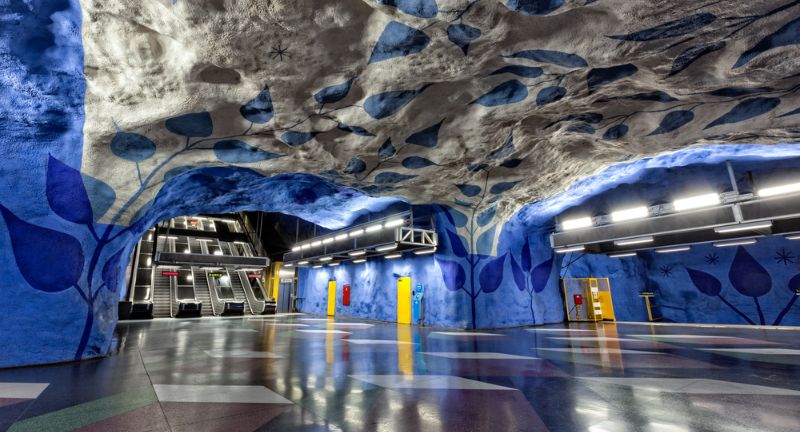
Stockholm metro, Sweden
The Stockholm metro system, inaugurated in 1950, boasts an extensive network of tunnels and is known for its stunning art installations within various stations. The system has evolved over the years and is a testament to Sweden’s commitment to efficient and aesthetically pleasing urban transportation.

Arashiyama Bamboo Grove, Japan
While not a traditional tunnel, the enchanting Bamboo Grove in Arashiyama, Kyoto, features towering bamboo stalks forming a natural canopy. This iconic pathway has historical and cultural significance, attracting visitors who appreciate the serene beauty of this unique “tunnel” environment.

Eisenhower Tunnel, Colorado, USA
Opened in 1973, the Eisenhower Tunnel is a key transportation route through the Colorado Rockies, allowing vehicles to pass beneath the Continental Divide. Named after President Dwight D. Eisenhower, the tunnel spans over 1.7 miles (2.7 km) and facilitates year-round travel across the challenging mountainous terrain.

Channel Tunnel, UK and France
Inaugurated in 1994, the Channel Tunnel, also known as the Eurotunnel or Chunnel, is a remarkable feat of engineering connecting the United Kingdom and France beneath the English Channel. Stretching over 31 miles (50 km), with a significant portion underwater, the tunnel facilitates high-speed rail and vehicle transportation, fostering closer ties between the two nations.
Bund Sightseeing Tunnel, China
Situated in Shanghai, the Bund Sightseeing Tunnel is a unique underwater pedestrian tunnel beneath the Huangpu River. Opened in 2000, it combines colorful light displays and audio effects, offering a mesmerizing journey between the historic Bund and the futuristic Pudong district.
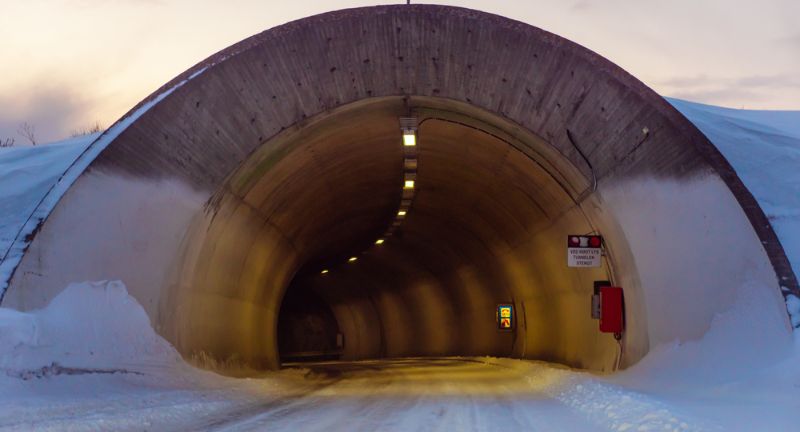
Vardø Tunnel, Norway
Completed in 1982, the Vardø Tunnel is a subsea road tunnel connecting the islands of Vardø and Vardøya in northeastern Norway. Spanning approximately 2.6 miles (4.2 km), it plays a vital role in enhancing connectivity in the remote Arctic region.

The Lærdal Tunnel, Norway
Recognized as the world’s longest road tunnel, the Lærdal Tunnel in Norway stretches over 15.2 miles (24.5 km) and was opened in 2000. Connecting Lærdal and Aurland, the tunnel features illuminated sections to mitigate the psychological impact of its length and enhance the driving experience.

Halnaker Tree Tunnel, England, UK
This enchanting tree-lined tunnel in West Sussex, England, is formed by overarching branches, creating a natural tunnel effect along Halnaker footpath. While not a constructed tunnel, it provides a picturesque and serene pathway, attracting nature enthusiasts and photographers.
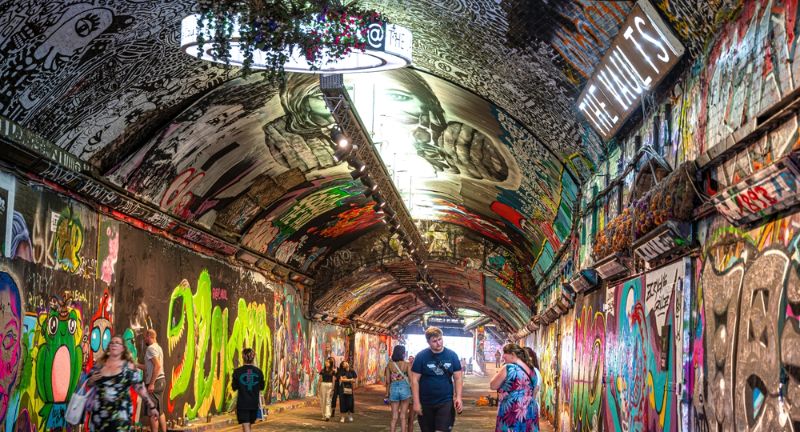
Leake Street Arches, England, UK
Located beneath the railway tracks of Waterloo Station in London, the Leake Street Arches constitute a unique tunnel adorned with vibrant street art. Since the famous “Banksy Tunnel” initiative in 2008, the space has become a legal street art gallery, showcasing an ever-changing display of urban art.
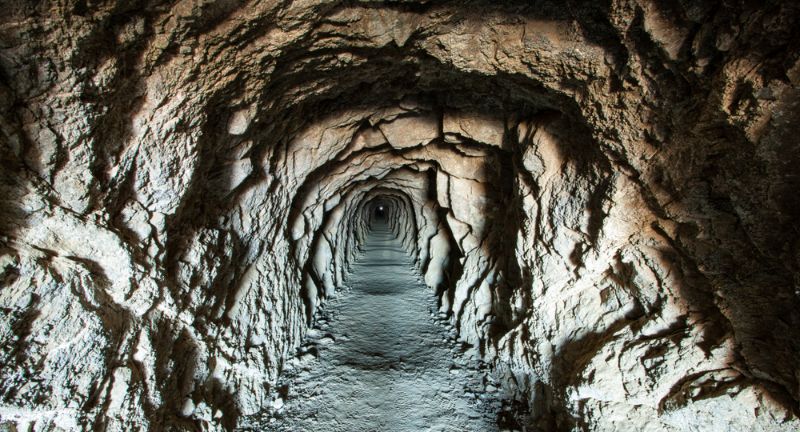
The Burro Schmidt Tunnel, California, USA
Carved by hand over 38 years by William “Burro” Schmidt, this tunnel in the El Paso Mountains of California was a solo endeavor by Schmidt. Completed in 1938, it was intended to be a gold-mining tunnel, but no significant gold deposits were found. The tunnel stands as a testament to Schmidt’s determination and eccentricity.
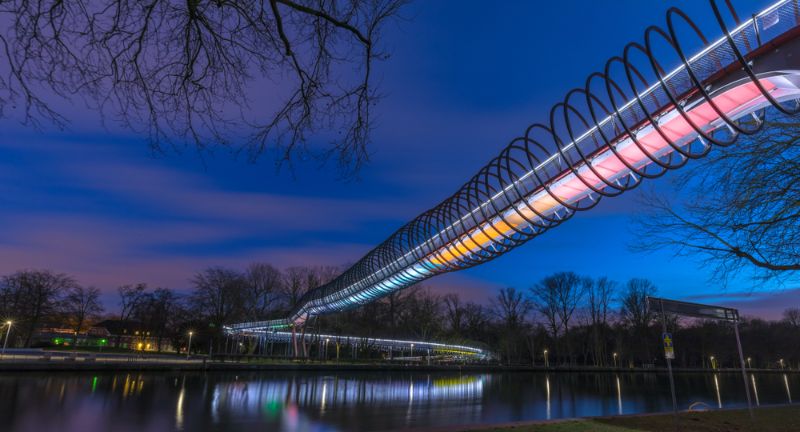
Slinky Springs to Fame, Germany
Completed in 2015, the Slinky Springs to Fame is not a traditional tunnel but a pedestrian bridge with a spiral design resembling a slinky toy. Located in Oberhausen, Germany, it serves both artistic and functional purposes, providing a unique experience for pedestrians and cyclists crossing the Rhine-Herne Canal.
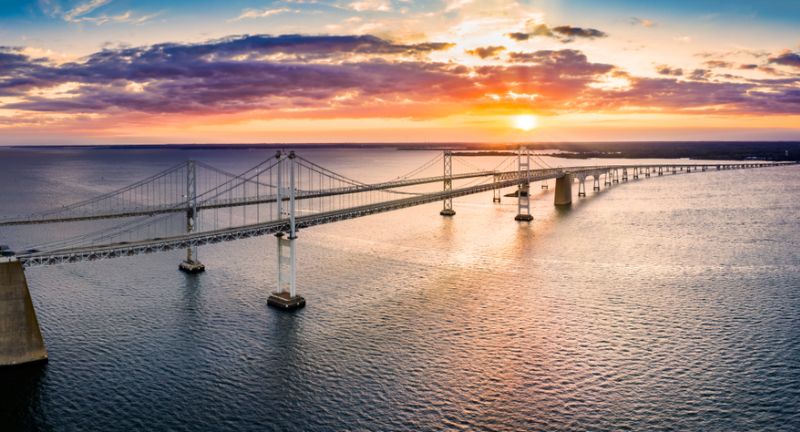
Chesapeake Bay Bridge–Tunnel, Virginia, USA
Opened in 1964, the Chesapeake Bay Bridge–Tunnel is a complex of bridges, tunnels, and causeways connecting Virginia’s Eastern Shore with the mainland. Stretching over 17.6 miles (28.3 km), it is considered one of the world’s longest overwater structures, providing a vital transportation link across the Chesapeake Bay.
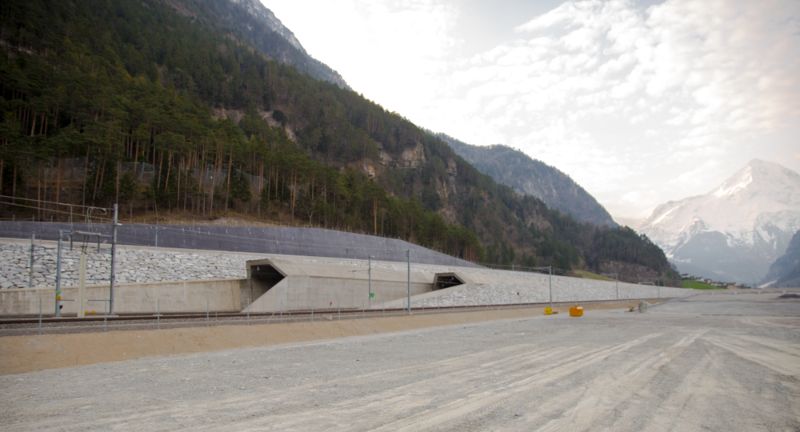
Gotthard Base Tunnel, Switzerland
Inaugurated in 2016, the Gotthard Base Tunnel is the world’s longest and deepest railway tunnel, running through the Swiss Alps. Stretching over 35 miles (57.1 km), it represents a significant engineering achievement, facilitating faster and more efficient rail travel between northern and southern Europe.
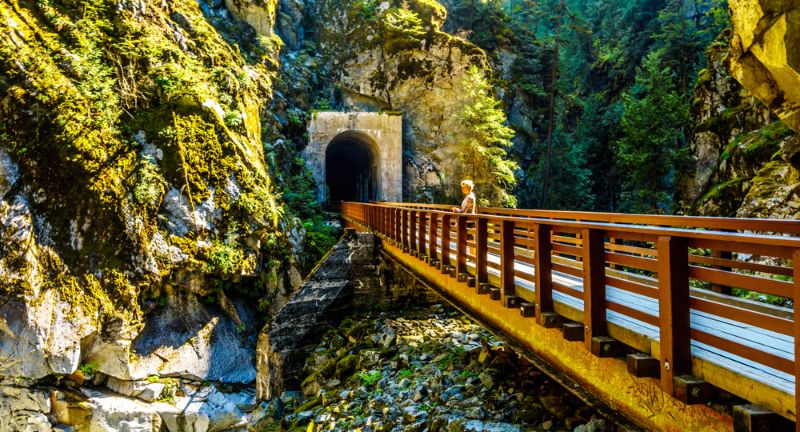
Othello Tunnels, British Columbia, Canada
Originally part of the Kettle Valley Railway, the Othello Tunnels in British Columbia, Canada, were completed in 1916. Named after Shakespeare’s Othello due to their proximity to the town of Hope, the tunnels are now part of a scenic hiking trail through stunning granite canyons.
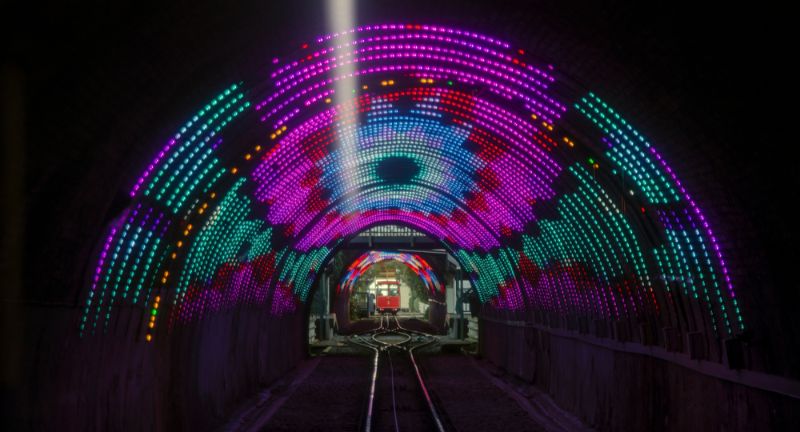
Wellington Cable Car tunnel, New Zealand
Serving as part of the Wellington Cable Car system, this tunnel in New Zealand was opened in 1902, providing a funicular railway link between Lambton Quay and Kelburn. The tunnel is an integral part of Wellington’s public transportation history and offers panoramic views of the city.

Tokyo Bay Aqua Line, Japan
Completed in 1997, the Tokyo Bay Aqua Line is a combination of bridge and tunnel that spans Tokyo Bay, connecting the city of Kawasaki with the Boso Peninsula. The underwater tunnel section provides a seamless link for motorists, significantly reducing travel time between the two areas.
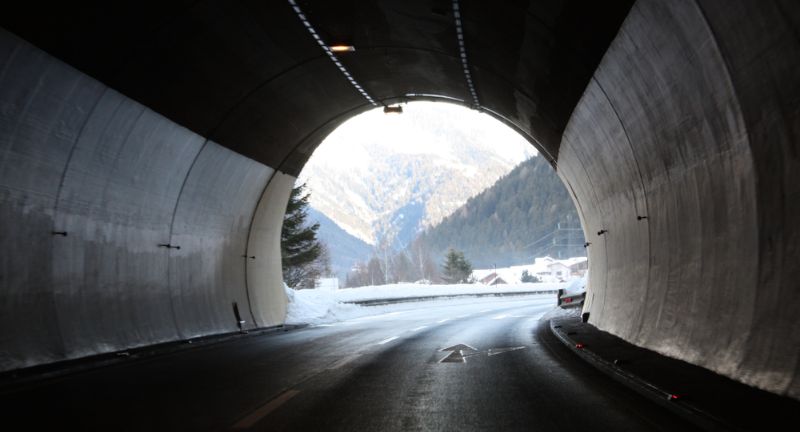
Mont Blanc Tunnel, France and Italy
Opened in 1965, the Mont Blanc Tunnel is a vital transalpine route connecting France and Italy beneath the Mont Blanc mountain. Extending over 7 miles (11.6 km), the tunnel facilitates road travel, playing a crucial role in trans-European transportation.

Combe Laval, France
Combe Laval is a breathtaking mountain road in the French Alps, known for its impressive series of tunnels and galleries. Carved into the rock, the road offers stunning views of the Vercors Massif and is a popular route for cyclists and adventurers.

Road of 52 Tunnels, Italy
Located on the front lines of World War I, the Road of 52 Tunnels in the Dolomites was constructed by Italian troops for military transport. Today, the tunnels, numbering 52 in total, serve as a historic and scenic hiking trail with panoramic views of the surrounding mountains.
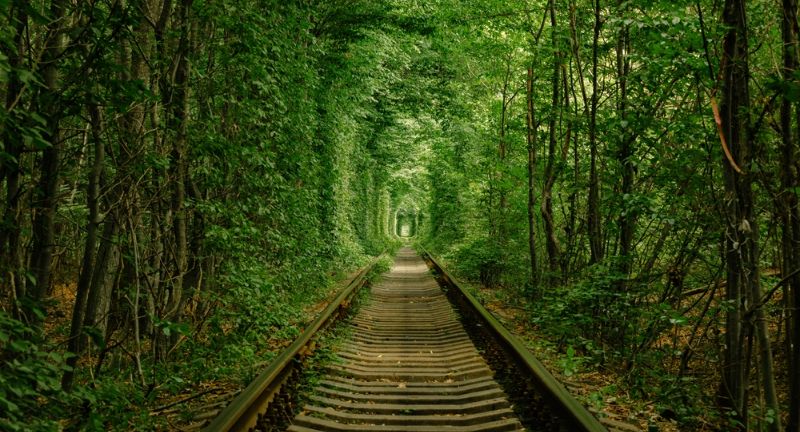
Tunnel of Love, Ukraine
The Tunnel of Love, located near Klevan in Ukraine, is a section of industrial railway that has become famous for its romantic and picturesque setting. Surrounded by green arches formed by trees, the tunnel is a popular spot for couples, especially during the spring and summer months.
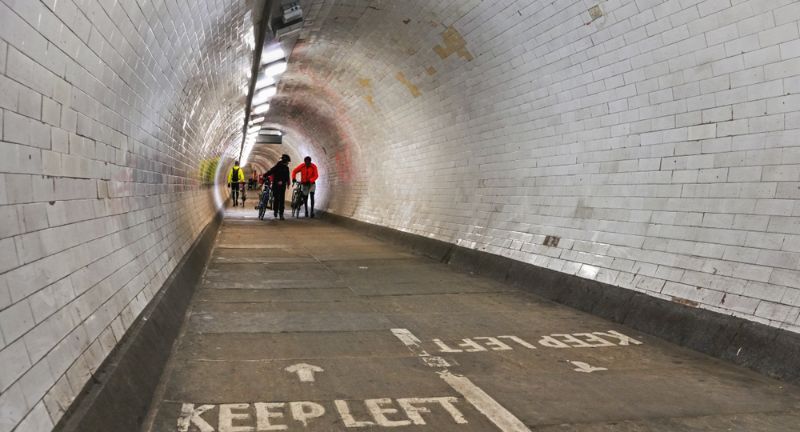
Greenwich Foot Tunnel, London
Opened in 1902, the Greenwich Foot Tunnel is a pedestrian tunnel beneath the River Thames in London, connecting Greenwich and the Isle of Dogs. Originally designed for dockworkers, it now serves as a convenient and historic route for pedestrians and cyclists.
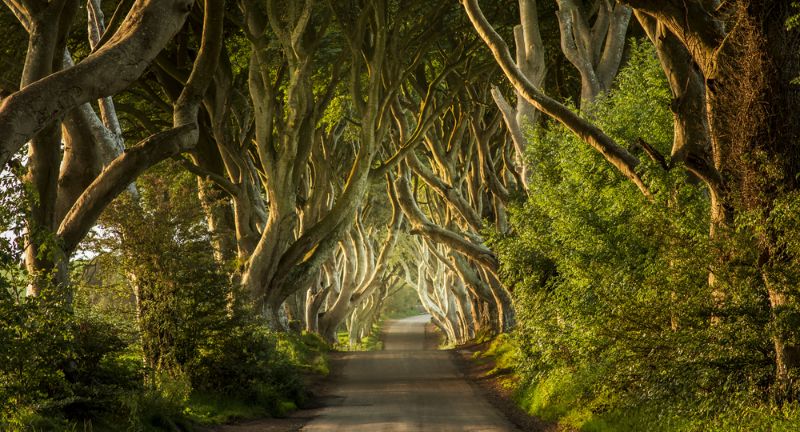
The Dark Hedges, Northern Ireland, UK
While not a tunnel in the traditional sense, the Dark Hedges is a famous tree-lined avenue in Northern Ireland known for its hauntingly beautiful atmosphere. Featured in “Game of Thrones,” the avenue is formed by beech trees creating a natural archway.

Fyllingsdalen tunnel, Norway
Located in Bergen, Norway, the Fyllingsdalen tunnel is a road tunnel completed in 1992, providing a crucial transportation link in the city. With a length of approximately 3.7 miles (6 km), the tunnel contributes to efficient traffic flow in the region.
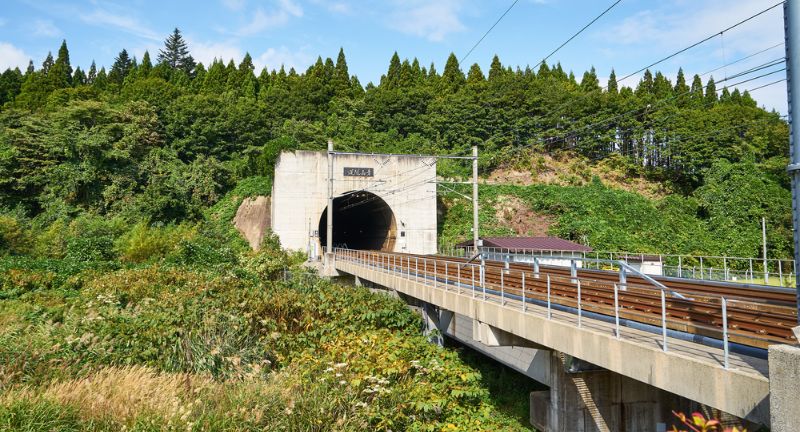
Seikan Tunnel, Japan
Completed in 1988, the Seikan Tunnel is a railway tunnel that runs beneath the seabed of the Tsugaru Strait, connecting Honshu and Hokkaido islands in Japan. Extending over 14.5 miles (23.3 km), it is the second longest tunnel of its kind in the world.
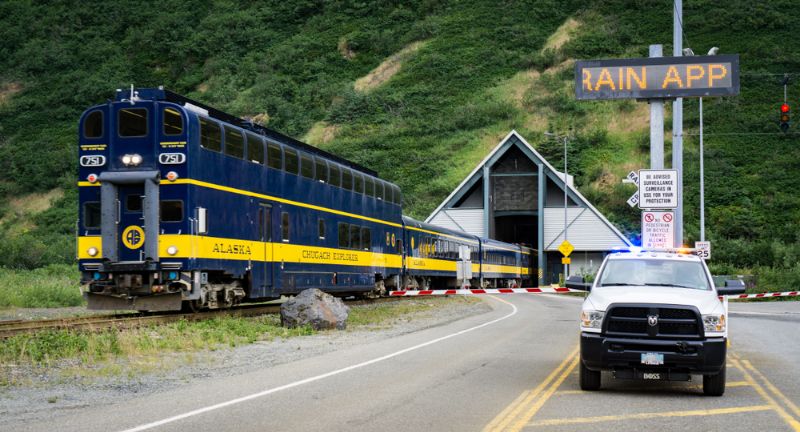
Anton Anderson Memorial Tunnel, Alaska, USA
Originally built as a railway tunnel in 1943 and later converted for road use in 2000, the Anton Anderson Memorial Tunnel in Alaska is the longest combined rail and highway tunnel in North America. It passes through Maynard Mountain and provides access to Whittier.

Detroit Metropolitan Airport Light Tunnel, Michigan, USA
Serving as both an art installation and a transportation corridor, the Light Tunnel at Detroit Metropolitan Airport features a mesmerizing display of colorful lights and music. Completed in 2002, it connects the airport’s Concourse A with the McNamara Terminal.
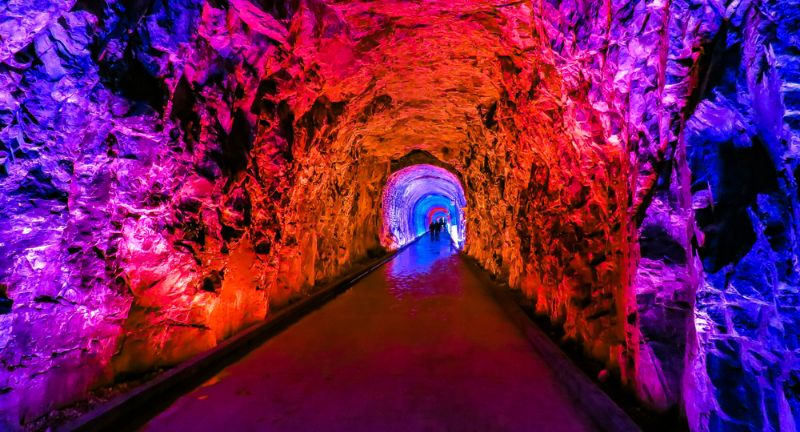
Brockville Railway Tunnel, Canada
Opened in 1860, the Brockville Railway Tunnel in Ontario, Canada, is recognized as the oldest railway tunnel in the country. After years of restoration, it reopened as a tourist attraction in 2017, allowing visitors to explore its historic and architectural significance.

Glow Worm Tunnel, New South Wales, Australia
Originally part of a railway line, the Glow Worm Tunnel in the Wollemi National Park is now a popular walking trail. The tunnel is known for its population of glow worms, creating a magical spectacle for hikers.

Guoliang Tunnel, China
Carved into the Taihang Mountains by villagers, the Guoliang Tunnel in China was completed in 1977. The tunnel, with its rock-cut walls and scenic views, is a testament to the determination and ingenuity of the local community in creating a passage through the mountainous terrain.

Tunel de la Línea, Colombia
Completed in 2006, the Tunel de la Línea is a railway tunnel in Colombia that traverses the Andes Mountains, connecting the cities of Calarcá and Cajamarca. At over 8.6 miles (13.6 km) in length, it is the longest tunnel in Latin America, significantly reducing travel time through the challenging mountainous terrain.
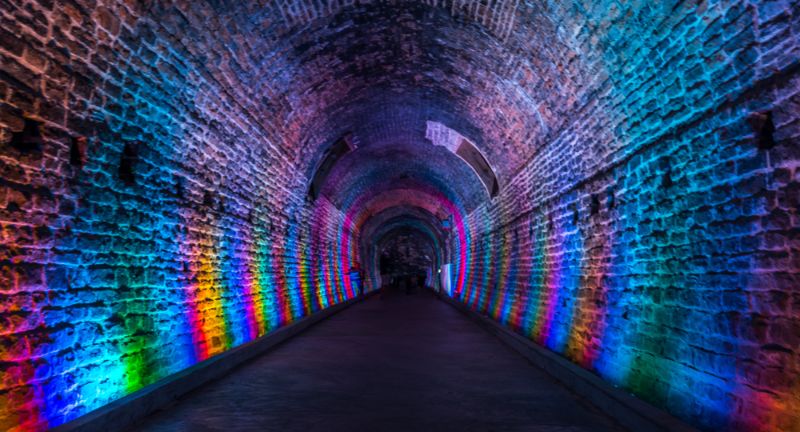
Our exploration of these remarkable tunnels, it becomes evident that these subterranean passages are more than mere conduits; they are threads that weave together stories of innovation, connectivity, and cultural significance. From the ancient roads of Italy with their wartime legacy to the futuristic marvels of Norway’s subsea tunnels, each structure resonates with a tale of human achievement and the ever-evolving relationship between societies and their environments.
As we reflect on these diverse tunnels, it becomes clear that beneath the surface lies a world of inspiration, where engineering, art, and nature converge to shape the narrative of our shared human history.
What To Read Next
- This Genius Trick Every Online Shopper Should Know
- Best High-Yield Savings Accounts This Month
- Best Gold IRA This Year
- Deals On Popular Cruises
- The Best Internet Deals For Seniors
- Affordable Life Insurance Options for Seniors
For the Latest Travel News, Headlines & Videos, head to Bon Voyaged
More for You
CNN political commentator Alice Stewart dies
6 Cars That Are Plummeting in Value
'SNL' star Chloe Fineman to critics of her Cannes look: 'No need to be so mean'
It’s time to bring back the world’s greatest fighter jet – from the 1990s
Beyoncé Is a Total Bombshell in a Ruched Dress With a Gaping Bust Cutout
I'm 70 And I've Lived Alone My Entire Adult Life. Here's What Everyone Gets Wrong About Single People.
Bronny James Measures 3 Inches Shorter At Combine Than USC
Usyk Drops Fury, Becomes Undisputed Champ!
Massive Dell data breach hits 49 million users; what this means for your privacy and security
Dabney Coleman cause of death: Actor who specialized in curmudgeons dies at 92
Rihanna Wears a Sheer Gown and ’90s It Bag on Date With A$AP Rocky
18 Things That Will Happen if 70 Becomes the New Retirement Age in the US
134 funny quotes that will literally make you laugh out loud
Map reveals best places to live in the US if nuclear war breaks out
‘I’m weary of repeating myself’: How do I deal with rich friends who take $22,000 cruises and book $800 hotel rooms? Prices are crazy enough already.
Officer involved in incident that led to Scottie Scheffler's arrest 'did not have body cam footage turned on'
Indiana Fever Coach Calls Caitlin Clark A "Problem" After Third Straight Loss
Emma Stone Wore a Sequin Dress With a Daringly Low Neckline at the Cannes Film Festival
10 Best Supercars Of The 2000s, Ranked
Gen Z Makes Less Than Millennials Did at the Same Age
Press Herald
Account Subscription: ACTIVE
Questions about your account? Our customer service team can be reached at [email protected] during business hours at (207) 791-6000 .
Garden tours, plants sales and more ways to spend time among flowers
Visit Maine's botanical gardens or get a sneak peek of what your neighbors are growing in their back yards.

You are able to gift 5 more articles this month.
Anyone can access the link you share with no account required. Learn more .
With a Press Herald subscription, you can gift 5 articles each month.
It looks like you do not have any active subscriptions. To get one, go to the subscriptions page .
Loading....
One of the loveliest ways to ease yourself fully out of the post-winter blahs and into springtime is to quit being a wallflower and instead surround yourself with living, blooming plants.
From botanical gardens to plant sales and garden tours, it’s time to make like the Scarecrow in “The Wizard of Oz” and while away the hours, conferring with flowers.
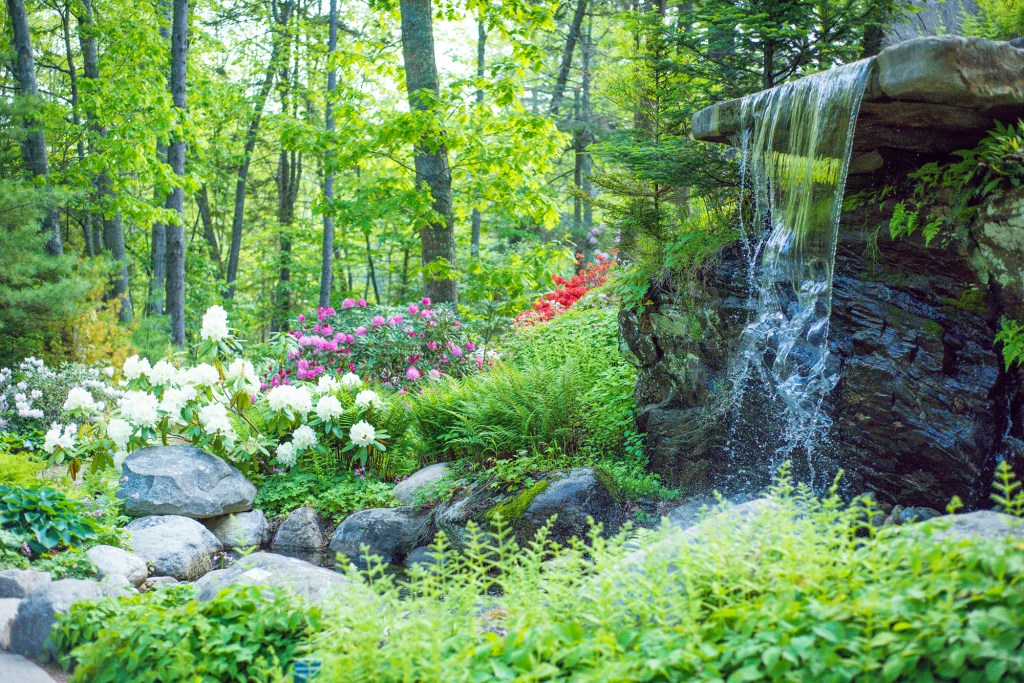
The waterfall at Coastal Maine Botanical Gardens in Boothbay. Photo by Tory Paxson, Courtesy of Coastal Maine Botanical Gardens
TOTALLY BOTANICAL
Coastal Maine Botanical Gardens in Boothbay is open for the season, daily from 9 a.m. to 5 p.m. Maine Days are May 31 to June 2, when anyone with a Maine driver’s license or state ID gets in for free. Ditto for dads/father figures on Father’s Day (June 16). Advance registration is required. With more than 300 acres of gardens and natural spaces, including a waterfall, there will be plenty to see, smell and bask in the scenery.
Here are more things to do in Boothbay
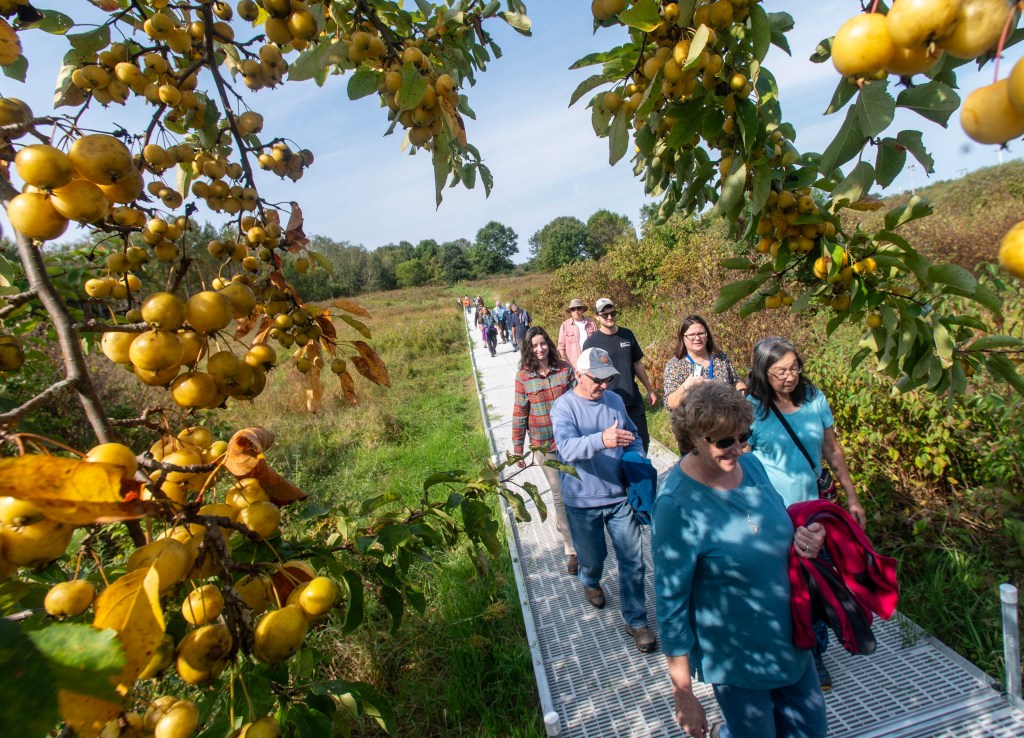
A tour group walks on the boardwalk at Viles Arboretum in Augusta. Joe Phelan/Kennebec Journal
Viles Arboretum is a botanical garden in Augusta with 6 miles of trails and more than 20 botanical collections. It’s open daily from sunrise to sunset, and admission is free. There are 224 acres with all sorts of flora and fauna to discover. Leashed dogs are welcome, and the visitor center is open from 10:30 a.m. to 4:30 p.m. Wednesday through Saturday.
Viles Arboretum offers medicinal plant walks, and although the May 18 session is full, you can still register for the June 15 and Sept. 14 events, lead by herbalist, homeopath and flower essence practitioner Debra Bluth. Tickets are $25. Advertisement
The Mount Desert Land & Garden Preserve has four areas to explore on its property in Northeast Harbor: the Asticou Azelea Garden (dawn to dusk daily), the Abby Aldrich Rockefeller Garden (noon to 4 p.m. Tuesday through Sunday from July 9 to Sept. 8, reservations required), Thuya Garden (dawn to dusk daily, June 15 to Oct. 14) and Little Long Pond Natural Lands (hiking trails and carriage roads open dawn to dusk daily). On June 26, at the Wildflowers of Little Long Pond event, participants can wander around the garden’s fields and forest, spotting wildflowers along the way while practicing how to identify them.
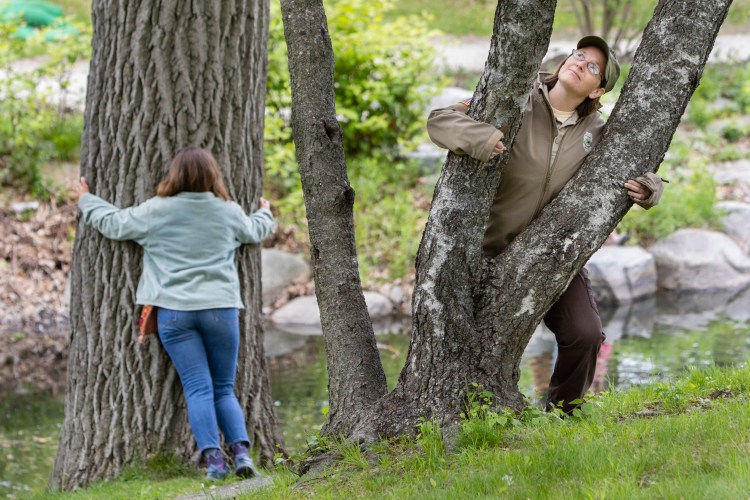
Joyce Saltman, right, and Beth Anisbeck embrace a tree for 60 seconds during a tree hugging event sponsored by Portland Parks and Recreation, at Deering Oaks Park last year. Carl D. Walsh/Staff Photographer
TOURS AND MORE
2nd Annual Tree Hugging 11 a.m. to 1 p.m. Saturday. Deering Oaks Park, Portland. portlandmaine.gov The tree hugging is a family-friendly community gathering to celebrate Portland’s many trees. Park ranger Liz Collado will lead a sensory awakening and forest bathing session. Along with tree hugging, there will be a storytime, and you can touch a forestry truck and meet naturalist Noah Querido and Portland city arborist Mark Reiland. Just down the road, you’ll find Fessenden Park, on the corner of Brighton and Deering Avenues. The tulips have arrived, and it’s worth a visit to see them.
McLaughlin Garden Lilac Festival 10 a.m. to 4 p.m. May 24. McLaughlin Garden and Homestead, 97 Main St., South Paris, $5. mclaughlingardens.org You’ll find more than 125 varieties of lilacs at the McLaughlin Garden Lilac Festival. Explore on your own or take a guided tour led by a horticulturist. There will also be family-friendly activities, and you can shop for native and unusual plants.
4th annual Woodfords Community Garden Tour 1-4 p.m. June 8. Woodfords Corner Community in Back Cove, Deering Highlands, Oakdale and Deering Center, $20 suggested donation. woodfordscorner.org Presented by Friends of Woodfords Corner, this self-guided tour features at least 10 gardens. As you make your way down the list, you’ll find yourself pleasantly surprised by all of the hidden havens bursting with flowers, plants and impressive yardscaping elements.
Peony Society of Maine 23rd annual Garden Tour 10 a.m. to 3 p.m. June 8 and 15. Both tours start at 1348 Ohio St., Bangor, $5 donation. peonysocietyofmaine.net You’ll visit multiple gardens in Bangor, Winterport, Ripley and St. Albans, and your senses will be filled with countless peonies. A peony plant will be raffled off at the end of each tour. Advertisement
Hidden Gardens of Historic Bath 10 a.m. to 2 p.m. June 22. Sagadahoc Preservation Inc., 880 Washington St., Bath, $40. sagadahocpreservation.org The Hidden Gardens of Historic Bath house and garden tour features several homes in North Bath. Every stop on the tour will be a treat for your senses and may motivate you to make some of your own magic when you get back home.
Garden Conservancy Open Garden Days 10 a.m. to 4 p.m. June 29. Beckett Castle Rose Garden, Singles Road, Cape Elizabeth, $10. gardenconservancy.org You’ll see plenty of roses as well as ocean views at Beckett Castle, which sits right on the water, with views of five lighthouses. The castle was built in 1871, and its rose garden features more than 70 varieties of heirloom roses. A 50-foot stone tower doubles as the rose arbor entrance to the castle.
PICK A PLANT SALE
Tate House Museum’s Annual Plant and Herb Sale 9 a.m. to 1 p.m. May 18. Tate House Museum, 1267 Westbrook St., Portland, 207-774-6177. tatehouse.org The wide selection includes perennials divided from the museum’s 18th century reproduction garden. Visitors can also make their own “seed bombs” and get a sneak peak at a new installation by artist Ashley Page from 10 a.m. to noon.
Animal Refuge League of Greater Portland Spring Plant S ale 9 a.m. to 11 a.m. May 18, Animal Refuge League of Greater Portland, 217 Landing Road, Westbrook, 207-854-9771. arlgp.org Perennials, house plants and more will be on sale, and plants that don’t have specific pricing are “name your own fee.” Anyone interested in donating plants or pots to the sale should send a message to [email protected] .
Taking Root Plant Sale 9 a.m. to 1 p.m. June 1, Tom Settlemire Community Garden, Maurice Drive, Brunswick, 207-729-7694. btlt.org This annual sale is organized by the Brunswick-Topsham Land Trust. Proceeds benefit the Common Good Garden, which provides food and gardening education for the Mid Coast Hunger Prevention Program. Master gardeners will be on hand to help shoppers choose their best options.
Scarborough Land Trust Native Plant Sale and Spring Festival 9 a.m. to 1 p.m. June 1, Broadturn Farm, 388 Broadturn Road, Scarborough, 207-289-1199. scarboroughlandtrust.org Visitors will find native plants, food vendors, local artisans, guided nature walks and activities for kids. To preorder plants, visit the Scarborough Land Trust website.
Maine Audubon Society Native Plants Sale and Festival 9 a.m. to 3 p.m., June 8, Gilsland Farm Audubon Center, 20 Gilsland Farm Road, Falmouth, 207-781-2330. maineaudubon.org More than 75 species of native wildflowers, shrubs and tree seedlings will be available, along with workshops, info tables and experts.
Staff writer Megan Gray contributed to this report.
Related Headlines
Headed to Coastal Maine Botanical Gardens? Here’s what else to check out in Boothbay
Success. Please wait for the page to reload. If the page does not reload within 5 seconds, please refresh the page.
Enter your email and password to access comments.
Forgot Password?
Don't have a commenting profile? Create one.
Hi, to comment on stories you must create a commenting profile . This profile is in addition to your subscription and website login. Already have a commenting profile? Login .
Invalid username/password.
Please check your email to confirm and complete your registration.
Create a commenting profile by providing an email address, password and display name. You will receive an email to complete the registration. Please note the display name will appear on screen when you participate.
Already registered? Log in to join the discussion.
Only subscribers are eligible to post comments. Please subscribe or login first for digital access. Here’s why .
Use the form below to reset your password. When you've submitted your account email, we will send an email with a reset code.
Send questions/comments to the editors.
Member Log In
Please enter your username and password below. Already a subscriber but don't have one? Click here .
Not a subscriber? Click here to see your options
UK Edition Change
- UK Politics
- News Videos
- Paris 2024 Olympics
- Rugby Union
- Sport Videos
- John Rentoul
- Mary Dejevsky
- Andrew Grice
- Sean O’Grady
- Photography
- Theatre & Dance
- Culture Videos
- Fitness & Wellbeing
- Food & Drink
- Health & Families
- Royal Family
- Electric Vehicles
- Car Insurance Deals
- Lifestyle Videos
- UK Hotel Reviews
- News & Advice
- Simon Calder
- Australia & New Zealand
- South America
- C. America & Caribbean
- Middle East
- Politics Explained
- News Analysis
- Today’s Edition
- Home & Garden
- Broadband deals
- Fashion & Beauty
- Travel & Outdoors
- Sports & Fitness
- Sustainable Living
- Climate Videos
- Solar Panels
- Behind The Headlines
- On The Ground
- Decomplicated
- You Ask The Questions
- Binge Watch
- Travel Smart
- Watch on your TV
- Crosswords & Puzzles
- Most Commented
- Newsletters
- Ask Me Anything
- Virtual Events
- Betting Sites
- Online Casinos
- Wine Offers
Thank you for registering
Please refresh the page or navigate to another page on the site to be automatically logged in Please refresh your browser to be logged in
Norwegian Cruise Line to launch a nude cruise for 2025 – and these are the rules for passengers
The ‘big nude boat’ will take passengers around private islands and long-time tourist favourites such as the bahamas, article bookmarked.
Find your bookmarks in your Independent Premium section, under my profile
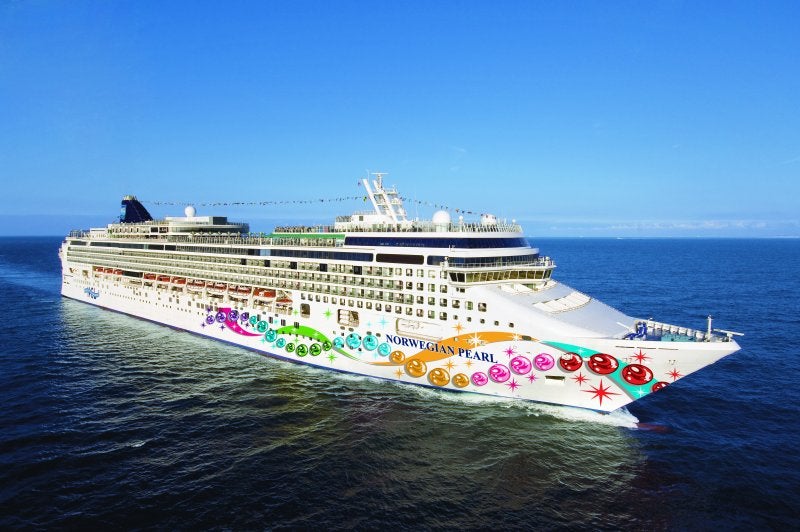
Sign up to Simon Calder’s free travel email for expert advice and money-saving discounts
Get simon calder’s travel email, thanks for signing up to the simon calder’s travel email.
A specialist tour and travel company has partnered with Norwegian Cruise Line to launch a new nudist cruise to the Caribbean .
Bare Necessities, a nudist travel company that aims to “break down the barriers against social nudity and make clothing-optional vacationing a viable and acceptable option”, has teamed up with the well-known cruise operator to set up the 11-day trip, which leaves from Miami and takes in destinations including The Bahamas , St Lucia, Dominica and Puerto Rico.
The cruise, which will take place on Norwegian’s 295-foot 2,300-person capacity Norwegian Pearl , will set sail on 3 February 2025 and return on 14 February.
Prices start at $2,000 (£1,592) per person for a standard two-person cabin, rising to $33,155 (£26,400) for a three-person ‘garden villa’.
The trip is marketed as “an 11-Day adventure back to Bare-adise”, offering “a wide range of amenities to fit everyone’s style of bare cruising”. The Norwegian Pearl contains “loads of entertainment, lots of open deck space, and multiple dining options”, including 14 restaurants, 14 bars and “a large buffet area for nude outdoor dining”, in addition to a casino, spa and several “nightspots”.
“As always, it’s our pleasure to provide you with the luxury of deciding what NOT to wear”, reads a final message on the information page.
However, it isn’t an entirely clothing-free experience. Cruise rules require passengers to be clothed during the Captain’s reception and introduction, while docked in port, and at all times in the main and specialty dining rooms.
Other rules include putting a towel down before sitting “in the stateroom, pool deck, and buffet area”, as well as a ban on “being nude in front of other ships in port” and “fondling or inappropriate touching”. A message on the site urges passengers to “use common sense”, emphasising that proper cruise etiquette “is not any different from proper etiquette in any other social situation”.
In a statement to CNN , a Bare Necessities spokesperson said: “Our mission is to provide relaxing, entertaining and health-conscious vacation opportunities that offer non-threatening, natural environments where the appreciation, wonder and compatibility of nature and the unadorned human form can occur.”
The Independent has contacted Bare Necessities for comment.
Join our commenting forum
Join thought-provoking conversations, follow other Independent readers and see their replies
Subscribe to Independent Premium to bookmark this article
Want to bookmark your favourite articles and stories to read or reference later? Start your Independent Premium subscription today.
New to The Independent?
Or if you would prefer:
Want an ad-free experience?
Hi {{indy.fullName}}
- My Independent Premium
- Account details
- Help centre
- Skip to main content
- Keyboard shortcuts for audio player
The huge solar storm is keeping power grid and satellite operators on edge

Geoff Brumfiel
Willem Marx

NASA's Solar Dynamics Observatory captured this image of solar flares early Saturday afternoon. The National Oceanic and Atmospheric Administration says there have been measurable effects and impacts from the geomagnetic storm. Solar Dynamics Observatory hide caption
NASA's Solar Dynamics Observatory captured this image of solar flares early Saturday afternoon. The National Oceanic and Atmospheric Administration says there have been measurable effects and impacts from the geomagnetic storm.
Planet Earth is getting rocked by the biggest solar storm in decades – and the potential effects have those people in charge of power grids, communications systems and satellites on edge.
The National Oceanic and Atmospheric Administration says there have been measurable effects and impacts from the geomagnetic storm that has been visible as aurora across vast swathes of the Northern Hemisphere. So far though, NOAA has seen no reports of major damage.

The Picture Show
Photos: see the northern lights from rare, solar storm.
There has been some degradation and loss to communication systems that rely on high-frequency radio waves, NOAA told NPR, as well as some preliminary indications of irregularities in power systems.
"Simply put, the power grid operators have been busy since yesterday working to keep proper, regulated current flowing without disruption," said Shawn Dahl, service coordinator for the Boulder, Co.-based Space Weather Prediction Center at NOAA.
NOAA Issues First Severe Geomagnetic Storm Watch Since 2005

- LISTEN & FOLLOW
- Apple Podcasts
- Google Podcasts
- Amazon Music
- Amazon Alexa
Your support helps make our show possible and unlocks access to our sponsor-free feed.
"Satellite operators are also busy monitoring spacecraft health due to the S1-S2 storm taking place along with the severe-extreme geomagnetic storm that continues even now," Dahl added, saying some GPS systems have struggled to lock locations and offered incorrect positions.
NOAA's GOES-16 satellite captured a flare erupting occurred around 2 p.m. EDT on May 9, 2024.
As NOAA had warned late Friday, the Earth has been experiencing a G5, or "Extreme," geomagnetic storm . It's the first G5 storm to hit the planet since 2003, when a similar event temporarily knocked out power in part of Sweden and damaged electrical transformers in South Africa.
The NOAA center predicted that this current storm could induce auroras visible as far south as Northern California and Alabama.
Extreme (G5) geomagnetic conditions have been observed! pic.twitter.com/qLsC8GbWus — NOAA Space Weather Prediction Center (@NWSSWPC) May 10, 2024
Around the world on social media, posters put up photos of bright auroras visible in Russia , Scandinavia , the United Kingdom and continental Europe . Some reported seeing the aurora as far south as Mallorca, Spain .
The source of the solar storm is a cluster of sunspots on the sun's surface that is 17 times the diameter of the Earth. The spots are filled with tangled magnetic fields that can act as slingshots, throwing huge quantities of charged particles towards our planet. These events, known as coronal mass ejections, become more common during the peak of the Sun's 11-year solar cycle.
A powerful solar storm is bringing northern lights to unusual places
Usually, they miss the Earth, but this time, NOAA says several have headed directly toward our planet, and the agency predicted that several waves of flares will continue to slam into the Earth over the next few days.
While the storm has proven to be large, predicting the effects from such incidents can be difficult, Dahl said.
Shocking problems
The most disruptive solar storm ever recorded came in 1859. Known as the "Carrington Event," it generated shimmering auroras that were visible as far south as Mexico and Hawaii. It also fried telegraph systems throughout Europe and North America.

Stronger activity on the sun could bring more displays of the northern lights in 2024
While this geomagnetic storm will not be as strong, the world has grown more reliant on electronics and electrical systems. Depending on the orientation of the storm's magnetic field, it could induce unexpected electrical currents in long-distance power lines — those currents could cause safety systems to flip, triggering temporary power outages in some areas.
my cat just experienced the aurora borealis, one of the world's most radiant natural phenomena... and she doesn't care pic.twitter.com/Ee74FpWHFm — PJ (@kickthepj) May 10, 2024
The storm is also likely to disrupt the ionosphere, a section of Earth's atmosphere filled with charged particles. Some long-distance radio transmissions use the ionosphere to "bounce" signals around the globe, and those signals will likely be disrupted. The particles may also refract and otherwise scramble signals from the global positioning system, according to Rob Steenburgh, a space scientist with NOAA. Those effects can linger for a few days after the storm.
Like Dahl, Steenburgh said it's unclear just how bad the disruptions will be. While we are more dependent than ever on GPS, there are also more satellites in orbit. Moreover, the anomalies from the storm are constantly shifting through the ionosphere like ripples in a pool. "Outages, with any luck, should not be prolonged," Steenburgh said.

What Causes The Northern Lights? Scientists Finally Know For Sure
The radiation from the storm could have other undesirable effects. At high altitudes, it could damage satellites, while at low altitudes, it's likely to increase atmospheric drag, causing some satellites to sink toward the Earth.
The changes to orbits wreak havoc, warns Tuija Pulkkinen, chair of the department of climate and space sciences at the University of Michigan. Since the last solar maximum, companies such as SpaceX have launched thousands of satellites into low Earth orbit. Those satellites will now see their orbits unexpectedly changed.
"There's a lot of companies that haven't seen these kind of space weather effects before," she says.
The International Space Station lies within Earth's magnetosphere, so its astronauts should be mostly protected, Steenburgh says.
In a statement, NASA said that astronauts would not take additional measures to protect themselves. "NASA completed a thorough analysis of recent space weather activity and determined it posed no risk to the crew aboard the International Space Station and no additional precautionary measures are needed," the agency said late Friday.

People visit St Mary's lighthouse in Whitley Bay to see the aurora borealis on Friday in Whitley Bay, England. Ian Forsyth/Getty Images hide caption
People visit St Mary's lighthouse in Whitley Bay to see the aurora borealis on Friday in Whitley Bay, England.
While this storm will undoubtedly keep satellite operators and utilities busy over the next few days, individuals don't really need to do much to get ready.
"As far as what the general public should be doing, hopefully they're not having to do anything," Dahl said. "Weather permitting, they may be visible again tonight." He advised that the largest problem could be a brief blackout, so keeping some flashlights and a radio handy might prove helpful.
I took these photos near Ranfurly in Central Otago, New Zealand. Anyone can use them please spread far and wide. :-) https://t.co/NUWpLiqY2S — Dr Andrew Dickson reform/ACC (@AndrewDickson13) May 10, 2024
And don't forget to go outside and look up, adds Steenburgh. This event's aurora is visible much further south than usual.
A faint aurora can be detected by a modern cell phone camera, he adds, so even if you can't see it with your eyes, try taking a photo of the sky.
The aurora "is really the gift from space weather," he says.
- space weather
- solar flares
- solar storm

IMAGES
COMMENTS
March to May and September to November are the best times for quiet roads. With so much going on in summer and winter, Norway falls relatively quiet during the spring and fall months. And therein lies the appeal of visiting at this time. Beyond city limits, Norway's roads are quieter by a near-exponential magnitude.
Daylight: 8 to 13 hours in Oslo, 10 to 14 hours in Tromso. March and April are some of the best months to visit Norway for travellers who want to make the most of both the winter and spring seasons. The winter snow slowly starts to melt by mid to late March and most bodies of water are filled with fresh water.
Norway is a stunning destination with diverse attractions, from the northern lights to the majestic fjords. But when is the best time to visit this Nordic country? Travel experts share their tips ...
Spring in Norway: Sunny, but chilly days with snow in the mountains. We regard March, April and May as the official spring months in Norway, and this is actually a very nice time to visit.. Some of the benefits of visiting during the spring is that you will be able to experience all the good thing about the winter by going up to the mountains, while the lowlands will be more temperate, and you ...
When to go to Norway is a common question among first-time Norway travelers. The best time to go to Norway suitable for most travelers is early summer, especially the months of June and July. The weather is pleasant and the days are long however it is also peak season. The other seasons offer plenty to do, though it can be cold and days are ...
October: Autumn colours by day and good chance of northern lights by night, as long as the weather is on your side. Expect rain. Very few international tourists. A good time to visit the cities. November: Winter arrives but there's usually very little snow outside the mountains.
The best time visit Norway is summer (June-August). It promises long, light days and warmer temperatures - but no guarantee of heat, even if it won't be cold. However, the best time to go to Norway also depends on what you want to do. May and September offer gorgeous colours in nature, while November-March is for snow and Northern Lights ...
Best time to travel to the Norway fjords. The Norwegian fjords are amongst the most beautiful in the world. It is no wonder that the West Norwegian Fjords, Geirangerfjord and Nærøyfjord, are listed as one of Norway's UNESCO World Heritage Sites.Picture tranquil waters, thundering waterfalls, and sheer mountain faces.
The best time to visit Norway in the northern region is in the fall, which brings thinner crowds, cooler weather between 41°F to 50°F, and glorious foliage. The best time to visit Norway in the southern region is between May and August, when the days are long, the landscapes are green, and the weather is warm, between 61°F and 72°F.
The best time to visit Norway in the northern region is in the autumn, which brings thinner crowds, cooler weather between 5°C to 10°C, and glorious foliage. The best time to visit Norway in the southern region is between May and August, when the days are long, the landscapes are green, and the weather is warm, between 16°C and 22°C.
Weather is far too cold this time of year in Norway to be enjoyable for warm weather travelers. The average high during this season is between 36.1°F (2.3°C) and 29.2°F (-1.6°C). On average, it rains or snows a fair amount: 4 to 6 times per month. These times of year are fairly slow with tourists. Best Times to Travel › Norway
It really varies so much, but by mid-September the country starts to look quite orange. September is the best time to go to Norway if you want fall colors, mountain hikes, no crowds, mild temperatures, and if you're in the north, a chance to chase the Northern Lights without worrying about snowy roads. If you want to see the Northern Lights ...
See our selection of trusted companies that work hard to make you happy all through your trip. Stunning fjords. Cosy, compact cities. Magical northern lights. Plan your trip, discover great offers, and read our insider guides and inspiring feature articles about people, places and our quirky traditions. So that you get the most out of your trip!
She has visited hundreds of destinations and has lived in 7 different countries. Cory is multilingual and an alumna from The University of Manchester. Norway Itinerary: Day 1 - Oslo to Lillehammer, Day 2 - Dombås, Day 3 - Trondheim, Day 4 - Atlantic Road, Day 5 - Valldal, Day 6 - Olden.
Norway is stacked with superlatives — it's the most mountainous, most scenic, and most prosperous of all the Scandinavian countries. Perhaps above all, Norway is a land of intense natural beauty, its famously steep mountains and deep fjords carved out and shaped by an ancient ice age. On a sunny day, Norway exudes an "I could live here" appeal like no place else.
Norway stretches from 57° to 78° north, so the climate varies a lot. There are great variations between north, south, inland and coast. In general, coastal areas have relatively mild and wet winters (but with snow in the mountains), while the inland regions have cold winters with plenty of snow, and hot and relatively dry summers, especially ...
5. Norway is a Safe Country to Visit. Norway is known to be one of the safest countries in the world. Crime rates are extremely low even in major cities such as Oslo, Bergen, Trondheim, and Stavanger . As with any other urban areas, you should take certain precautions but there's not much to be afraid of.
What to do in Oslo on Arrival Day. Day 1: Explore Oslo. Day 2: Explore Oslo. Day 3: Oslo to Bergen via Scenic Bergen Railway | Explore Bergen. Day 4: Bergen to Odda via Rental Car | Hardangerfjord Cruise. Day 5: Hike Trolltunga. Day 6: Odda to Flåm via Rental Car | Flåm Railway | Nærøyfjord Cruise.
For anyone interested in such, its panels and events make it a good time to visit. For me, having spent six years in Scandinavia, and long summers and winters in Norway, Oslo became a base for ...
I just bought your Southern Norway Travel Guide, which is very helpful, but now I'm torn between two itineraries, so I thought that you might be able to help. I arrive at Oslo and I will be using public transportation. 1) A version of your public transportation itinerary for 11 days. Day 1: Oslo - Roros Day 2: Roros - Trondheim
Call us in Washington, D.C. at 1-888-407-4747 (toll-free in the United States and Canada) or 1-202-501-4444 (from all other countries) from 8:00 a.m. to 8:00 p.m., Eastern Standard Time, Monday through Friday (except U.S. federal holidays). See the State Department's travel website for the Worldwide Caution and Travel Advisories.
First time in Norway. May 10, 2024, 1:22 AM. Hi, So we are planning a trip to Norway in September/October. We are looking at spending three nights in Oslo, catch the train to Bergen, three nights in Bergen, then fly to Tromso for four nights to chase northern lights. We like scenery, easy hiking, and generally exploring cities on foot.
The best time visit Norway is summer (June-August). It promises long, light days and warmer temperatures - but no guarantee of heat, even if it won't be cold. However, the best time to go to Norway also depends on what you want to do. May and September offer gorgeous colours in nature, while November-March is for snow and Northern Lights ...
This guide provides ten invaluable tips to help first-time cruisers navigate the specifics of a Norwegian cruise. From choosing the best cruise line for you, to practical advice on packing and port research, read on for my best advice. 1. Choose Your Cruise Line Carefully. Because most major lines offer at least a few Norway itineraries ...
Discovering the world's most intriguing and diverse tunnels offers a journey through time, geography, and human ingenuity. From the depths of Norway's subsea marvels to the enchanting bamboo ...
Maine Audubon Society Native Plants Sale and Festival. 9 a.m. to 3 p.m., June 8, Gilsland Farm Audubon Center, 20 Gilsland Farm Road, Falmouth, 207-781-2330. maineaudubon.org. More than 75 species ...
The cruise, which will take place on Norwegian's 295-foot 2,300-person capacity Norwegian Pearl, will set sail on 3 February 2025 and return on 14 February. Prices start at $2,000 (£1,592) per ...
The huge solar storm is keeping power grid and satellite operators on edge. NASA's Solar Dynamics Observatory captured this image of solar flares early Saturday afternoon. The National Oceanic and ...